Cerulean Seas by Fossilized Rappy
Introduction
Original SA post
Rather than head straight into Nyambe when I don't actually have any of the sourcebooks past the first on-hand, I decided I'd finish the little d20 system trifecta I've unintentionally had going. A d20 Modern review, a D&D review, and now, a Pathfinder review. Is it going to be the Pathfinder Bestiary 2 review I mentioned I wanted to try out before?
No, we're going to be doing something third party. Something that is
good
third party, at that. Something involving adventure, excitement, heavy environmental rules, and this guy!
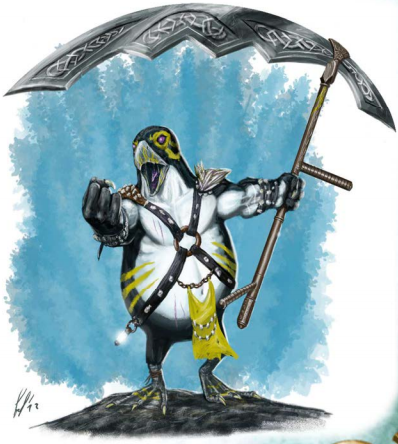
How can you possibly dislike a campaign setting that has that guy in it?
The name of this Pathfinder campaign setting is Cerulean Seas, and with this post we'll be getting our feet wet with this brief introductory dip.

Introduction
The Cerulean Seas Campaign Setting was released by Alluria Publishing in 2010, which is fairly early in Pathfinder's life as far as a whole campaign setting release goes. This is explained by the fact that, by the authors' own admission, the earliest drafts of Cerulean Seas happened in 2000, all the way back with Dungeons and Dragons 3.0. That's a lot of dedication to one idea, and it certainly shows.
The premise of Cerulean Seas is a simple but effective one. There was a bygone age when great expanses of land called continents existed, and they were ruled by strange creatures known as land elves, humans, dwarves, and gnomes. These beings, the "drylanders", had a great age of peace where a magnificent city in the clouds kept evil at bay with its heavenly forces. One dark day, however, the Cloud City fell from the sky, and the drylanders turned against the gods. They sealed the ancient portals that had unknowingly been the balance between the elements, and with those portals sealed the land was engulfed by the ocean in a cataclysmic flood. This just so happened to stop the bloody wars that had been happening unseen beneath the waves and forced the sea-dwellers to adopt new homes as their traditional waters became deeper and deeper beneath the surface.
The world after the Great Flood is one ruled by the beast-tailed merfolk, the animalistic anthropomorphs, and the magical feykith. The eponymous region, the Cerulean Seas, were a great bay before Cloud City crashed into it and the Great Flood turned it from a bay to a shallow region of the vast world-ocean. While this is assumed to be the primary area of play, further sourcebooks will also detail the frozen reaches of far-off Isinblare and the deepest trenches of the abyssal plain. That's for the future, however. Next update, we'll start reading the Cerulean Seas Campaign Setting with its first two chapters: a chunky collection of ocean-related rules, followed by the races that rule the Cerulean Seas.
"Let me tell you about oceanic topography..."
Original SA post
Part 1: "Let me tell you about oceanic topography..."
Welcome to the first actual meaty post of the Cerulean Seas Campaign Setting. And what a place to start, as the first two chapters are quite prominent ones.
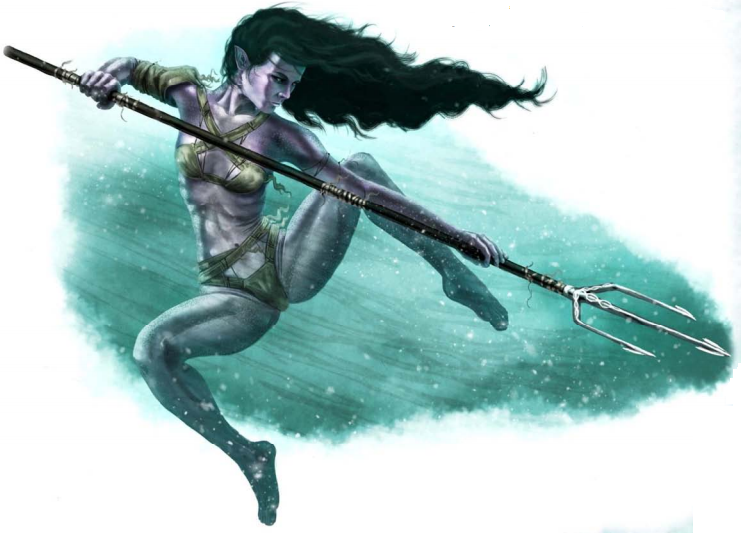
Environmental Basics
This is pretty much "everything you ever wanted to know about the ocean in a d20 context". The first few are mostly just refreshers on oceanography 101, like tides, the topography of trenches and mountains beneath the waves, and just how much standard vision/low-light vision/darkvision can see in the ocean's light zones. But then we get to the first big one: buoyancy. This is basically item encumbrance, but underwater. Every creature and playable race has a racial buoyancy modifier, which you compare to the total buoyancy of the equipment being carried to determine positive, negative, or neutral buoyancy. A character whose equipment gives them a negative Buoyancy score has to fight to avoid sinking, while a character that is getting positive buoyancy has to fight to avoid heading towards the surface. This speed starts at 10 feet on its first round and increases by 10 feet each subsequent round, to a maximum speed of sinking or floating at 60 feet per round. What does this all mean to your character? It means that, unless you can achieve the desired median of neutral buoyancy, you have to sacrifice some of your swim speed to cancel it out if you don't wish to sink or float. On the other hand, you could also use buoyancy to your advantage, intentionally going with the flow to sink or float faster , in which case you don't sacrifice any of your swim speed.
The second major new mechanic is drag. Like buoyancy, it doesn't really apply much to your character alone so much as your character's surroundings. In this case, it's a negative speed penalty to moving any non-equipped inanimate object or an immobilized creature. Drag is based on Strength score compared to size: for instance, a character with a Strength score of 28 is only going to suffer -15 feet of drag on a Medium-size object, but suddenly has to contend with a whopping -75 feet of drag on a size Large object, which will pretty much stop them in their tracks unless they have one hell of a swim speed. With inanimate objects, of course, there is a way to sometimes beat the system's near-inability to move Large or larger objects...
Cerulean Seas Campaign Setting posted:
Note that it is nearly impossible to move a large sheet of metal through the water by pushing it face first, but turning it sideways it is quite easy (that is why you take the area of the smallest side).
If you think the worst thing the new ocean mechanics can throw at you is reduced swim speed, though, you’d be wrong – dead wrong, given that the next mechanic is water pressure. Every creature has a depth tolerance number that indicates just how far down it can go before it starts to suffer adverse effects. Going 100 to 199 feet beyond your depth tolerance requires a simple DC 10 Fortitude save to avoid 1d6 nonlethal damage per round. That damage increases by 1d6 and has a 5 higher Fortitude save DC (to a maximum DC of 30) for each further 100 foot increment, however, and stops being nonlethal damage once you hit the 300 to 399 feet step. A foolish character who eventually goes “oh shit, I’m in too deep” and shoots up to avoid the pressure is not going to fare much better, as that infamous condition known as aeroembolism (“the bends”) has rules here as well. Heading upward more than 100 feet per minute results in 1d4 Constitution damage per each increment of 100 feet beyond that limit.
After all that doom and gloom, the first chapter of the book decides to slow down a bit and shift gears. A brief note on water currents (basically buoyancy but with horizontal movement) is followed by a section on aquatic terrain. If you’re used to D&D or Pathfinder, you’ll find the formula of listing terrain features and any game rules associated with them pretty much the same as with land terrains. The terrains that are given information are beaches, coral reefs, icebergs, kelp forests, open water, and sargassum. While it’s obvious what hazards something like the thick mats of sargassum weed can provide to characters, even the humble coral reef has non-creature dangers such as the burning disease of the fire coral.
Speaking of diseases, the last (but not least) segment of the environmental basics deals with aquatic hazards. Fire coral might be the least of your worries when the other diseases you can contract are so pleasantly named as ick, white spot, red tide, sea rot, and tapeworms. The book doesn’t actually give descriptions of any of these, just statistics, but I can assure you that all of those except for sea rot (unless I just missed a reference to it in my research) are real. Ick and white spot (AKA freshwater ick) technically affect fish, but since most of the playable races in Cerulean Seas are part fish anyway I don’t see a problem with their inclusion. In any case, the poisons provided are just as unpleasantly real, being extracted from box jellyfish, cone snails, lionfish, blue-ringed octopus, pufferfish and sea snakes. The rest of the hazards provided are a bit of a mish-mash of minor notes – predators can sense blood in the water and are likely to investigate a situation of combat, immersion in freshwater requires a Fortitude save to avoid fatigue since the races of Cerulean Seas are saltwater-adapted, hypoxic zones are devoid of oxygenated water and require a character to hold their breath, methane bubbles reduce buoyancy and are flammable, murky water inhibits vision, and whirlpools damage you when you are trapped in them.
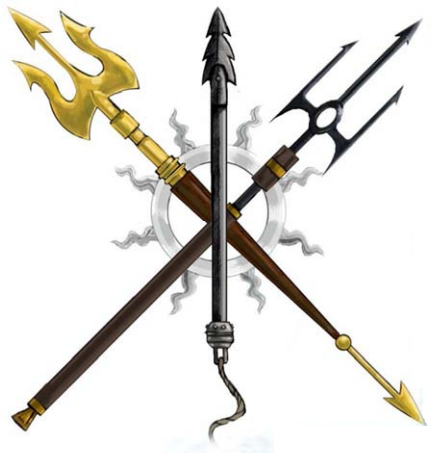
Aquatic Combat
Far shorter than the environmental basics but nonetheless important is the other section of the first chapter, dealing with underwater combat. The biggest deal is that adjacent squares are everywhere – you’re in a 3D space, after all, so there are adjacent squares above and below. The book illustrates how notable this is by comparing the 8 adjacent squares a land-based Medium-size character deals with by the 26 adjacent squares the same character would deal with when underwater. There's also the danger of a character becoming disoriented by some event in the 3D space, which causes a -4 penalty to melee attack rolls, removes the character's ability to make ranged attacks, disables them from being able to sacrifice their swim speed to combat the effects of buoyancy or water currents, and provides a +4 bonus to Armor Class against ranged attacks but a - 4 penalty to AC against melee attacks.
As for weapons themselves, melee is the easiest way to go, as there aren’t any usual penalties with them given that the races of Cerulean Seas are accustomed to using them underwater. The other two big changes relate to splash weapons and thrown weapons. Splash weapons work the same as they usually would, but need to be specifically aimed to hit a solid surface, otherwise they sort of just end up floating impotently in the middle of the water at the end of their arc. And thrown weapons? Well, they aren’t really relevant. They are instead replaced by plunge weapons, which are designed to be hurled downward if they have negative buoyancy or upward if they have positive buoyancy. Same principle as a thrown weapon, just with the added situational nature of buoyancy.
Undersea Races-Anthromorphs
Chapter 2, Undersea Races, unsurprisingly deals with the playable races of Cerulean Seas. These races are divided into three subtypes – the anthropomorphs, the feykith, and the merfolk. While all have the Humanoid creature type, each displays specific traits across all representatives of the subtypes. First are the anthromorphs, who are anthropomorphic animals. Shocking, I know. All anthromorphs share a few qualities – they have a +2 to Perception checks to notice animate creatures or objects, have both land and swim speeds, and can either be underwater for 1 hour per 2 points of Constitution before suffocating if they have lungs or the same amount of time on land before suffocating if they have gills. As with the other two subtypes of playable race in Cerulean Seas, the core campaign guide here provides four examples.
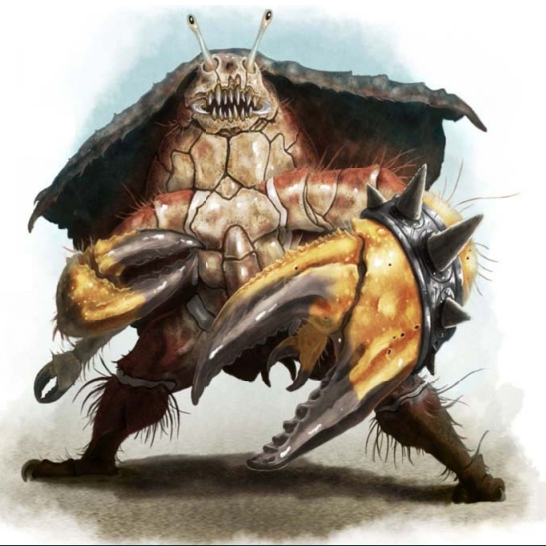
Karkanak: While they may look absolutely terrifying, seeing as they’re huge hulking crab-people with claws of doom and terror maws, karkanaks are actually pretty chill folks. They're almost always True Neutral, tend to be atheists or animists, and like a simple existence of eating, drinking, mating, and crafting fine wares they sell for more simple needs. They’re fine with you as long as you’re fine with them. Karkanaks that become adventurers tend to do so for one of two reasons – to combat a threat to the karkanak people, or to impress lots of mates. Stat-wise, they are pretty tanky, having a +2 bonus to Strength and Constitution at the cost of -2 Dexterity, a +2 natural armor bonus to defense, and and claws that deal either 1d6 damage each for females or 1d8 for one and 1d4 for the other on the males due to having one larger dominant claw. All Craft skills are always class skills for karkanak, and they can use their Wisdom modifier instead of their Intelligence modifier for said skills. Oh, and they’re slow. Really slow. 20 feet swim speed, 10 feet land speed. While they are beach-combers by nature, they have gills rather than lungs, which means they have the “1 hour on land per 2 points of Constitution before suffocating” trait rather than the opposite on.
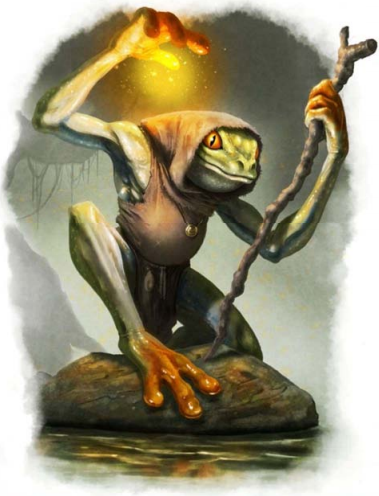
Mogogol: Mogogol are interesting in that they were actually released as part of Alluria Publishing’s “Remarkable Races” line for Dungeons and Dragons 4th Edition before the time of the Cerulean Seas Campaign Setting. It seems that these spunky frog-people were a neutral party in the edition wars, however, and show up here as well. Cerulean Seas gives the mogogol a more Pathfinder-centric backstory by stating that they are the evolutionary descendants of a seafaring tribe of boggards (Pathfinder’s serial numbers filed off version of the Forgotten Realms’ bullywugs) that were “cursed” with altruism and kindness. They eventually interbred with grippli (a 1st Edition Dungeons and Dragons frog-people that became Open Game Content through the Tome of Horrors) and marsh giants that called for the aid of the mogogol ships during the Great Flood, and centuries later they are how they are presented here. Mogogols are obsessive about a single subject that they imprint on at an early age, and often have a childishly simplistic view of the world. This tends to annoy other anthromorphs and confuse merfolk but endears them to the feykith. Mogogols also have a rather strange naming scheme – they name themselves after their race and a tagline about them, with individuals having names like Mogogol With The Big Eyes or Mogogol Who Loves Shrimp Too Much or whatever. Those that are considered particularly affluent get a prefix to their name as well, like Kingly Mogogol That Fights Krakens or something.
Stat-wise, mogogols are sort of a weird jumble. Their ability score modifiers are +2 Charisma and Constitution but -2 to Intelligence, have a 10 foot long ranged grapple with their tongue, and they can be either size Small or size Medium due to that marsh giant blood mixed in with everything else sometimes manifesting strongly. Small mogogols have a swim speed of 20 feet, land speed of 10 feet, and get a +4 bonus to Climb checks, while Medium mogogols just have a swim speed of 30 feet and land speed of 20 feet – both sizes get the benefit of being able to move unhindered in marsh terrain or mud, however. Their alignment must be some manner of Good, and cannot be changed as it is literally genetic for them due to whatever magic was cast on the original mogogol tribe. And, of course, there’s the matter of that whole obsession. The mogogol’s obsession lets them have a +2 bonus to one Knowledge skill or Profession skill. What does all of this add up to? I’m not really sure, but playing one would definitely be an interesting experience.
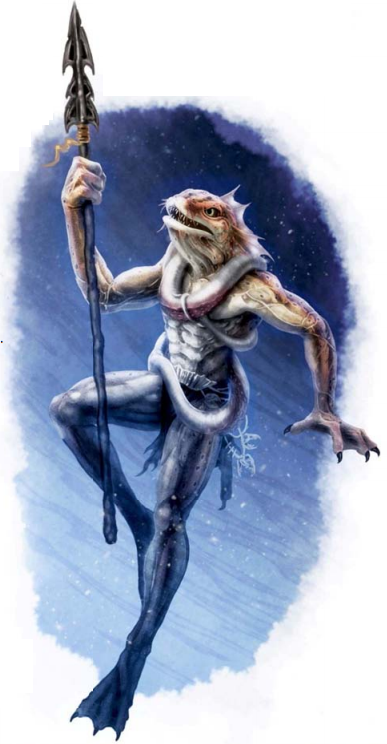
Piscean: The pisceans are fish people who were violent, evil, and greedy in the distant past, but turned over a new leaf during the end of the blood wars with the sahuagin during the Great Flood and became obsessed with neutrality and balance out of a fear that they might slip back into their dark ways. They have to struggle with innate racism and anger problems that make it hard to be as stoic or heroic as their culture demands, and often show their loyalty to a new life by hunting down and destroying worshipers of Clagguth, the dark god they worshiped long ago. The fact that Clagguth's symbol is a cephalopod means they like to hack off octopus arms and wear them as trophies. Piscean characters have a +2 bonus to Dexterity and Wisdom but a -2 penalty to Charisma, a swim speed of 30 feet and land speed of 20 feet, have gills, get a +2 bonus to Handle Animal checks with any natural fish, have a +2 bonus to saving throws against mind-affecting spells and effects, have darkvision, and have a +1 bonus to attack rolls against non-piscean humanoids.
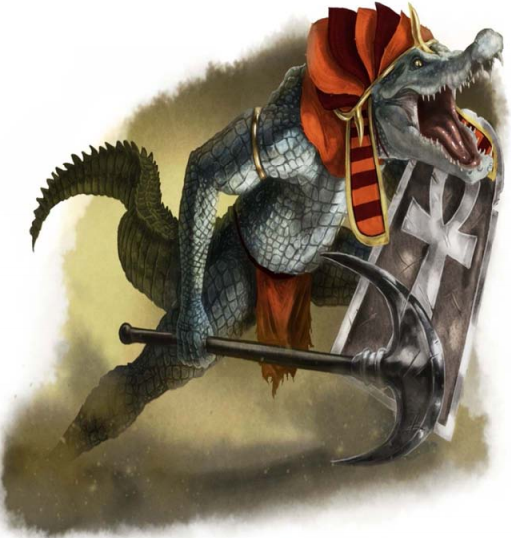
Sebek-ka: The last of the anthromorphs are the sebek-ka, anthropomorphic saltwater crocodiles that are basically the culture of pharaonic Egypt but with crocodile people. To be fair, though, it’s because it is literally all they know, having been bred in the time of the drylanders by fantasy Egyptians specifically to act as avatars of the god Sebek and being immersed in that culture so long that even the centuries after the Great Flood couldn’t wash it away. Sebek-ka tend to be lawful alignment, and it is the pharaoh’s decree that any sebek-ka who doesn’t openly worship Sebek is to be exiled, so other races tend to be a bit apprehensive and tender-footed around the cranky strict guys who have lots of pointy teeth. Sebek-ka characters have a +2 to Strength and Wisdom but -2 to Intelligence, a swim speed of 30 feet and land speed of 20 feet, a 1d8 damage bite attack, a +1 bonus to attack rolls against Tiny or smaller creatures, and can reroll a failed Will save and take the second result due to their "reptilian mind".
Undersea Races-Feykith
Next up after the anthromorphs are the feykith. While they are humanoids rather than true fey due to the mortal plane diluting their ancient fey blood for some reason, feykith are still innately magical. All feykith get a +2 bonus to caster level checks made to overcome spell resistance, a +2 bonus to saving throws against Enchantment type spells and effects, a +2 bonus to Perception skill checks, and a +2 bonus to Fortitude saves versus cold weather, severe cold, or exposure to cold. Lots of +2s for these guys. They also have both land speed and swim speed, and can breathe both air and water equally.
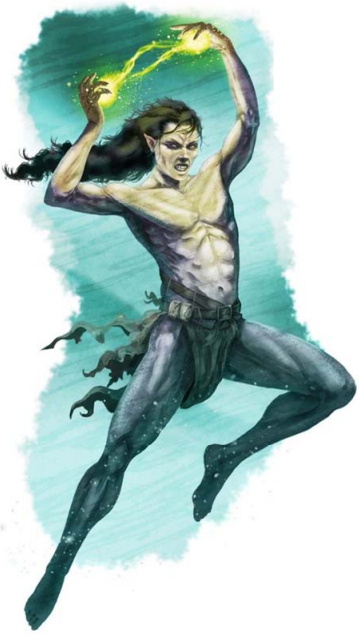
Sea Elf: While land elves were wiped out by the Great Flood, we still have the sea elves around to be dickish to everyone. Thankfully, Cerulean Seas takes the opposite approach of a certain AD&D elf sourcebook and actually calls the sea elves out on their dickishness. While their pride and power can make beautiful coral cities for them to live in and aid other races, it can just as often end up spawning some horrid abomination against nature or lead to paternalistic imperialism. Of course, it happens to be that a fair amount of sea elves aren't dicks – some prefer to be wandering adventurers instead of haughty city-sulkers, there are plenty that care about other species in a non-imperialistic manner, and some are even smitten enough with other races to give up their centuries-long lives and transform into the form of their love. Sea elf characters get a +2 bonus to Dexterity and Intelligence but -2 to Constitution, have a swim speed of 30 feet and land speed of 20 feet, have a +2 bonus to Spellcraft checks made to identify a magic item's properties, and are automatically proficient with any form of trident, longbow, or short bow, as well as treating any weapon with "elven' in its name as a martial rather than exotic weapon.
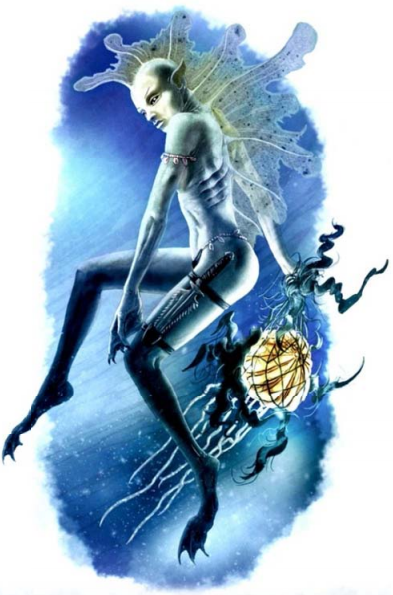
Naiad: Properly referred to as “viridian naiads”, the naiads are strange beings that spend 70 years as non-sapient kelp pods before actually undergoing metamorphosis into their proper adult feykith form, at which time they are effectively ageless and eternally in the same size and shape. They have a very black and white view of the world, with their allies being “good guys” and enemies being “bad guys”, and don’t really understand the idea of lies and betrayal. This childish attitude often makes them best buds with the mogogol, but it also lets species such as the pisceans take advantage of them and have them work for little more than a pat on the back at the end of the day. Naiad characters have a +2 to Constitution and Wisdom but a -2 to Intelligence, have a swim speed of 30 feet and land speed of 20 feet, always consider Knowledge (Nature) as a class skill and key it to Wisdom rather than Intelligence, receive a +2 bonus to saves against paralysis, poison, polymorphing, and stun effects, can be targeted by spells that normally affect only plant creatures, and are so water dependent that they do the whole "1 hour on land per 2 points of Constitution before suffocation starts) spiel even though they technically have both lungs and gills.
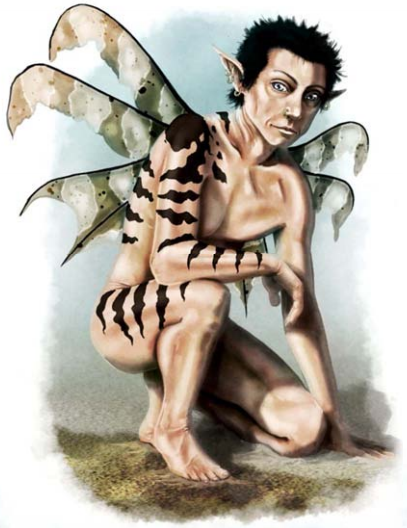
Nixie: Nixies, or “deepwater nixies” as they are sometimes referred to in longform, are little folk that love exploration, magic, and music. Their phosphorescent cities are built around thermal vents deep in the twilight zone of the ocean and have especially tight-knit groups given the eccentricity of nixie love. Not only are nixies polyamorous, but they actively refuse to tell nixie children which mate of their mother is the biological father, forcing family relationships that stretch across entire communities. It probably doesn’t matter much either way, though, given that nixies head off adventuring to sate their wanderlust as soon as they hit adulthood and don’t settle down with a family until they are around 200 years old. Nixie characters are the only size Small race in the Cerulean Seas Campaign Setting book other than the mogogol and cindarian, have a +2 bonus to Charisma and Dexterity but a -2 penalty to Strength, have a swim speed of 30 feet and land speed of 20 feet, get a +2 bonus to Handle Animal checks and consider said skill to always be a class skill, add a +1 bonus to the saving throw DC of any Enchantment they cast, automatically get charm person once per day as a spell-like ability if they start play with a Charisma of 11 or higher, and can double their swim speed if they turn their move action into a full round action.
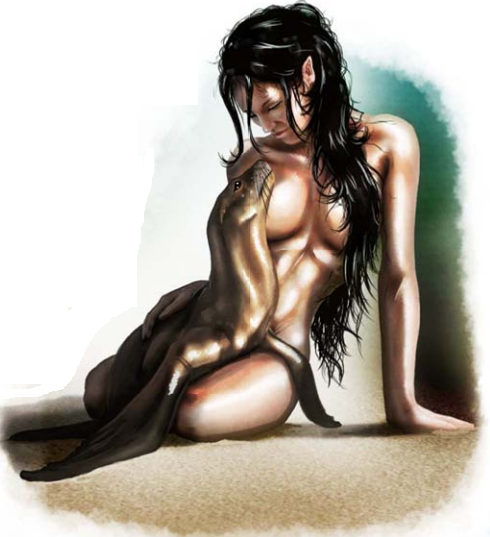
Behold, convenient censor-style art.
Selkie: The selkies are a territorial, tribal people that can take on the form of a seal or a sea elf. Lead by a Kahuna (the setting's equivalent of a Druid) matriarch, they are a boisterous people who love feasts, alcohol, rough sports, and competitive fighting. They are not fond of lawful races, especially the nommo, and tend to gravitate toward other feykith. Selkie characters have a +2 to Charisma and Dexterity but -2 to Wisdom, have a swim speed of 30 feet and land speed of 20 feet, can innately sense the general compass direction of their homeland, and can transform into their seal form and back again. Since they are meant to be played as an "out of the box" race, turning into a seal isn’t a full blown deal like polymorph – instead, the only things that change about the selkie’s stats are that their speeds change to 5 feet land speed and 60 feet swim speed, they have a +5 bonus to Disguise checks to pretend they’re a generic non-magical seal, and they can’t do anything that would need hands instead of flippers.
Undersea Races-Merfolk
The third and last of the three subtypes of humanoid playable in Cerulean Seas are the merfolk, which follow the classic merfolk trend of having some manner of humanoid form from the waist up and a sea creature’s from the waist down. The traits that all merfolk have are gills instead of lungs, the ability to have a piddly 5 foot land speed if they make the effort to crawl onto land, and always get a bonus feat at their first character level.
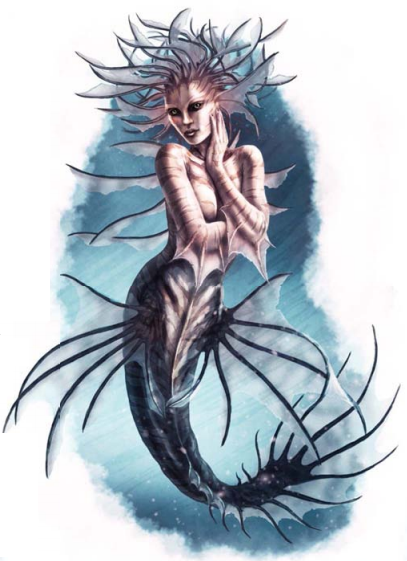
Cindarian: While they may have the spin lower half of a lionfish, the cindarians are basically the stereotype-Switzerland of the Cerulean Seas. They’re neutral with pretty much everybody and vice versa, and love to learn about the ideas and rituals of other cultures. Their own civilization is based around an obsession with coral reefs – they live in or around coral reefs, tend to the health of coral reefs, and get uncomfortable when they're away from coral reefs. Younger cindarians are enthusiastic enough about seeing new sights and learning new things that they become adventurers, but by the time they’re of old age they have an innate inset of agoraphobia outside of their beloved coral sanctums. Cindarian chraracters are size Small, have a +2 to Constitution and Charisma but -2 to Strength, have a swim speed of 30 feet, are forced to take the feat Coral Link as their merfolk bonus feat, have a +2 bonus to saving throws against poison and fire coral disease, and have venomous spines that deal a point of piercing damage and a point of Dexterity damage to any creature that makes an unarmed or natural attack against them.
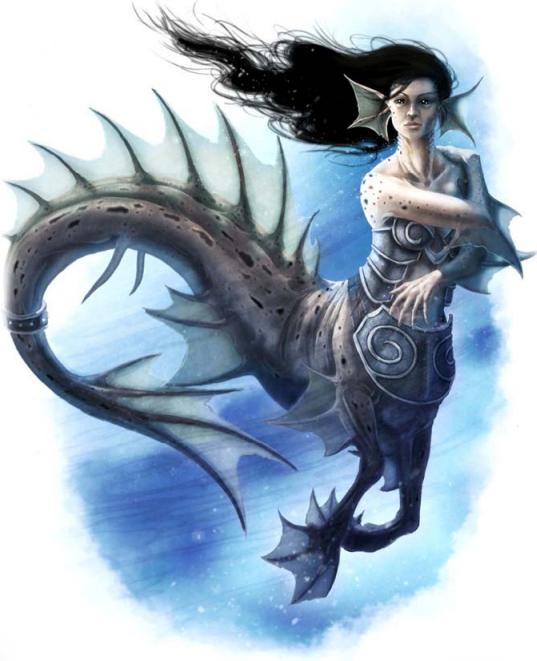
Kai-lio: The kai-lios are the centaurs of the sea, having the mystical hippocampus as their sea creature lower body. Unsurprisingly, they’re pretty fond of worshiping Poseidon, since they cover all of his major domains besides earthquakes. The fact that kai-lios are introverted and isolationist makes them mysterious to pretty much everyone other than the cindarians. Most of the time, they prefer to spend their days crafting art, poetry, and spending time with their families, but there are obviously cases of adventuring kai-lios – usually outcasts, those who have had a religious or philosophical experience that drove them to wander, or individuals defending their homeland from some manner of foe – since they wouldn’t be a noteworthy playable race otherwise. I would love to say that kai-lios are the only Large playable race in Cerulean Seas, but no, they’re somehow Medium-size like most races even though they have a big ol’ sea horse for a lower half. I’m fairly sure this is some sort of mistake, as the text even says that they are 9 feet long as far as their horsey half goes and human-sized in their humanoid half, so they are clearly going to be size Large. Either way, what kai-lio characters do have are a +2 to Strength and Wisdom but -2 to Charisma, swim speed of 50 feet, the ability to carry 50% more buoyany load than a standard humanoid, and an inability to ride mounts that are smaller than size Huge.
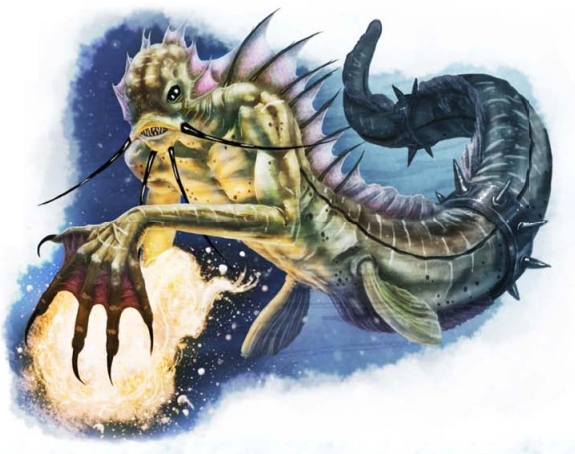
Nommo: The oldest of the merfolk, the catfish-like nommo have been around since before even the millennia of the drylanders. They're condescending assholes that use the royal we, think the other merfolk's version of the merfolk goddess Keilona is a half-truth compared to their version of her, treat other races as children to be coddled, justify any action they do as being innately benevolent due to their superior nature, and have a gender segregated society where females are part of the noble class and males almost always part of the servant class. Unsurprisingly, the only race that actively tolerates them are the cindarians, though most will tolerate them for their knowledge or adventuring expertise. Nommo characters have a +2 to Strength and Intelligence but -2 to Charisma, 40 feet swim speed, have an air tolerance that is in rounds rather than hours like most gilled beings in the title do, can wield a one-handed melee weapon as if it were a light weapon due to their oversized hands, and are acclimated to extreme depths and thus suffer water pressure damage if they head above depths of 300 feet.
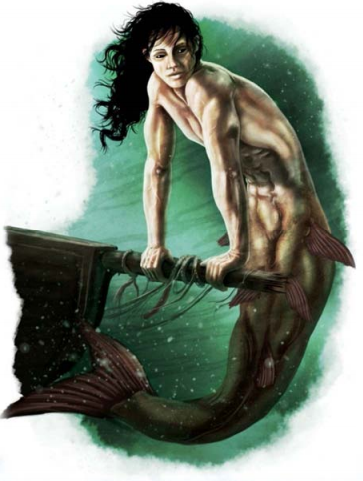
Seafolk: Literally humans with fish tails. The two major seafolk nations are the artsy, learned, and peaceful Carallel and the politically savvy, warmongering, and imperialistic Barashi. In spite of their vast differences, the Carallel and Barashi manage to be bipartisan when it comes to the well-being of the seafolk. Seafolk characters get +2 to one chosen ability score, have a swim speed of 40 feet, and gain one additional skill rank each round. See? Literally just watery humans.
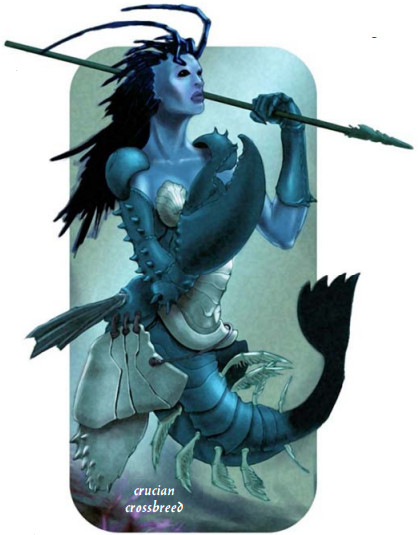
Seafolk Crossbreeds: Like the humans they are so similar to, seafolk are prone to sexing up anything that is vaguely compatible. Enter the crossbreeds! Each crossbreed uses the seafolk stats plus one trait taken from the other parent race, and the given examples are as follows.
-
Cindarfolk:
Cindarfolk are seafolk/cindarian hybrids, and basically look like cindarians that are Medium instead of Small. They get the poison spine ability of the cindarians.
-
Bogfolk:
For some baffling reason, a boggard and a seafolk mated, and the result is a boggard with the fish half of a mudskipper. They get the 1d4 damage claws of the boggard.
-
Kai-lua:
The most baffling seafolk crossbreed of all, somehow a kai lio and seafolk breeding creates a seafolk with a seahorse tail. As in the fish, not the hippocampus. And this tail is prehensile, acting like an extra hand, which is the ability it gets instead of a kai lio ability.

-
Mroe:
These seafolk/nommo hybrids have silurid catfish tails like the nommo do, as well as the nommo's oversized hands and the ability associated with it.
-
Sharkfolk:
These are a hybrid between seafolk and the shargs, a monstrous race that we thus won't be seeing until the bestiary chapter later on. Their sharg heritage gives them a shark lower half and sharp teeth, giving a 1d4 damage bite attack.
-
Oceanid:
A mix of sea elf and seafolk, basically looking like a sea elf with the fishy tail instead of a human with the fishy tail. Their benefit for existing is getting the sea elves' racial weapons proficiencies. Yaaaay.
-
Dark Oceanid:
A mix of sea elf and deep drow, another monstrous race that we won't see until chapter 9. They are basically oceanids but with drow instead of sea elf as far as looks go, but their actual racial trait is a +4 bonus to saves against poison thanks to their deep drow parent.
-
Pincoy:
Seal from the waist down, sea elf from the waist up. That means seafolk/selkie hybrid, if you couldn't guess. They get the selkie's magnetic "home is this way" sense.
-
Crucian:
By some fluke of nature, a karkanak and seafolk got together, and as you can see from the image above the crossbreeds entry, it is certainly something to behold. They get one 1d6 claw attack, +1 natural armor bonus to AC, and the innate Craft ability of the karkanak.
-
Mergogol:
Merfolk + mogogol. Get it?
 They have frog legs, which lets them move on land, which sort of defeats the purpose of a merfolk but whatever. They also get the marsh stride, obsession skill bonus, and inborn Good alignment of the mogogol parent.
They have frog legs, which lets them move on land, which sort of defeats the purpose of a merfolk but whatever. They also get the marsh stride, obsession skill bonus, and inborn Good alignment of the mogogol parent.
- Oanne: The most terrifying of the seafolk crossbreeds, these seafolk/piscean mixes literally look like human-sized carp that happen to have arms and legs sticking out from them. Imagine that ambling toward you. In addition to obviously getting the land-walking ability of the piscean parent, they also inherit their darkvision, bonus to Handle Animal with fish, and their bonus to saves against mind-affecting effects.
----------------------------------------------------------------------------------------------------------------------------------------
Next time: base classes, prestige classes, skills, and feats. Hurray!
Marine(r)s!
Original SA post
With the resurgence of White Wolf reviewing, I'm sort of hoping someone gets to the recently released Werewolf 20th Edition: Rage Across the World. It apparently tries to cover such topics as critically endangered wolf populations, South American political tensions, and the Arab Spring, and I'm genuinely curious as to whether White Wolf has gotten better about dealing with such subjects.
Considering I have my own writing to get to, though, I shouldn't just post my curiosity. It's time for the next Cerulean Seas post.

Part 2:
Space
Marine(r)s!
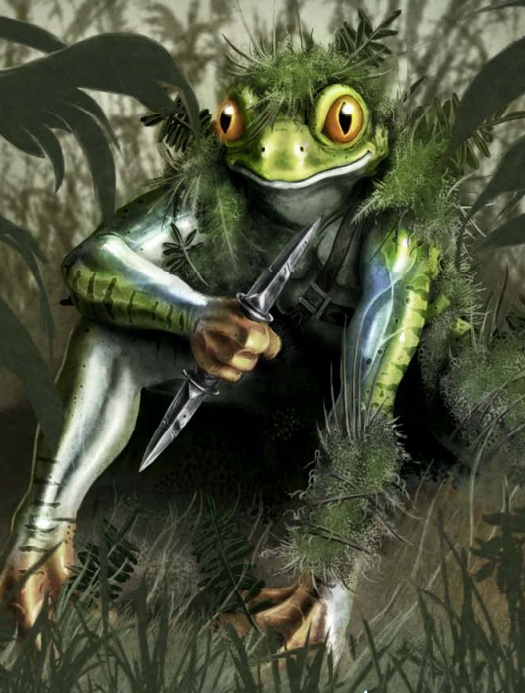
Adapting Existing Classes
Moving into chapter 3, our first stop is a look back at existing Pathfinder classes and how they are modified for the setting of Cerulean Seas. While some of these are simplistic cases of “move speed reference altered to swim speed”f or classes such as the Barbarian, as well as notes of the removal of the Bard, Druid, and Ranger in favor of three new classes (the Siren, Kahuna, and Mariner), some classes do have alterations worthy of noting before we head into the entirely new classes.
Alchemist:
The Cerulean Seas Alchemist is mostly a case of replacing thrown potions with plunging potions, but they also get access to a new type of bomb – the boiling bomb, to be specific. Boiling bombs do exactly what their name suggests, causing ten square feet of water to erupt into a violent boiling steam bath that deals 1d6 heat damage (basically a renaming of fire damage) per round it’s active.
Cleric:
Want more domains? You get more domains...sort of. The Plant and Fire domains are removed in Cerulean Seas, instead replaced by the Flora and Steam domains. The Flora domain deals with not just plants, but also algae, anemones, barnacles, coral, and sea sponges. The two non-spell powers granted by the Flora domain are Coral Fist (you can transform your hands into big coral mitts that deal lethal rather than nonlethal damage on unarmed strikes) at third level and Reef Armor (you can create a coral reef around yourself that transmits fire coral disease to foes that attack you with unarmed or natural attacks) at sixth level. The Steam domain gets Boiling Bolt (basically a boiling bomb but only targeting one enemy) at first level, followed by heat resistance 10 at sixth level that upgrades to heat resistance 20 at twelfth level and again to heat immunity at twentieth level.
Monk:
There aren’t exactly a lot of times when you’re falling through the air from a cliff in a setting where the only dry land are scattered tropical islands and far away ice sheets. Unsurprisingly, then, the Monk gets two new class traits to replace those it has related to jumping and falling. Slow Fall is replaced by the ability to have neutral buoyancy even when unconscious, while High Jump is replaced by being able to "walk" (even if the species doesn't have legs) on top of the water for a distance equal to the Monk's extra speed gained from their Fast Movement class feature.
New Classes
It’s now time for actual new base classes rather than alterations to existing classes. I already mentioned what the three classes are, but let’s actually get a look at them proper rather than just saying what they replace.
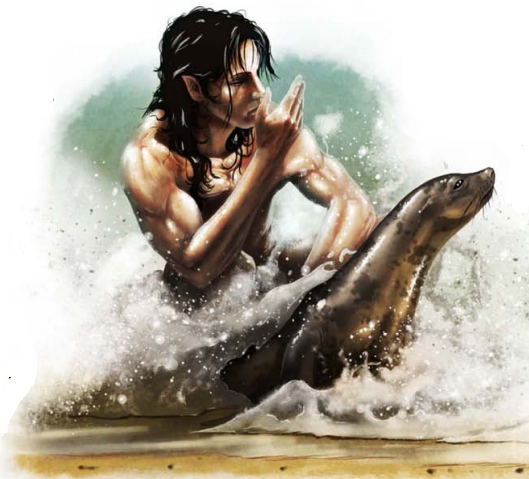
Kahuna:
These divine spellcasters of the waves call upon ocean spirits to empower them. They have great Base Attack Bonus progression and Will saves, but not so much on the Fortitude and Reflex. Rather than gaining any form of wildshape or any other archetypical Druid power, the Kahuna’s class features are the ability to take on the mantle of their spirit. These “spirit aspects” come in three ranks – lesser at first level, intermediate, at sixth level, and greater at twelfth level, each starting out at one use per day and gaining another use at the next two even numbered class levels. There are also an added “strength of spirit” at first level that is relegated to a number of uses per day based on the Kahuna’s Wisdom modifier plus three, an “aspect master” trait that is attained at eighteenth level that doubles that makes any of the three spirit aspects be usable as a free action and both last twice as long and be twice as effective, and the capstone ability “summon spirit” at level twenty that channels the full mojo of the spirit and has its number of uses per day based on the Wisdom modifier alone.
All of these abilities affect not only the Kahuna, but any of their allies within a thirty foot radius, giving this class a little bit of a leader aspect. They also all happen to only last one round, with the exception of the spirit summon which lasts for a number of rounds equal to the Kahuna’s Wisdom modifier, so the widespread application aspect isn’t too worrisome. The spirits that are most often venerated (read: the ones the authors wanted to create and put in) are the following. Note that I’m only going to give the full list of powers for the first to give you a feel of how they tend to be power-wise, and then generalize the rest for expedience.
-
Barracuda:
Barracuda is an adaptable but impulsive spirit that emphasizes to its follower that you need to be swift both physically and mentally. Of course, one might say that’s a bit of a weird statement given that all of its granted boons are physical in nature – its strength of spirit is Darting Strike (move ten feet then melee attack) as a standard action, the lesser aspect is Lunge (+2 attack roll bonus and free access to the Lunge feat), the intermediary aspect is Hasty Retreat (+2 to Armor Class and Reflex saves, as well as a free ten feet of movement if an enemy's attack misses that same round), the greater aspect is Swiftness of the Barracuda (+2 dodge bonus to AC against attacks of opportunity, as well as a bonus to swim speed of ten feet per each positive number of the Kahuna's Wisdom modifier), and the spirit summon is Barracuda’s Assault (+4 bonus to AC and Reflex saves, as well as a free attack of opportunity against an attacker whose melee attack misses). Indeed, truly the paragons of quick wit, those Barracuda Kahunas.
-
Crocodile:
In addition to being one of the most hardy watery ambush predators alive, crocodilians are adept at tender parenting, terrestrial hunting, “singing”, have a universal body and song language that almost all crocodilians understand, and even engage in mild tool use. This has nothing to do with the Kahuna, mind you, I just really love crocodilians. Anyway, Crocodile is a patient and persistent spirit who demands the same of its Kahunas, and has abilities that are both offensive and defensive in nature. The power of Crocodile is twofold, weighing damage reduction against abilities related to grapple attacks.
-
Dolphin:
Dolphin inspires friendship and teamwork. All of Dolphin’s boons are related to the whole “allies are affected to” aspect of the Kahuna’s powers, granting boons such as the ability to reorganize damage taken between the allies in the radius and various bonuses when an ally attacks during the spiritual buff.
-
Great White:
Great White is a voracious spirit whose main tenet is that words should be backed up with actions, not simply sat upon. Great White Kahunas don’t do a lot with their spirit, but what they do is very effective – strong toothy bites that deal bleedout, attack buffs, and the ability to sense foes around them.
-
Kraken:
The creed of Kraken is to literally and metaphorically grasp at everything possible. Its spirit powers are focused heavily on granting reach and extra attacks, but also have a dash of abilities to inspire fear based on the legendary nature of the kraken.
-
Sea Lion:
While Sea Lion’s gimmick is said to be cleverness, its actual boons are sort of a clusterfuck of various boosts. It starts out with a simple sonic roar attack and ends with the ability to boost a bunch of different abilities based on circumstances adverse to them (get a +2 to AC each time you’re hit, get a +2 to attack rolls every time you miss, etc.), with various stuff shoved in between.
-
Sea Turtle:
Sea Turtle is plodding and planning, focused on the long term goal rather than the immediate benefit. This mostly translates into Armor Class bonuses and other forms of damage avoidance, save for having a greater spirit aspect that allows for the Kahuna to slow down a foe.
- Stingray: Stingray is extremely pessimistic and seeks to distance itself from others, facing inevitable violence with its venomous barb. To the surprise of no one, its spirit aspects are related to poisoning foes.
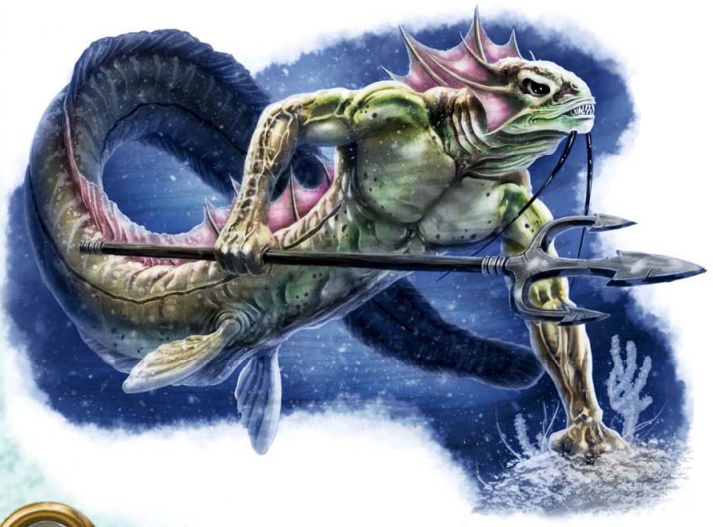
Mariner: Don’t let the name fool you – the Mariner class isn’t some sort of seaborn sailor, it’s actually an aquatic warrior. The class has d10 hit dice, full Base Attack Bonus progression, and a high Reflex save progression at the cost of poor Fortitude and Will save progressions, making it a tough but swift class. And swift is the Mariner’s specialty, given that half of its class features are based on boosting swim speed, evasion, and maneuverability in some manner. The other big trait of the Mariner is the Sudden Strike class feature – think a Rogue’s sneak attack (it even has the by-the-1d6 damage progression), but rather than relying on catching a foe flat-footed, a Sudden Strike comes into play in an attack made as part of a maneuver feat (Combat Reflexes, Improved and Greater Bull Rush, Improved and Greater Overrun, Lunge, Nimble Moves and Acrobatic Step, Run, Shot on the Run, Spring Attack, Step Up, or Whirlwind Attack).
The biggest two bonuses the Mariner gets are, unsurprisingly, near the end of its class progression. Its eighteenth level ability, Deep Diver, completely negates any pressure damage, while the capstone ability Shark’s Frenzy lets the Mariner basically become a doom machine. In addition to granting 10 extra bleed damage to Sudden Strike, it also lets the Mariner get access to Sudden Strike on a round after they move at their full move speed. That means a level 20 Mariner is going to have a damage yield of their weapon damage plus their Strength score plus 5d6 Sudden Strike damage plus 10 bleed damage any time they use a maneuver feat or the round after they move at full speed.
So what exactly is the Mariner’s role, beyond lots of speed and damage? That’s a good question. They are painted as being anything from a warrior or armed scout to a spy or courier, as their talents lend them to many different paths in the underwater world. My personal feelings on the Mariner are a bit...mixed, to be honest. While it’s not a bad class, per se, it also doesn’t really feel like something that is meant to be a replacement for the Ranger, which is the Mariner’s stated intention. With the Kahuna you can see the link of “divine spellcaster that does naturey stuff”, but the Mariner has no such ‘feel’ to it. It seems more like something that should be seen along with a Ranger replacement rather than being the Ranger replacement itself.
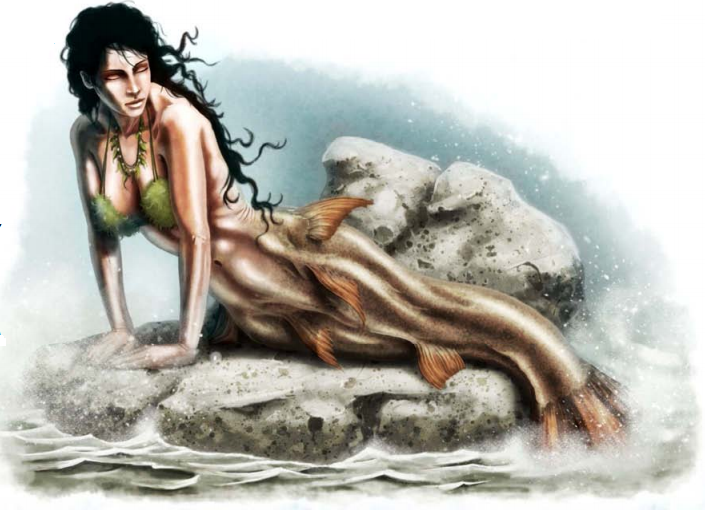
Is...is that an algae bra?

Siren: With the same hit dice, BAB and save progressions, and arcane spellcasting as Bards, you can’t really mistake the intention of the Siren class to be its replacement. The main difference is that the Siren isn’t going to be defending anybody – this class is all about musical offense. Its songs include such gems as the Predator's Song (+1 to damage rolls and +5 swim speed for allies), Shattering Note (sunder things with your voice), lullaby (guess), Dominating Dirge (replicate dominate person ), and Lamentations (foe is sickened, nauseated, or stunned depending on their HD compared to the Siren). Their other abilities are various boosts to their offensive songs, including targeting multiple foes, causing foes to be stunned and then sickened after the song ends, and the ability to double the range of a song they choose as a specialty. It could be easily argued that the Siren could have just been a variant Bard, and I can’t say I’d disagree with such a statement, but the class isn’t really that bad either.
Prestige Classes
The Arcane Archer, Pathfinder Chronicler, and Nature Warden are prestige classes not available in Cerulean Seas, while the only big changes to other prestige classes are changing the Dragon Disciple’s parentage to song dragons (the only group of true dragons in Cerulean Seas) as well as renaming the Horizon Walker into the “Seeker of the Blue Horizon” and granting it a few new terrain specialties based on the ocean depths. This means that, unlike base classes, we can walk right into the new prestige classes unimpeded.
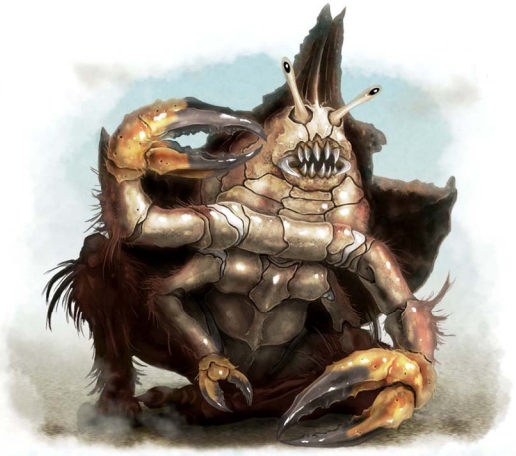
You may have noticed that these classes and prestige classes use the opposite sexes from those presented in the racial portraits. The same is true here, where the female karkanak is looking calm but terrifying.
Beach Comber: Winner of the “most innocent-sounding deceptive name” competition in Cerulean Seas, the Beach Comber prestige class reflects the groups of hardened bounty hunters that seek the fugitives that can flee (and have fled) to what dry land is left in the world. The class is pretty blatantly focused on giving and taking damage, with d10 hit dice and a full Base Attack Bonus progression at the cost of an average Fortitude save progression and poor Reflex and Will save progressions. As for class features, they can be summed up as "want some Ranger stuff back? Here, have it". Beach Combers happen to inherit the favored terrain, trap sense, and favored enemy (toward a specific bounty) features of the extinct Ranger.
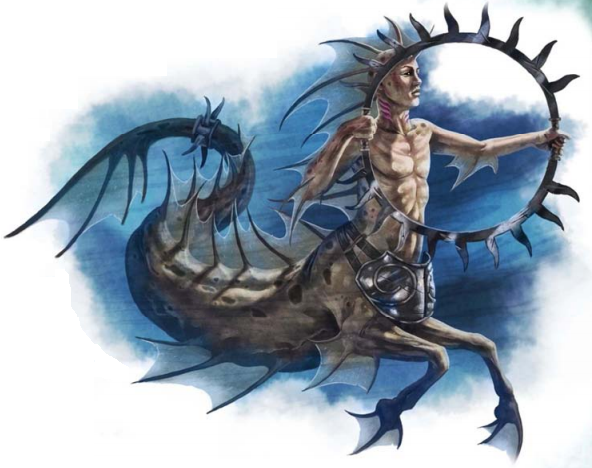
Glimmerkeeper: The Glimmerkeeper prestige class reflects a type of legendary magical folk hero in the world of Cerulean Seas, individuals who fight against evil with quick minds, quick bodies, and a little bit of supernatural help. In addition to swim speed boosts, the two most prominent class features o the Glimmerkeeper are increased uses per day of abilities entitled Spectral Form and Glimmer Armor. Spectral Form is, as its name implies, the power to take on a temporary spectral form, thus becoming incorporeal and getting those sweet, sweet touch attacks. Glimmer Armor is not quite so straightforward, as it isn’t armor in the literal sense so much as in the metaphorical sense of defending the Glimmerkeeper – it allows the Glimmerkeeper to force a Fortitude save on a foe that is struck by them in melee, and if the target fails they are blinded for a number of rounds equal to the Glimmerkeeper's Charisma modifier. The capstone ability is the rather interesting Keeper of the Light power, which can either take away light to create a magical concealment within a sixty foot radius or shine an abundance of light in the same radius to grant a +2 bonus to saving throws and attack rolls for allies as well as replicate the daylight spell.
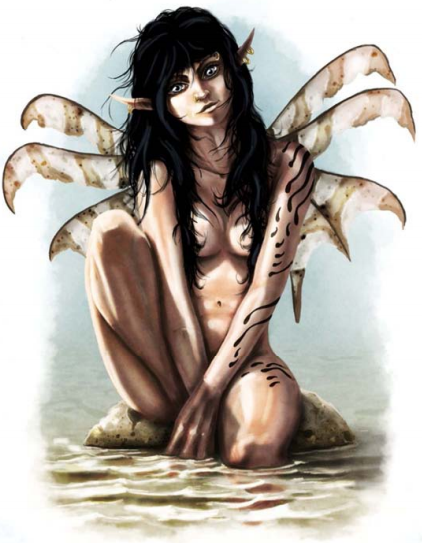
And there's that convenient nudity coverage again.
Sea Witch: The Sea Witch is a prestige class that only characters with levels in Siren can enter, and is focused on new songs that deal with death and the undead. Their songs fatigue and deal Strength damage on a critical failure by the target, can create a ward against the undead, can siphon out the life force of others (read: damage in exchange for temporary HP), and can summon the undead. This class isn’t really what I’d say I envision when I hear “Sea Witch”, I must say...still, it isn’t bad, just different.
Skills
Entering chapter 3, the first and biggest change to the skill system is presented upfront. The Swim skill? Dead. Kaput. Axed. Pushing up daisies. An ex-skill.
“Cerulean Seas” posted:
Having a Swim skill for an underwater setting would be much like having a Walk skill for a dry-land campaign, and is therefore phased out for the purposes of this campaign setting. While it is true that some species can walk on land, that too is an innate ability, and therefore does not require a separate skill.
-
Climb:
In addition to being used to actually climb things, a successful Climb check can allow a merfolk or merped (animal version of merfolk) to crawl itself along the land at one fourth their swim speed rather than the normal 5 foot speed listed.
-
Handle Animal:
For those who want more tricks to teach their animal, there are three more added in the Cerulean Seas Campaign Guide that allow you to teach how to
- Stealth: There's a special form of Stealth for "scuttling", a difficult maneuver that requires you to move at least six squares, meet various conditions, and succeed on the check to seemingly zigzag and then disappear entirely.
Feats
While some may tear over the loss of the feats Throw Anything and Tower Shield Proficiency, they can rejoice that there are a total of forty-five new feats. These feats can basically be broken down into four categories:
-
"Simple but Effective" Feats
: As with many a sourcebook that contains a lot of new feats, there are always some that are effective for the campaign setting but can't have very much said about them beyond that they exist. In the case of the Cerulean Seas Campaign Guide, these feats include Ambassador to the Deep (increases depth tolerance by 100 feet each time it's taken, to a maximum of 1,000 feet), Coral Link (you can communicate with anyone adjacent to the same coral reef as you through telepathy), and School Friend (gain concealment within a school of fish while not startling them).
-
Racial/Subtype Feats:
Again, as with many sourcebooks, there are new feats dedicated to certain subtypes and races as well. While some are really unexpected, like selkies getting feats to allow them to shapeshift their gear with them or cast somatic spells while in seal form, karkanak getting bigger and more damaging claws, and pisceans and nommos getting toothy fish bites, there are a few that stand out such as Breathlink (allows a feykith subtype race to share their ability to breathe underwater with an adjacent air-breather), Caustic Skin (naiads with this feat have particularly virulent kelp-bodies that deal 1d4 acid damage to creatures that bite them), and Waterjot (mogogols with this feat can run across the water like a basilisk lizard – mogogols keep proving to be such a crazy fun race in every way).
-
Combat Feats:
While combat feats are, again, one of those ubiquitous feats, I'd argue that they are the least interesting ubiquitous feat in the Cerulean Seas Campaign Guide. While feats lke Diving Strike (get a bull rush and then a melee attack when you make a charge), Opportunist (get a free attack of opportunity against a foe whose attack of opportunity just missed you), and Thickened Spell (spells that target a foe/foes also cause water to gel around said foe/foes, halving their movement rate and giving them a -2 penalty to melee attack rolls) may be good in combat, there's not much to say about them.
- Class Feats: ...Actually, no, I take back what I said about combat feats. These are the least interesting ubiquitous feats. They're all either song buffs for the Siren or spirit buffs for the Kahuna, and none of them are even interesting enough for a minor parentheses-clad blurb.
----------------------------------------------------------------------------------------------------------------------------------------
Next time: I had thought about putting the equipment section in with this post, but it didn't really feel right, so next time we'll be having both it and the magic chapter. Ooh.
Shark Swords and Seaweed Spells
Original SA postpkfan2004 posted:
NEXT TIME: EVERYONE'S FAVORITE, THE CHAPTER ABOUT SHOPPING AND 85% MINOR THINGS YOU WILL NEVER NEED

Part 3: Shark Swords and Seaweed Spells
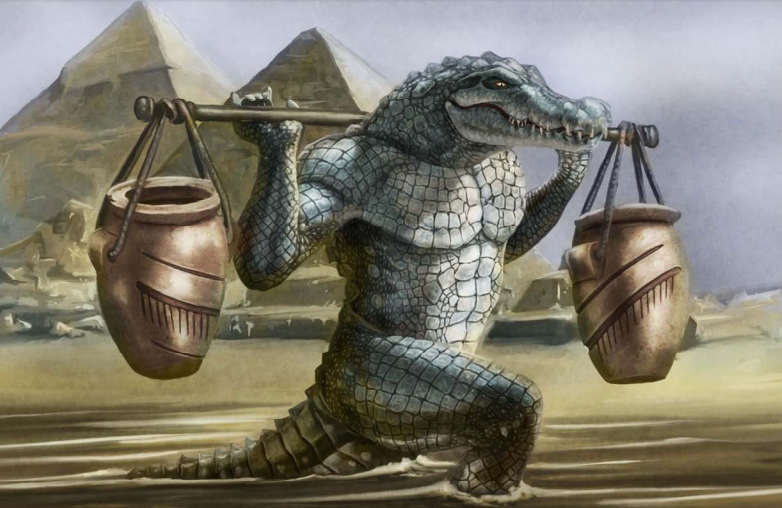
Equipment
Ah, equipment, that thing that characters tend to need but nobody really wants to discuss. I’m going to be brief with this due to the fact that equipment chapters are second only to minor adventures in the category of things that make my brain immediately shut down any attempts to formulate humor or witty commentary.
New Aquatic Materials: If you are in the underwater world of Cerulean Seas, you can make things out of coral! Or Pykrete! Or swamp trees! Since this is basically for material hardness and HP, I don’t really care! Moving on! Exclamations!
Weapons: The Cerulean Seas Campaign Guide provides seven new simple weapons, thirteen new martial weapons, and eleven new exotic weapons. Things like fishing spears, harpoons (which are exotic rather than martial weapons for some reason), greatspears, and fisherman’s gaffs are pretty self-explanatory, but some weapons get a bit weird. Take, for instance, the fact that there are actually three different weapons specifically made for awakened (“trueform”) sharks, dolphins, and similar creatures – a nose harness that replicates a narwhal’s tusk in metal, another that is the same but replicates a marlin’s stabbing sword, and blades that attach to the caudal and dorsal fins.
Armor: Three new forms of light armor, four forms of medium armor, four forms of heavy armor, and five types of shield. While a few are actually somewhat sensible things like shark hide or turtle carapaces, most are weird shit like never-melting ice armor, coral, and...well, this fascinating medium armor.
Cerulean Seas Campaign Guide posted:
Jellyfish armor is created from authentic jellyfish bodies through an alchemical process that hardens them into stiff but flexible translucent plates. The armor can be quite beautiful, reminiscent of metallic plate armor of the surface world, only translucent and often tinted in blue or green.
Ships: Ships in Cerulean Seas are more of a supplemental add-on than anything of importance, as most of the adventures are meant to take place beneath the waves. Most ships don't even have weaponry due to the fact that attacks will usually come from below in the form of either undersea pirates or something ramming the hull, and are pretty much only used for cargo and person transport, fishing, and whaling by the marginally terrestrial races like the sebek-ka and mogogol. Each ship has a stat block that notes its size, material it is mostly made of, how many crew members it needs, how much cargo space/passenger space it has, its total hit points, its hardness, what type of propulsion system makes the ship move, its total speed, how many squares it needs to move in order to turn at top speed, and the minimum water depth it needs to actually move.
Statistics are given for a generic boat or raft at both ten and twenty feet of length, a buoy, an elven towboat (towed by sea creatures, because elves), genai wickership (basically a Chinese junk), kappa pontoon (more or less a literal ffloating fort), karkanak goliath (akin to a cross between a whaling ship and battleship), mogogol galleon (a galleon, surprisingly), naiad podcraft (a stupid "living ship" made out of lilypads), sebek-ka longship (longboats with Egyptian rather than Norse decorations), and selkie ice-runner (a big sailboat that tows ice to selie processing plants).
Aquatic Goods: Other than a few things like anchors and floats and, most of the new "general goods" listed are either new types of alchemical concoction or riding gear for sea creatures. Oil that makes you more hydrodynamic and ups your swim speed, weird entangling kelp, stuff like that.
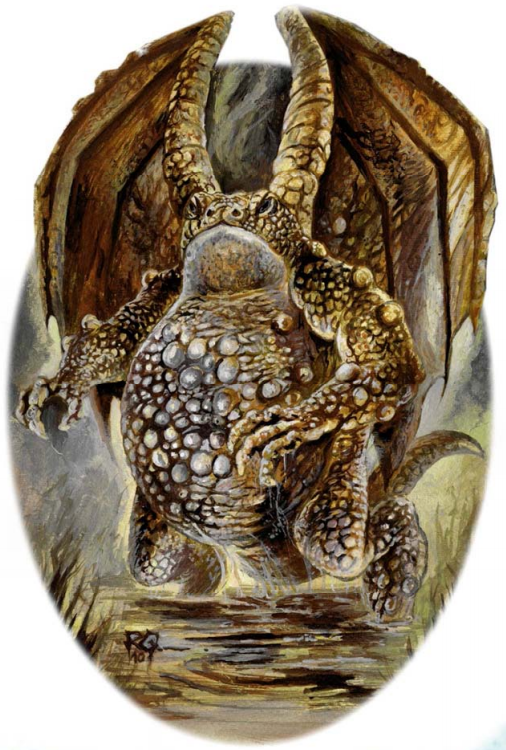
Spells
Starting into chapter 6, our first introduction to magic in the Cerulean Seas setting is on how existing magic is changed. The big ones to know are that invisibility is reversed from normal Pathfinder (completely invisible underwater but appears as a water bubble above water, instead of vice versa), freedom of movement and incorporeal/ethereal effects void the effects of pressure, drag, and buoyancy, underwater fire damage is replaced by heat/steam damage which is basically the same but can't catch flammable things on fire, underwater electricity spells will always manifest as a sphere rather than a line or arc, spells that knock a foe prone instead make them disoriented, and levitation or flight spells cast underwater grant neutral buoyancy. Of course, given that almost all of the electricity and fire spells are replaced with new spells (amongst others), having this noted as a rule in the chapter seems almost pointless.
As for those new spells, there are a total of one hundred thirty-two spells. Most of them are alterations of existing spells, however, such as acid fog coming "acid murk" and fireball being changed to "mageboil". I'll at least note a few of interest in spite of this.
-
Disgorge School (Conjuration, Alchemist 2 or Witch 2):
Congratulations, you have proven yourself the grossest spellcaster by vomiting up a whole wriggling mess of lampreys to attack your foes. If you're particularly strong, you can blow chunks of [/i]electric eels[/i] instead.
-
Jaws (Illusion, Witch 3):
You create a shadowy size Huge shark that is basically real but can be dispelled. Rumor has it that if you cast it four times in a row, its stats will drastically diminish.
-
Mind Murk (Enchantment, Siren 5, Sorcerer/Wizard 5, or Witch 5):
This violet-colored water induces a -10 penalty to Wisdom checks and will saves within the area of murk. As if spellcasters needed any more help on that front.
-
Necrotell (Necromancy, Sorcerer/Wizard 3 or Witch 3):
You make a pool of stagnant water summon a human skeleton from the time before the Great Flood that has an Intelligence score of 12 and 5 free ranks of Knowledge (Ancient History) and Knowledge (Local History). It's got the Evil descriptor because apparently even calling forth ancient knowledge with necromancy counts as evil necromancy.
- School of Scales (Transmutation, Kahuna 6 or Witch 6): You turn every part of yourself other than your skeleton into a school/swarm of lampreys, squid, crab, piranha, jellyfish, leeches, or electric eels. These critters act as part of your will and consciousness, letting you spy through their eyes.
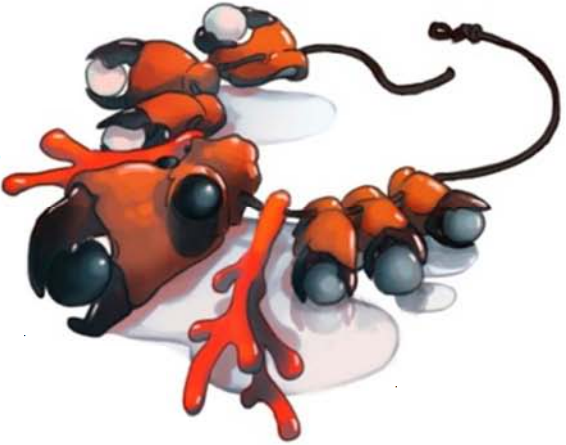
Aquatic Magic Items
There are few enough new magical items to end off chapter 6 that I can note them all.
-
Crocodile Armor:
This +2 scale armor also grants a +10 bonus to Acrobatics checks when underwater, hold your breath like a crocodile, and even turn into a crocodile five minutes per day.
-
Kraken Fork:
A +1 treble fork that can transform into a subservient octopus or let you sprout two tentacles so that you can wield it while your hands are still free.
-
Spear of the Fluke:
A pretty horrifying idea for a magic item, this is a +1 barbed shortspear that has a 50% chance of having one of its barbs break off, transmute into a parasitic flukeworm, and travel to the foe's heart in 1d4 rounds. Once there, it's dealing a point of damage every round until
cure disease
is cast. Just to make it even more pleasant, each fluke that breaks off deals damage as well, and there's no limit to how many barb-flukes can exist. The spear can also turn into a giant leech if terrifying barb-flukes weren't enough for you.
-
Water Blade:
A blade hilt that turns into a keen dagger, keen rapier, or keen shortsword for up to a minute three times per day. Or, as I'd like to say, a far inferior version of just paying for an actual keen magic weapon.
-
Conch of Summoning:
Once per week, these magic conch shells can summon sea life depending on how big the shell is: a Small one summons 1d6 squid, a Medium one brings up 2d4 orcas, and a lone sea serpent is called by a Large one.
-
Darkwater Pearls:
Pulling one of the nine pearls from this magic item while underwater (doing it above water is a waste of a pearl) and dropping it to the seafloor will create an undead creature – a zombie orca from a white pearl, a wraith from a black pearl, or 2d4 lacedons from a gray pearl.
-
Figurine of Wondrous Power-Pearl Crab:
You can turn this pearl into a weird size Large crab with human intelligence for up to eight hours twice per week.
-
Staff of the Depths:
A watery magic staff that lets its wielder breathe underwater if they couldn't already and has charges to cast
control water
,
resist energy
,
cone of ice
,
anti-life shell
, or
elemental body IV
.
- The Blue Vow: A shiny magic ring that counts as a ring of +5 protection, ring of regeneration, and ring of water walking at the same time, can cast summon sea monster IX once per day, and can cast dominate monster on all those that hear its special code word once per week. Sound pretty crazy? It is, but it's also a specific singular artifact that was made by a specific powerful wizard as an engagement ring.
----------------------------------------------------------------------------------------------------------------------------------------
Next time: the campaign setting and gamemastering chapters of the Cerulean Seas Campaign Guide. With location names like Nw Blackensville, Sunken Hope, and the Bleeding Marsh, I'm sure this will be a wonderful vacation.
Clerics, Cities, and Cardboard Cutouts
Original SA post
Dragonball Z, Brazilian folklore (hope we'll be getting sucuriju gigante in there, by the by), and bomb-ass Neptune impersonator demons? This thread's been great lately. It's definitely helped push my decision on what to do after Cerulean Seas is finished with.
Too bad the best I have to contribute until then is waterlogged fantasy.


Part 4: Clerics, Cities, and Cardboard Cutouts
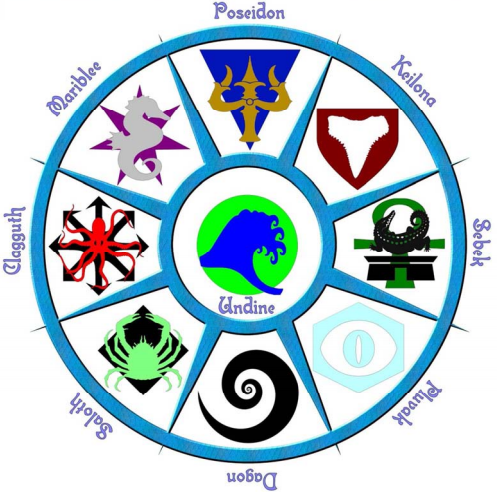
Religion
After six chapters of general new game rules, the actual campaign part of the Cerulean Seas Campaign Guide is at hand. First off: religion! There are exactly nine gods that are worshiped in the Cerulean Seas, which just so happen to coincide with the nine alignments of D&D and Pathfinder. The number of gods is enforced zealously by the Council of Nine, a group of priests who may be of wildly varying alignments but still all agree that pissing off the gods like the drylanders did before they were murdered with the Great Flood is in their best collective interests. There are also specific "official cults" of each of the nine religions that somewhat differ but are still sanctioned by the Council of Nine as a way of allowing specific races and cultures to keep their deities while syncretically fusing them into the greater whole of one of the nine. Can you really be considered a cult if you are sanctioned by the world church? I dunno, but it's the term the book uses, so I'll be using it as well. The nine deities are as follows.
Keilona:
Keilona, the Lawful Good goddess of holy war, sharks, and community cohesion, is depicted as being a gigantic mermaid with a pet Megalodon in tow and has blood red and white as her holy colors. If you couldn't already guess from that first sentence, "Lawful Good" in the case of Keilona's worshipers means "crusading Paladins". They are beloved in cities in spite of this– sure, they’re intolerant zealots who will bring down vigilante justice on “lawless” communities and refuse to stand for any satire or dissent against their religion, but hey, they’ll give you free housing and healing if you are of the same faith! Isn't that just peachy of them? Both of the official cults of Keilona are Lawful Neutral, with the sharkfolk worshiping the Megaladon Jadeel as the truest aspect of Keilona and the nommo feeling they are the only ones who are correct about Keilona's true nature which just so happens to be just as anal and archaic as they are.
Poseidon:
The Neutral Good and well-bearded god of nature, storms, nobles, and horses, Poseidon in the Cerulean Seas setting is painted more benevolently than one would usually see for a Greek god. His priests revere the hippocampus, shelter orphans, and replace stagnant water with running water because the former is seen as an abomination unto their god. The official cults of Poseidon are the Neutral Good cult of Mahilon, who worship the ancient kai-lio deity Mahilon (who was syncreticized as an aspect of Poseidon) and express nomadic freedom as another key tenet of their faith, and the Lawful Good cult of Neptune who focus on the social well-being aspect of Poseidon over the nature aspect.
Mariblee:
Mariblee is the Chaotic Good goddess of feykith and magic. Her priests are proponents of magic for the sake of magic and extoll the virtues of being humble but ambitious in learning its secrets. This priesthood also has a vast network of storehouses for magical knowledge from the various races kept safely tucked away just in case of the event of apocalypse or genocide. The Chaotic Good cult of Aear Emerwen is basically the same as the normal priesthood of Mariblee but with a heavy dose of elven nationalism, while the Chaotic Neutral cult of Sedna holds onto the selkie belief in a gluttonous trickster goddess in the only form they could after being forced to convert to the worship of Mariblee.
Sebek:
Lawful Neutral and well-known as the god whose patrons hold the greatest sway in the Council of Nine, Sebek is seen as an adherent of loyalty and perseverance. Both of its cults are barely autonomous due to the fact that the sebek-ka won't tolerate that shit and that the religions in question were particularly hard to subjugate in the first place. The Lawful Neutral cult of Halbok was more or less fantasy-Islam before the drylanders and genies that worshiped it were either killed in the Great Flood or accepted the offer of very limited but nonetheless existing influence within the Sebek religion, while the ancient True Neutral dragon god Scalis was absorbed into Sebekism under the ultimatum of "you should join us, it would be a
shame
if we let all these dragon-slayers run wild instead, wouldn't it?".
Undine:
The True Neutral goddess of the ocean, Undine, is worshiped in a manner that can basically be summed up as Taoism but with a hard-on for whales and dolphins as the most enlightened beings. The Neutral Good cult of Hefring is a bit more optimistic and tends to be proactive with helping sailors and fishermen, while the cult of Ondine felt that o was a better letter than u and living out in the wilderness as sea-hippies was the best way to practice their religion.
Clagguth:
The Chaotic Neutral octopus god Clagguth sounds like a fun guy, given that his tenets are freedom, following your heart, and trolling the priests of other religions whenever possible. His two cults also happen to be the most widely different from each other. The Chaotic Good cult of Guthlak focuses less on disruptive fun and more on good old-fashioned hedonism, while the Chaotic Evil cult of Thulu (Cthulhu is in regular Pathfinder, you know, no need to do the name thing there) is all about torture and vivisection and terrorism and cannibalism and all that jazz.
Pluvak:
Pluvak's the Lawful Evil god of tyranny. He likes slavery and people sell their soul to him in spite of the fact that they end up getting the raw end of the deal because he's the
fucking god of tyranny it's right in his name you fools.
The Lawful Neutral cult of Dijo is adhered to by selkies and conducts a yearly sacrifice of one of their own members to ensure that the unmelting ever-ice doesn't suddenly fail and cause their iceberg city to melt in the tropical waters, while the Neutral Evil cult of Vanak is made up of undead obsessed with making more undead instead of the whole "deal with the devil" thing.
Dagon:
This giant sahuagin is the Neutral Evil master of cold, calculating malice. He's still pretty pissed about the whole sahuagin losing the Blood War and being massacred thing, but is willing to play the long game as his priests infiltrate the civilizations of Good and Neutrality. The Neutral Evil cult of Leviathan focuses on destruction and the dark side of war, while the Chaotic Evil cult of Typhon is more or less just regular Dagon worship but with more tentacles due to a love of body modification because chaos.
Saloth:
Last, and definitely actually the least, the Chaotic Evil deep drow goddess Saloth is literally a non-product identity version of Lolth. Instead of a spider body, she has a spider
crab
body, because ocean setting! Get it?
 The Chaotic Evil cult of Morganae that is the same off-brand Lolth worship but with nucalavee instead of drow and the Neutral Evil cult of Sarla is implicitly stated to be a dumbed-down version of Saloth worship for the boggers because they are big dumby dumb-heads who were too dumb to engage in regular Saloth worship but wanted to anyway due to the fact that the Council of Nine wiped out all of their original religious leaders.
The Chaotic Evil cult of Morganae that is the same off-brand Lolth worship but with nucalavee instead of drow and the Neutral Evil cult of Sarla is implicitly stated to be a dumbed-down version of Saloth worship for the boggers because they are big dumby dumb-heads who were too dumb to engage in regular Saloth worship but wanted to anyway due to the fact that the Council of Nine wiped out all of their original religious leaders.
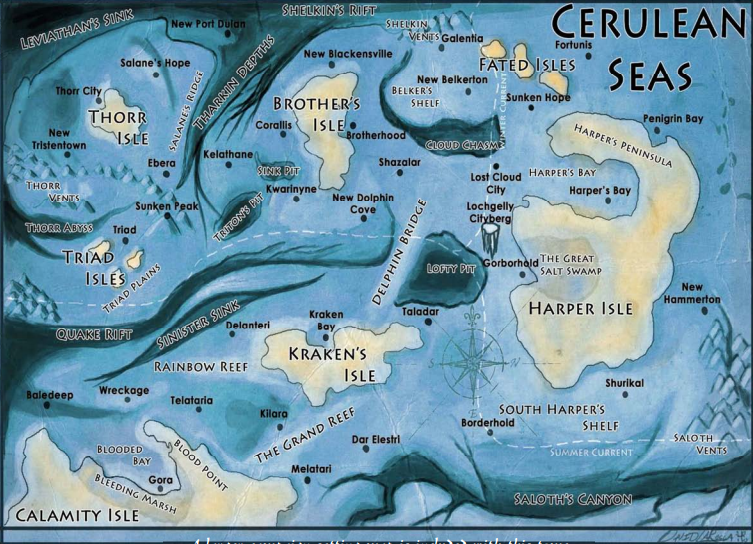
Cities of the Cerulean Seas
In the world of Cerulean Seas, cities can basically be divided up into (and, in fact, are divided up into) five different categories. First, you've got your sunken cities, which are the wrecked shit that's left over from the time of the drylanders that ended up being inhabited by underwater beings. Most sunken cities were made by the Halbokians, the not-Arabs who practiced the not-Islam mentioned in the Sebek entry, and include the pirate strongholds Wreckage and Kraken Bay, the frontier fortress of Borderhold, and the manufacturing hub of Sunken Hope. The second type of city are coral cities, famed for being really pretty and grown as much as they are built, the main examples of which are the cindarian capitol of Corallis and the sea elf capitol of Dar Elestri. Similarly, the naiads grow kelp cities that are typically close to shore and shared or bought out by anthromorphs such as the mogogol and sebek-ka. The last two types of city are unique ones – the selkie city of Lochgelly is the sole example of a city carved out of an icerberg of ever-ice, while the legendary triton kingdom of Shazalar is made out of enchanted glass that’s as hard as steel. None of the cities listed have that much actually said about them, which is both a good and a bad thing in my opinion. On the one hand, it allows you to insert what you want if you're the type of GM who likes to heavily modify whatever you want without diverging from "canon" rather than play a more rigid setting. At the same time, though, if you're in a hurry and want some quick "this is what happens here" hooks then the lone statement that Corallis is the capitol of the cindarians and carefully guarded may not do you much good. This is admittedly a problem with any setting that doesn't assume that the setting is mostly Earth as we know it or historically knew it with some changes here and there, but it's still worth bringing up.
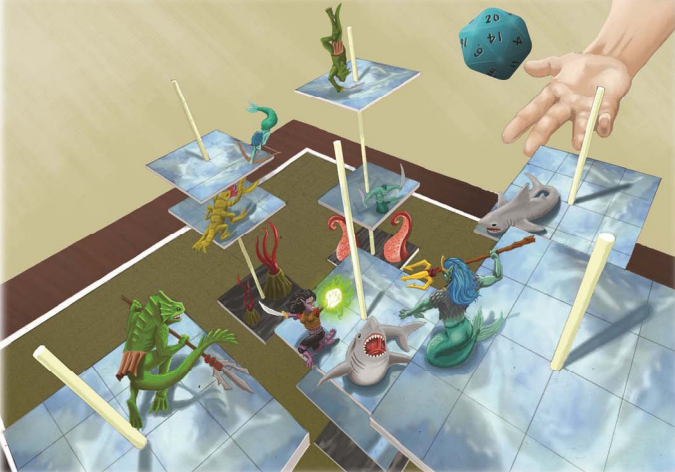
Gamemastering Under the Sea
While chapter 8 starts out with a guide to converting existing material to use the racial buoyancy and depth tolerance rules followed by a DIY on how to create the 3D battle mat monstrosity you see illustrated above, I figured I'd actually note it isn't just number crunching and craft store item lists. While probably more suited for the last chapter, the majority of this chapter covers the lands beyond the warm waters of the Cerulean Seas that can become potential adventures. Some of these are in the material realm, including the north and south pole (which we'll be touching in Indigo Ice, of course), the lost world of Devonia where drylanders and prehistoric beasts still live, the fabled large island chain of the Frista Mountains that is sought after by those that can live on land as well as the water, and the mysterious sebek-ka homeland of Tel-Am-Karu. Your options are even broader if you want to get cosmological. While there is no Elemental Plane of Fire, the other elemental planes do indeed exist and have their own pairs of “tertiary planes” – the Planes of Ooze and Magma (Earth), Ice and Steam (Water), and Electricity and Sound (Air).
There are also extraplanar oceans in the far realms that play host to a number of creatures from beyond. The fetid and icy sea of Kokytos is the realm of trapped demon, the realm of Lethe is filled to the brim with waters that wash away all memories and allow demons and angels alike to dwell together as blissfully ignorant amnesiacs, the great Okeanos brims with celestial sea life, the acidic Phlegethon is the home to watery daemons, devils are birthed from the titanic rotting swamp of Stygia, and the old gods and demons of the sebek-ka dwell in the great flowing plane of Yam.
========================================================================================================================================
Next time: encounter sea dragons, slimy slug-men, prehistoric placoderms, and more in the last, largest, and my personal favorite chapter in this and any other RPG book: the bestiary!
Here There be Dragons...and Dinosaurs...and Deep Drow...
Original SA post
Part 5: Here There be Dragons...and Dinosaurs...and Deep Drow...
There are a total of 93 monsters in the Cerulean Seas Campaign Guide. If you’re thinking that’s a lot of fucking monsters for a core guidebook to a campaign, you’d probably be right, but I’m a sucker for monsters and can’t really argue against the authors’ plea that there was a dearth of sea monsters in Pathfinder at the time the title was written. This does, however, mean that I’m going to have to split up the bestiary into three different posts, lest we be overwhelmed with entries all at once. Why three? Because it sounded nice, and because the early and late letters in the alphabet have a glut of entries compared to the more spread out mid-letters.
Viridian Algoid (CR 6 Large Plant): Our very first entry is a new version of a very, very old monster – one that’s been around since the beginning, in fact. The algoid originally appeared in the First Edition Dungeons and Dragons Fiend Folio way back in 1981 and can best be described as freaky psionic Swamp Things. They were hive-mind creatures that had the power to control trees as well as big, beefy (weedy?) fists that could stun foes, and eventually ended up entering the domain of Open Game Content come 3E courtesy of the Tome of Horrors. These are not quite the same algoids. No, viridian algoids are definitely not a case of things being better down where it’s wetter. These angry hunks of seaweed have none of the supernatural powers of their marsh-dwelling ancestors and, bucking the trend of “make something smarter = make something more civilized”, are solitary and violent ambush predators in spite of having a higher Intelligence score than true algoids. Viridian algoids also have wood-like claws instead of punching slam attacks and are resistance to piercing and slashing attacks while more vulnerable to bludgeoning attacks.
Barracuda (CR ½ Medium Animal) and Dire Barracuda (CR 2 Large Animal): The barracuda is, of course, a real life creature and needs no introduction. The dire barracuda, however, is a rather disturbing creature that has thick serrated plates rather than typical scales, a length nearly double that of the 6 foot great barracuda, and a tendency to get enraged by shiny objects rather than merely attracted by them.
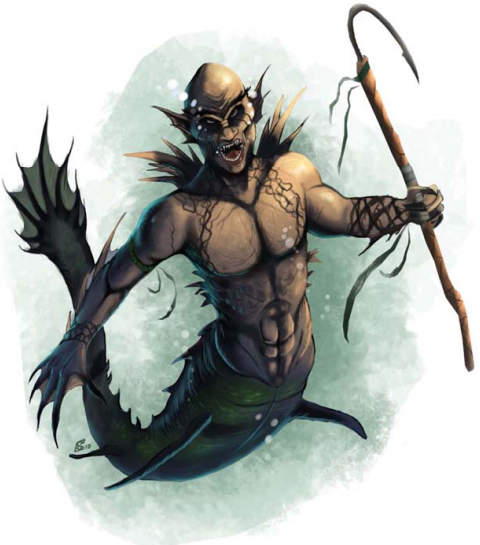
Bogger (Class level-dependent Small Humanoid): Sort of a stand-in for goblins and orcs, the boggers are seafolk who were twisted into shriveled, feral versions of their once human-like forms due to their devotion to Saloth in her dumbed-down incarnation Sarla. With racial ability score modifiers of -2 to Strength and -4 to Charisma but +2 to Dexterity and Constitution, you can probably correctly guess that they are destined to usually become Rogues, but these evil beings are also accomplished sea cat cavalry riders. Why? Why not, I guess.
Giant Coelacanth (CR 7 Large Animal): A giant version of everybody's favorite deep sea living fossil. Nobody likes the taste of them, but they definitely like the taste of drow and nixie and have the vacuum suction "breath weapon" to get what they want when they suddenly appear out of nowhere in the deep. Some people want giant coelacanth oil because it works as a shark repellant. Oh, and for whatever reason this entry has a statement of "oh, if you want the real world coelacanth just slap the Young simple template on the giant coelacanth", rather than actually getting a normal and fantastical entry side by side like most animals.
Coral Shepherd (CR 8 Huge Plant): Literally treants but with coral instead of trees. The only real difference in stats is that these guys are vulnerable to cold rather than fire and they are capable of delivering stinging coral disease with their slam attacks. The cindarians are the only sapient race that the coral shepherds tolerate.
Boil Crab (CR 1/2 Small Vermin) and Giant Hermit Crab (CR 3 Medium Vermin): Boil crabs are really warm dog-sized crabs that deal 1d4 steam damage to melee attackers, while the giant hermit crab is a human-sized...well, hermit crab. Neither are particularly inclined to attack unless they're attacked first.
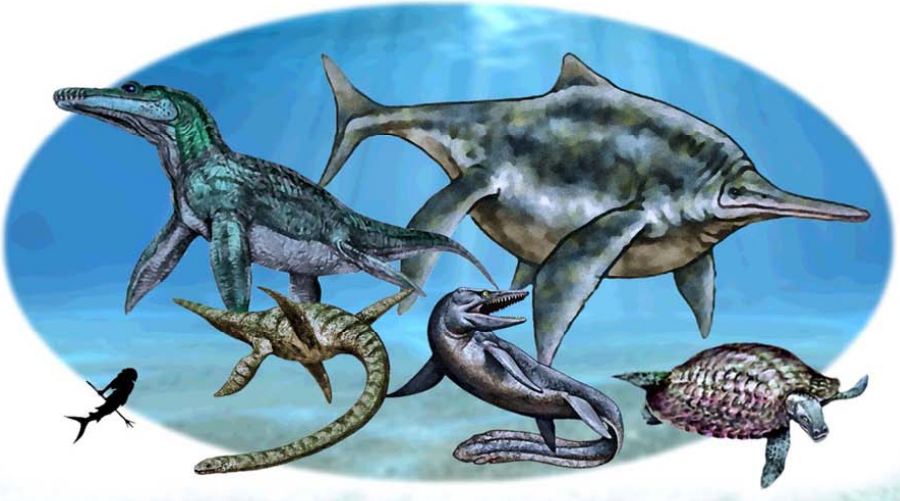
Dinosaurs – Cryptoclidus (CR 7 Huge Animal), Henodus (CR 6 Huge Animal), Liopleurodon (CR 9 Gargantuan Animal), Shonisaurus (CR 10 Gargantuan Animal), and Taniwhasaurus (CR 8 Huge Animal): As pedantic as I am about prehistoric life, let's just get it out of the way and state that the book addresses the incorrect nature of this entry.
Cerulean Seas Campaign Guide posted:
Technically, there is no such thing as an aquatic dinosaur. All members of the class Dinosauria were strictly terrestrial. However, there are many types of large marine reptiles that lived during the age of dinosaurs that are often put into the same category as dinosaurs. In the Pathfinder Roleplaying Game Bestiary, you were introduced to the elasmosaurus, which falls under this RPG equivalent of "aquatic dinosaur."
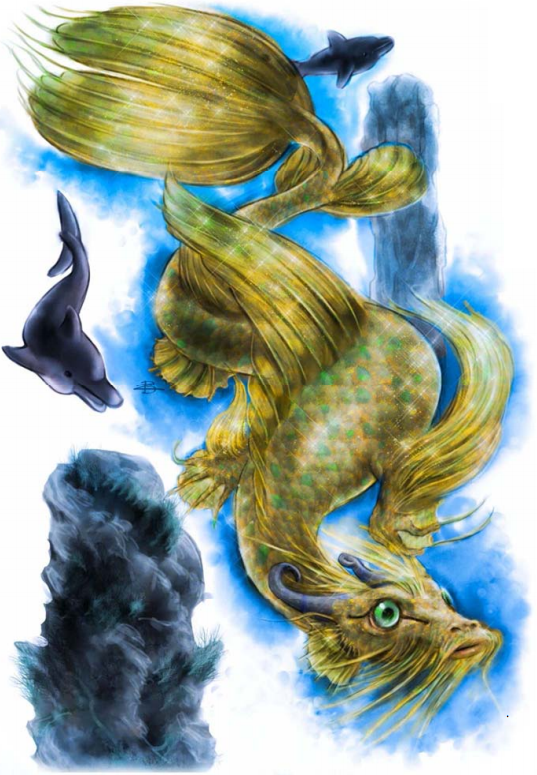
Song Dragons: The watery descendants of the now almost extinct chromatic and metallic dragons, the song dragons vary in alignment but are all tied together by having a sound-based breath weapon. Since these are dragon, and they have such variety, I'll be bullet pointing out these with a note on the size and Challenge Rating range of the stat blocks given from wyrmling to ancient.
-
Cacophany Dragon (CR 3 Tiny to CR 16 Huge Dragon):
Fat, lazy, and ornery, the Neutral Evil cacophany dragons look like the union of dragon and toad. An individual's modus operandi is "sit in swamp wallow, bully people to get free food". Their approach to combat is just about as labor-intensive, favoring the use of their constant leaking poison, deafening croak breath weapon, ability to transform mud or even solid ground into quicksand, or debilitating spell-like abilities such as cause fear, vampiric touch, and ghoul touch. A cacophany dragon can technically fly, but it won't ever do so unless it has no choice.
-
Choral Dragon (CR 5 Small to CR 20 Gargantuan Dragon):
The Chaotic Good choral dragons resemble particularly big dragon turtles that have entire reefs growing on their shells. This means that the
choral
dragon is also a
coral
dragon. Get it?
 Designer puns aside, choral dragons are actually pretty terrifying. Their sonic damage breath weapon may be standard, but what isn't so standard is the fact that they can shoot out spores that are capable of transmuting flesh into coral. It's a good thing they're known for their patience and willingness to forgive.
Designer puns aside, choral dragons are actually pretty terrifying. Their sonic damage breath weapon may be standard, but what isn't so standard is the fact that they can shoot out spores that are capable of transmuting flesh into coral. It's a good thing they're known for their patience and willingness to forgive.
-
Crescendo Dragon (CR 4 Tiny to CR 17 Huge Dragon):
Looking like particularly thorny ichthyosaurs and capable of releasing sparks of electricity from luminescent spots on their bodies, crescendo dragons are the True Neutral representatives of the song dragon group. They are also kind of the random factor of the song dragon group – their whole gimmick is that they like dolphins and orcas. [i]Really[i] like them. They lead pods, act similar to their adopted families, and like to make little half-dragon dolphin/orca babies.
-
Harmony Dragon (CR 2 Tiny to CR CR 15 Huge Dragon):
These Chaotic Good song dragons are the most physically like land dragons, being akin to a Chinese dragon with goldfish mixed in as you might be able to tell from the image that heads this list. A harmony dragon has a breath weapon that shoots bubbles that float opponents away, can make a bite attack that does the same weird transport bubble instead of damage, and is generally averse to combat as opposed to escape. These dragons do love sharing their magical knowledge or giving out advice, however, so they make good NPC allies.
-
Hush Dragon (CR 3 Tiny to CR 16 Gargantuan Dragon):
The abominable fusion of dragon and anglerfish, the Neutral Evil hush dragon's name comes from the fact that it exudes an aura of pure noise cancellation. It can also breathe out freezing methane gas, swallow creatures even a size category larger than itself, become invisible in the darkness of the abyss, and attract creatures with a magical aura attached to its angler light.
-
Melody Dragon (CR 4 Tiny to CR 17 Huge Dragon):
Weird Lawful Good catfish-dragons that go on undersea crusades to slay evil sea monsters. Not even joking there. The weapons in its arsenal include a vacuum suction attack, paralyzing breath weapon, magma breath weapon, aura of extreme water pressure, and the ability to turn its color patterns into runes to cast spells.
-
Rhythm Dragon (CR 4 Small to CR 17 Gargantuan Dragon):
Unlike the crescendo dragon, the similarly True Neutral eel-like rhythm dragons have no love for a random sea animal. Instead, they have a love for themselves, and their selfish nature drives them to manipulate others. And hey, would you look at that, they just so happen to have a lot of manipulating powers - a bite that can cast dominate monster, hypnotic pattern-shifting scales, a breath weapon that causes involuntary convulsions on a failed Will save, and blood that forces a Will save to avoid losing 1d4 points of Wisdom on contact.
-
Scream Dragon (CR 5 Small to CR 18 Gargantuan Dragon):
The most banal form of Chaotic Evil, the red shark-faced scream dragon is a violent monster that loves blood and gore. Their powers back up that violent attitude, with a sonic damage breath weapon and a breath weapon that shoots boiling steam, razor sharp scales that deal damage to foes attacking with their bodies, an entourage of sharks (which they will eat if they are bored, because chaos or whatever), and if they are all the way up to great wyrm in age they can just simply force a save-or-suffocate effect that drains all the oxygen from nearby foes' blood.
- Thunder Dragon (CR 6 Medium to CR 19 Colossal Dragon): Yet another True Neutral dragon? Whatever, I guess. The thunder dragons are like spiky whales and like treasure a lot. They are capable of creating various water hazards such as vortexes and rogue waves, have an electrical aura around them, and...that's about it, really.
Giant Cerulean Dragonfly Nymph (CR ½ Medium Vermin) and Tunneler Giant Dragonfly Nymph (CR 3 Large Vermin): One is the nymph of a giant dragonfly, the other is the same thing but bigger and shoots acid. Hooray.
Reef Drake (CR 1 Tiny Dragon): Take the pseudodragon stats from the Pathfinder Bestiary, replace fly speed with swim speed, give it a disorienting breath weapon instead of sleep stinger, and you have the reef drake. To be fair, it also does have some fluff differences in that it is ill-tempered and will only act as a familiar as long as they are being fed, cared for, and not put into stupid situations.
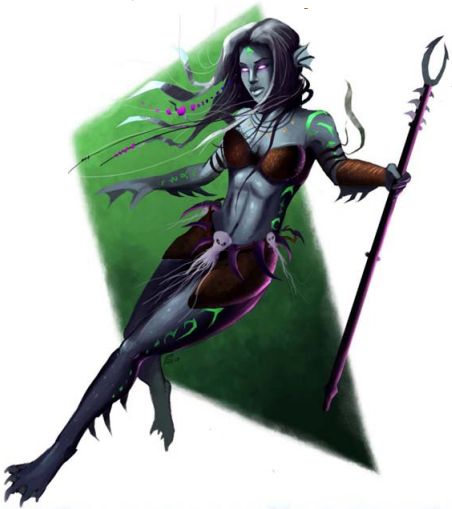
Deep Drow (Class level-dependent Medium Humanoid): Don’t let the tattoos and glowing bits in the art fool you – the deep drow are not the magical masters their drylander ancestors were. Instead of any innate spell-like abilities, they exude a nauseating toxin that gives them some modicum of safety against the insanely freakish predators of the abyss. Light blindness and sensitivity to water pressure above 500 feet in depth means these beings are limited to the deep, dark recesses of the sea. They’re purely the same as classic drow culture-wise, though, right down to the matriarchy and obsession with
Dire Electric Eel (CR 8 Large Animal) and School of Electric Eels (CR 5 Fine Animal Swarm): Electric eels that have adapted to saltwater. One’s big and vicious, the other’s smaller than your average electric eel and travels in a swarm. Both are shocky zappy.
Sound Elemental (CR 1 Small to CR 11 Huge Outsider [Elemental]): A freaky invisible disembodied skull that goes around making all sorts of racket with their natural ability to mimic any sound. The fact that their punches actually deal sonic damage through painful vibrations is certainly a thing too.
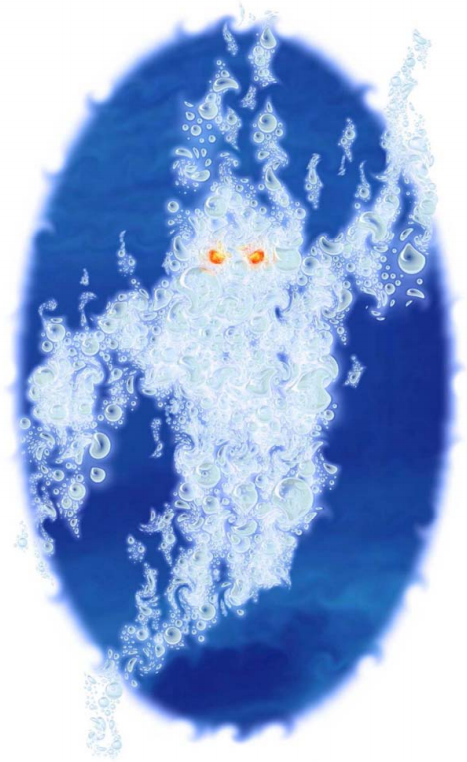
Steam Elemental (CR 1 Small to CR 11 Huge Outsider [Elemental]): You could say that there are two very different sides to these bubbly monsters – they’re quite calm and pleasant most of the time, but become sadistic and pain-loving in combat. Steam elementals deal steam damage, of course, but are more notable for the fact that they can travel on land, in the air, and through the water all at equal speed, making them masters of maneuvering.
========================================================================================================================================
Next update will be looking at F through L, including huge rock lobsters, freaky fish-imps, and horses of the sea.
From Fanciful Familiars to Ornery Oversize Otters
Original SA post
Oh shit, Castle Falkenstein, now we're talking. It's probably one of the best and most well-researched modern attempts at Victorian fantasy around and well received enough to get both its own system and a GURPS rendition. I'll definitely be looking forward to your posts on the topic.
Humbug Scoolbus posted:
Louis Porter is a mega-douche so you're indignation is still partially valid.
This is dirt I'd love to know more on.
This is also a post that should probably have some actual new content from me, so here we go.

Part 6: From Fanciful Familiars to Ornery Oversize Otters
Alright, it's time to get back to the monster mash after yet another long hiatus on my part (yes, those are quite common, it was totally worth the free character build points). Last time, we went through the letters A to E, including goblin mermen, dragons horny for dolphins, and angry algae. This time we'll be going from F to O, as you might have guessed.
Familiars, Aquatic
As with the dragons before, this is a case where there are so many entries I kind of have to split things up with a bullet point listing rather than a small set of notes for the smaller groups like the "dinosaurs" from earlier.
-
Caiman (CR 1/6 Tiny Animal):
I'm not sure what kind of caiman the authors have been measuring, as even the tiniest of caiman species edge into size Small, but whatever. The sharp toothiness grants a caiman’s master a +3 to Intimidate checks, which is a bit funnier when you take into account the fact that the book says the caiman’s stats can also be used for marine iguanas. Because we all know how fierce marine iguanas are.
-
Crab (CR 1/2 Tiny Vermin):
These stats are apparently supposed to be used for hermit crabs and lobsters, which makes me wonder what sort of terrifying doom-hermits the authors have encountered to deem them as deserving a higher Challenge Rating than a caiman. You get a +2 to Fortitude saves with a crab as your familiar.
-
Cuttlefish (CR 1/2 Tiny Animal):
In addition to being adorable, cuttlefish are clever, capable of camouflage, and other things that exemplify the cephalopods. Indeed, there are minor change notes to change the stats to a familiar that is a nautilus, octopus, or squid of the same size. As is befitting these slippery devils, the master is granted a +3 to Escape Artist checks.
-
Fish (CR 1/6 Tiny Animal):
Any fish between 1 and 2 feet in length, be they a dainty darting reef fish or a toothy-mawed anglerfish – hell, the book even says these stats are used for seahorses,
seahorses
!– get these same stats with a bite attack that deals the same damage as a knife and a boon to their master of a +3 to Acrobatics checks.

-
Frog (CR 1/8 Diminutive Animal):
Stated to also be applicable to newt stats, in case you want to your baleful polymorpher to constantly bring up Monty Python. The master’s benefit is literally a free case of the Toughness feat with 3 extra hit points.
-
Jellyfish (CR 1/4 Tiny Vermin):
With a weak Dexterity-damaging poison, one can assume that these aren’t box jellies. The stats are also applicable to sea anemones if you remove the move speed, or so the text says. The master gains a +2 bonus to Will saves thanks to the jelly’s brainlessness.
-
Muskrat (CR 1/2 Tiny Animal):
Ah, the muskrat, that chubby water-dwelling North American vole once popular in the fur trade. Not only is it somehow tougher than a caiman, it is also apparently well-suited to being used for otter stats according to the fluff box. Not, say, the nutria, a distantly related rodent that happens to have convergently evolved to be similar to the muskrat, but the sleek and slender river otter. A +2 bonus to Reflex saves is your benefit for having one of these as familiars.
-
Sea Snake (CR 1/2 Tiny Animal):
Sea snakes aren’t what sticks out in this entry so much as the statement about changing the stats to reflect eels. The recipe? Remove hold breath and poison, add an electrical discharge. Yes, because your average small oceanic eel is the same as the vaguely eel-like knifefish of the great rivers. A sea snake or eel familiar grants a +3 bonus to Bluff checks, because snakes are really good at poker or something.
-
Snail (CR 1/8 Diminutive Vermin):
Man, it must really suck to go to the wizard con with a snail familiar. “My familiar’s a caiman. Gnarly, toothy, once bit a rogue’s foot clean off. What’s your familiar do, Joe?” “...I hate you all
so
much.” If you want to be even more impotent, the stats can also double or the less defensive sea slug or the barely mobile clam. But hey, it conveniently provides a +3 bonus to Stealth for its master, so you can more easily hide your shame.
-
Starfish (CR 1/8 Diminutive Vermin):
While just as impotent as the snail, the starfish at least gets bonus points for being nearly immortal thanks to regeneration bypassed only by fire, magic, or steam damage. The benefit for the master from a starfish familiar is a +3 to Heal checks.
-
Tern (CR 1/6 Tiny Animal):
These stats are used for tern, seagulls, and other fluttering shorebirds, as well as penguins if you remove the fly speed in exchange for a swim speed. Strangely enough, they also suggest that you can use these stats for ospreys if you boost the claw damage it deals, rather than just using hawk stats from standard Pathfinder. These sea birds will net you a +3 to Perception checks.
- Turtle (CR 1/6 Tiny Animal): Last, but not least due to the whole snail snafu, is this generic unspecified turtle. It gives you a +1 bonus to Armor Class, because of course it would, it’s a turtle.
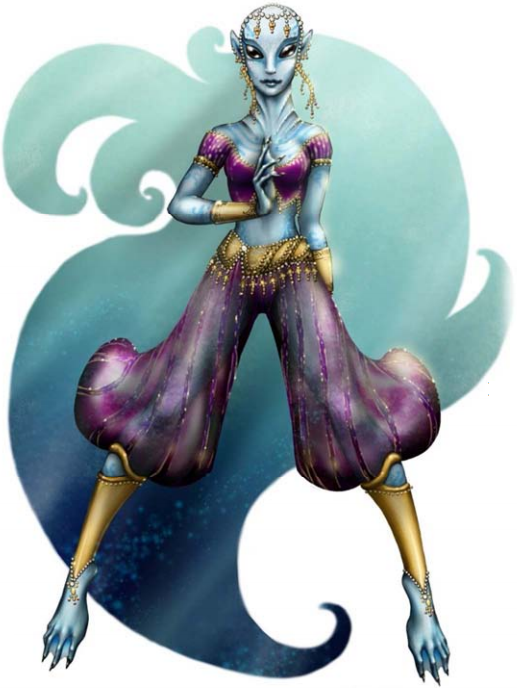
Genai (Class level-dependent Medium Humanoid)
What happens when you take humans and marid genies and mate them a lot? These guys, obviously, or I probably wouldn't have brought it up. They are known for being extremely patient and calm, quiet and introverted unless you somehow manage to piss them off enough that they show their bloodthirsty and vengeful side. Almost the entire population of genai in the Cerulean Seas region come from one city, Harper's Bay, the rest chilling with their marid parents in the Elemental Plane of Water. Genai characters get a +2 to Dexterity and Constitution at the cost of a -2 to Charisma, a free Improved Initiative feat, and the ability to cast swift retreat ( expeditious retreat by any other name) three times a day and undertow ( gust of wind , but underwater) once a day.
Hippocampus, Reef Horse (CR 1 Large Animal) and Sea Pony (CR 1/2 Medium Animal)
While standard Pathfinder envisions these aquatic creatures of Greek mythology as Magical Beasts, but Cerulean Seas decides they are normal enough to qualify as Animals. The reef horse is the normal Poseidon cart-pulling style hippocampus, while the sea pony is a smaller variety bred either to be pets for sea elves or as mounts for size Small aquatic races.
Remora Imp (CR 1/2 Tiny Magical Beast)
In spite of the name, these freakish fish-lizard creatures with humanoid hands are not actually a type of devil, instead being genetically engineered by the sahuagin to act as hands for the awakened sharks known as the carchardians. When the carchardians rebelled, the remora imps went with them, continuing to do menial tasks for their masters because they literally cannot survive on their own. Some of these creatures that lost their carchardian masters managed to find ixarcs (awakened stingrays) before they ended up dying, bonding with them instead.

Stygian Imp (CR 2 Tiny Outsider)
Oh hey, an actual imp. Stygian imps come from the River Styx and smell like a mix of methane and sulfur. While that may be typical demon stuff, their lamprey-like heads and bioluminescence certainly aren't. Stygians are also far more rude and crude than land imps and prefer to go straight to the painful tricks over any scheming and subterfuge. To these ends, a Stygian imp can become invisible at will, transform ino a barracuda, giant lobster, muskrat, or albatross, and its bite has a venom that deals cold damage because why not it's a magical devil creature. Those omnipresent sages of D&D/Pathfinder bestiaries theorize that the reason Stygian imps are so common in the deep sea is that devils get tired of their shit and throw them into the material plane like a bunch of spam mail.
Jellyfish, Goliath Jellyfish (CR 1 Medium Vermin) and Jellyfish School (CR 4 Diminutive Vermin Swarm)
A particularly big jellyfish and a swarm of generic jellyfish, respectively. Not much to say about them.
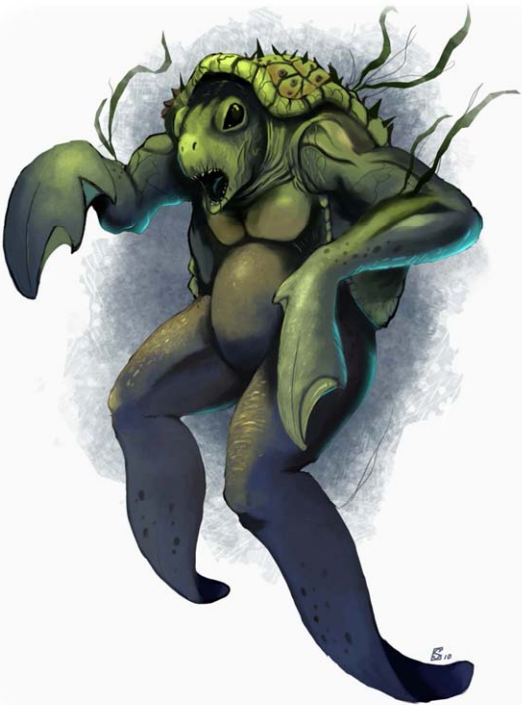
Halbokian Kappa (CR 3 Medium Monstrous Humanoid)
These anthropomorphic sea turtles used to be called the turtlefolk before the sebek-ka decided "hey, these guys look vaguely like the glorious and benevolent kappa from our pre-Flood creation stories, we'll call them that". Unfortunately for the sebek-ka, they quickly learned that the Halbokian kappas are actually colossal shitlords that love to pillage, enslave, and generally be Evil. Rather than being an orc-style marauding horde, however, these sinister sea creatures are an entire species of mercenaries, doing their evil deeds for the highest bidder. Their only taboo is that they hate people who despoil nature, so necromancers and industrialists are blacklisted for kappa services.
Lampreys, Dire Lamprey (CR 1/2 Tiny Magical Beast) and School of Lamprey (CR 1 Diminutive Vermin Swarm)
I'm fairly sure that 1. lampreys being the size of lampreys doesn't count as "dire"; and 2. lampreys should be Animal, not Magical Beast or Vermin. This is kind of a dumb entry.
Lobsters, Giant Lobster (CR 1 Medium Vermin) and Phantom Lobster (CR 5 Large Magical Beast)
One's a man-sized lobster, the other is a teleporting invisible giant lobster that is supposedly the degenerate descendant of a tribe of sapient sea scorpions. Together, they
Morganite Nucklavee (CR 4 Large Fey)
The nuckalavee from Pathfinder Bestiary 3 is closer to the Celtic folklore of the creature and is more interesting in its abilities, you should use it instead.
...Oh, okay, I guess I should at least go into some detail on these guys. Morganite nucklavees basically look like mer-orcs and have a gaze attack that can induce rage in people. They are violent brutes who hate elves most of all, and they worship the Morgana aspect of Saloth, which is how they get their name.
Otters, Dire Otter (CR 2 Medium Animal) and Sea Otter (CR 1/2 Small Animal)
Both of these are real animals, or at least sort of. The sea otter is self-explanatory, but the dire otter is a bit of something you have to read between the lines for. It's stated to be man-sized, chocolate brown in color, short-snouted, small-eared and very vocal even for an otter. These are all big indicators of Pteronura brasiliensis , the giant river otter of the Amazon, to the point that I'm not sure why they wouldn't just up and say it's a giant river otter.
Up Next Time...
Prehistoric plate-mouthed fish, awakened sea creatures, sharks and rays, titans who may or may not clash, and ridiculously large whales as we get through the final pages of the Cerulean Seas Campaign Guide.
It Ends Here
Original SA post
Part 7: It Ends Here
Alright, let's finish this, once and for all...until the expansion sourcebooks. It's time for the Cerulean Seas Campaign Guide's bestiary chapter, sections P to W, because fuck the XYZ trio apparently.
Piranhas, Giant (CR 3 Medium Animal) and School (CR 3 Diminutive Animal Swarm)
Most animal entries in Cerulean Seas tend to be written in a matter-of-fact manner that doesn't give the same sort of legendary air to them that the actual supernatural beings in the title get - the piranha is an exception to this. We get the hyperbolic toothy terror piranha here, who "all inhabitants of the Cerulean Seas knew of, and feared", and a damage yield that most animals could only dream of. A piranha swarm deals 2d6 damage normally, and doubles that total if their target is nauseated (wha?) or helpless. Why is the piranha treated so differently from any other animal in the Cerulean Seas Campaign Guide?

Giant piranhas do a more sedate 1d8 damage, but hunt in large packs. They also have ridiculous eating habits:
Cerulean Seas posted:
While it is an extremely dangerous fish, it is also completely untamable, and worse… insatiable. Unlike a shark which will take its fill and leave, a giant piranha will eat until it regurgitates, and then it will eat again. A school of these monsters can be particularly lethal.
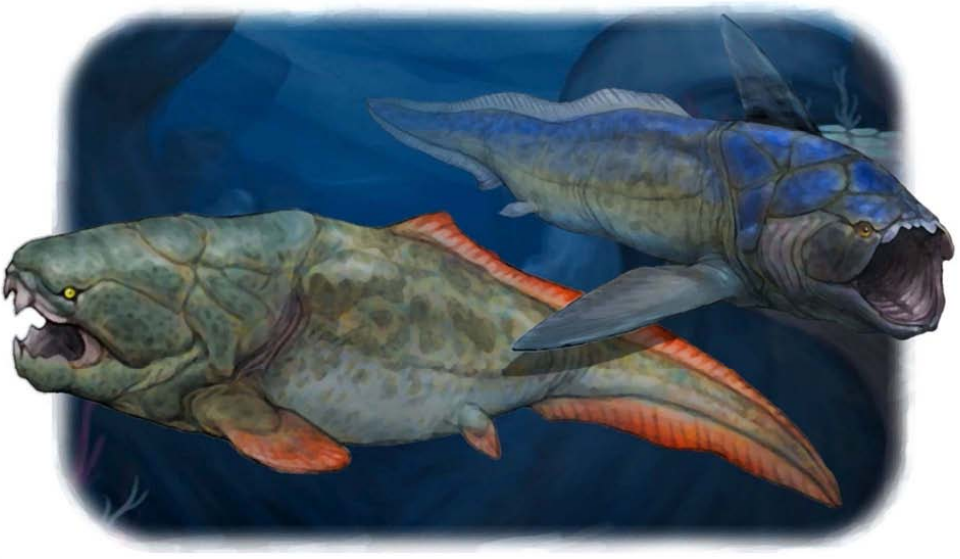
Placoderms, Dunkleosteus (CR 9 Huge Animal) and Titanichthys (CR 7 Huge Animal)
Back in the Silurian and Devonian periods of Earth's prehistory, the placoderm fish were the new hotness. Not only were they experimenting with this new-fangled "jaw" technology, their heads and bodies were armor plated to boot. While they technically ranged all the way from just under a feet in length to "holy shit this is a big fish" in size, the pair presented in the Cerulean Seas Campaign Guide are of course two of the largest. You may recall Dunkelosteus from way back when I first started posting in FATAL and Friends with Broncosaurus Rex: it's popular as a large prehistoric predatory fish, and it's hard to blame anyone for picking out the 30 foot long tank-fish with bolt cutters for teeth. Titanichthys is nearly as large as Dunkelosteus, but far less famous simply because it was a filter feeder and nobody picks them first in bestiary soccer. The book gives Titanicthys the role of either big game fish or "whoops, your size Small character was swimming in a school of bait fish, it's vacuuming you now".
Sea Cats, Dire Merlion (CR 3 Large Animal), Guardcat (CR 1/3 Small Animal), Merlion (CR 1 Medium Animal), and Riding Cat (CR 1 Medium Animal)
If you thought just one type of sea cat in Dungeons and Dragons and Pathfinder was superfluous enough, I can only imagine how you must be feeling right now. These creatures are regular lions but underwater (and yet classified as the dire version nonetheless), a house cat but underwater, a somewhat smaller than usual underwater lion that is a solitary ambush predator in kelp forests, and a somewhat smaller than usual underwater tiger that Small races like to ride around on.
Seals, Common Seal (CR 1/3 Small Animal), Dire Seal (CR 5 Large Animal), Elephant Seal (CR 2 Large Animal), Sea Lion (CR 1 Medium Animal), and Walrus (CR 7 Large Animal)
I'm fairly sure this should be "pinnipeds", but whatever. Also a walrus has 10 HD but an elephant seal has 3, in spite of elephant seals being massive slabs of flesh. Why? Again,

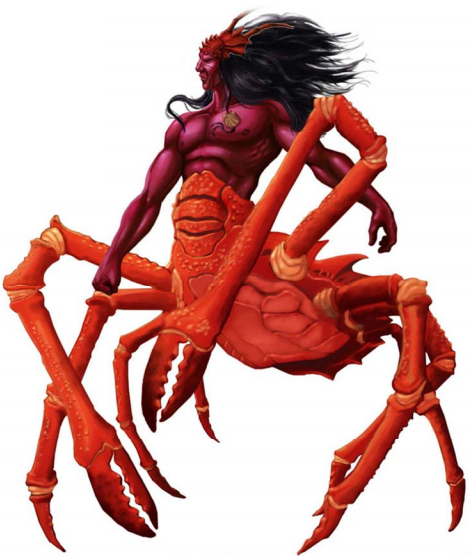
Sea Titans, Abyssal Titan (CR 11 Huge Humanoid), Ice Titan (CR 9 Large Humanoid), Maelstrom Titan (CR 13 Huge Humanoid), Marsh Titan (CR 7 Large Humanoid), Steam Titan (CR 10 Large Humanoid), and Tidal Titan (CR 8 Large Humanoid)
These oversized merfolk fulfill the role of the classic D&D/Pathfinder land giants of the various alignment stripes.
-
Abyssal titans (True Neutral) have the lower bodies of giant squids and are seldom seen, to the point that they are more legend than fact for all but the few people who have a brief encounter with them. Abyssals are also the largest sea titans, which is kind of weird given that another sea titan is literally part whale. Having a squid butt allows them to jet around and spew forth an ink cloud, and utilize those tentacles in combat, but that isn’t enough – no, they also have the ability to cast
ink
and
murk
as spell-like abilities when their natural ink is recharging and wield huge shortspears in their humanoid hands. They are probably the most divorced from the stone giants they are meant to be the aquatic equivalents of.
-
Ice titans (Neutral Evil) have the lower bodies of walruses and are known being greedy, lazy, and hateful. They came to the Cerulean Seas from the far north by stowing away on the great berg-city of Lochgelly and were promptly kicked out as soon as the selkies found them. Unsurprisingly, they happen to have the Cold subtype and an ice breath weapon to match their role as the frost giants of the ocean.
-
Maelstrom titans (Neutral Good) are baleen whale merfolk who once roamed the seas in massive numbers, but are now few and far between. It’s kind of weird that they are size Huge given that they have whale parts and are meant to be the oceanic equivalent of the Gargantuan size storm giants of old. They have the same weather- and electricity-related spell-like abilities as the storm giants and are proficient in all simple and martial weapons.
-
The marsh titan (Chaotic Evil) is the aquatic equivalent of the hill giant – dumb, angry, and completely geared toward melee powerhousing without any supernatural abilities. And boy, does the flavor text read them the riot act for it, stating that "their malice is reflected in their ugliness, faces twisted with hatred and rage."
As their lower halves belong to crocodiles, they get the ability to do a death roll when they grapple, tripping the foe while dealing 2d8 damage.
-
The steam titans (Lawful Evil) are the fire giant equivalents of the ocean, but much more interesting to look at because their lower bodies are giant spider crabs, some of the raddest dudes in the deep. While they hate everybody and live in heavily regimented military societies, evil races can apparently pay off steam titans to be their personal mercenaries and bodyguards. A steam titan, of course, can produce a steam breath weapon. Shocking, I know.
- Lastly, we have the tidal titan (Neutral Evil), guys with shark tails. They are the only sea titan that doesn’t really have a land giant analogue, though that doesn’t really matter as you can basically sum them up as “marsh titans only not stupid”. Their human level intellect doesn’t do them much good when they are nomadic predators who could probably hunt whatever they want but prefer humanoids as they “delight” in eating them for whatever reason.
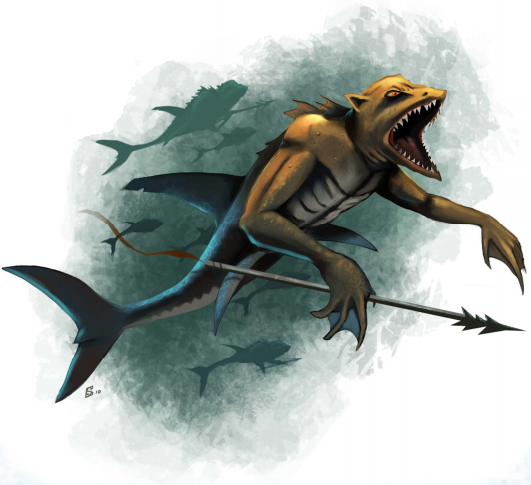
Sharg (CR 2 Medium Monstrous Humanoid)
The Chaotic Evil sharg are literally the only examples of the sahuagin not fucking up one of their war beast experiments and having said experiments blow back in their face. These guys are actually loyal to their masters, vast in number, ferocious in battle, and generally not another one to add to the failure pile. They have a Barbarian rage once per day, their bites deal bleedout, and they get a free 15 foot move action after a successful charge attack that allows them to quickly move across the battlefield. While shargs are “seemingly incapable of rebellion”, the carchardians act like asshole big brothers and think they can win over the shargs if they beat them up in combat enough times.
Sharks, Edestus (CR 7 Huge Animal) and Goblin Shark (CR 4 Large Animal)
An extinct and extant real world shark pair, these two oddballs provide a rather different shark encounter than your bulls, tigers, or great whites, definitely. The goblin shark is a deep sea predator known for being really fucking weird looking, with an extendo-mouth and cranial “horn”. And Edestus? Imagine a great white shark with a chainsaw blade jammed up in each jaw. Not only is it pretty dangerous to be bitten by that kind of equipment, it also makes this prehistoric shark look fairly freaky.
Slurg (CR 5 Medium Aberration)
For once, you’ve got an abominable eldritch creature that isn’t immediately evil. These slug-people are True Neutral and truly confounding, they seem content to do their own thing while attended to by an entourage of thralls. Are these beings willingly made thralls? Are they test subjects for extradimensional research? Are they simply classic evil overlord mind slave tactics? Nobody knows. The slurgs aren’t telling anyone, either, which doesn’t help to stall the oceanic rumor mill.
In addition to having the classic mental spell-like ability trio ( detect thoughts , charm , and suggestion ), slurgs have an aura of "mental static" that forces Concentration saves to cast spells and a particularly potent slime that forces a Fortitude save to avoid suffering a -2 penalty to all Will saves for an hour afterward. They also have a downright strange special quality – three times per day, their eyestalks can produce a light that forces a Will save. If you fail the Will save, you are nauseated for 2d6+2 round, but are also compelled to move toward the slurg every round you stay nauseated.
Squid, School (CR 2 Tiny Animal Swarm) and Swamp Kraken (CR 9 Gargantuan Animal)
Forget the school, they’re only meant as a distraction in combat against something else with their ink clouds. Instead, let’s talk about the swamp kraken, because it’s a fucking swamp kraken. While not a true kraken in the D&D sense of “smart squid overlord monster), these offshoots of the giant squid are capable of moving on land at a decent pace, have pseudo-lungs, and create a fog bank instead of an ink cloud. That is just so ridiculous it wheels immediately into the territory of awesome. I want swamp krakens to become a popular thing.
Stingrays, Dire Stingray (CR 2 Large Animal) and School (CR 2 Diminutive Animal Swarm)
Meh. It’s neat that they give out the factoid that young stingrays sometimes school together, I guess.
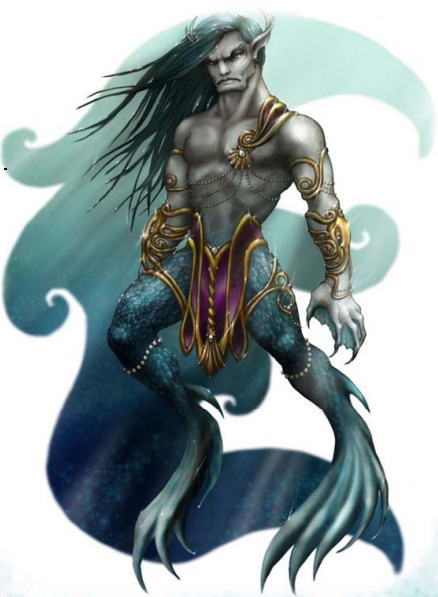
Triton, Shazalarian (Class level-dependent Humanoid)
Shazalarian tritons are different from regular tritons in most things other than appearance and a reverence of sea life. They are also literally birthed fully formed from the magic of the Elemental Plane of Water. Why? Nobody knows, but it's really weird, given that these guys are Humanoid with the class levels while the regular tritons are the ones with the Outsider creature type and natural HD. Perhaps the answers lie with whoever decided to have a playable no-HD Humanoid race stuffed in the bestiary section rather than the playable races section.
Whatever the reason for all the strange things about Shazalarian tritons, their stats are set in stone...and kind of dull stone, at that. They have a +2 to Strength and Wisdom but a -2 to Intelligence, can speak with all sea creatures, and have gills rather than lungs. The only somewhat interesting thing is that they can cast summon nature's ally I once per day. Doesn't sound too interesting? Well, it wouldn't on its own, but it is actually a dynamic racial trait, in that it levels up to its next spell up every other class level the Shazalarian triton gains. More races need dynamic racial abilities, they're a neat idea.
Trueform (CR +1 to +3 Template)
Have you ever wanted a quick and easy template for making awakened animals? Well, here you go. The type changes to Magical Beast, they get a +10 to Intelligence, +2 to Wisdom, and +4 to Charisma, they can use tools (that are applicable of course, there is no magical sprouting of limbs or anything), they can take class levels, and they can summon two of their base creature per day. While the carchardians (Lawful Neutral trueform sharks) and ixarcs (Lawful Good trueform manta rays) were both given discussion earlier in the book, the other examples of using the template don't really have any flavor text, just alignment and name. For the purposes of completionism, though, I'll note that the others are the delphin (Chaotic Good trueform dolphin), squibbon (Chaotic Neutral trueform octopus), and greater carchardian (Lawful Neutral trueform dire shark).
Turtles, Giant Leatherback (CR 4 Large Animal) and Marine Snapping Turtle (CR 6 Large Animal)
One's literally Archelon , the other is a terrifying adaptation of a freshwater predator. The marine snapping turtle isn't content to be as big as a cow and have a powerful bite (2d8+13 with a critical hit ratio of 19-20), it also has a swim speed greater than most playable races in spite of the flavor text assuring us they are “not too fast”.
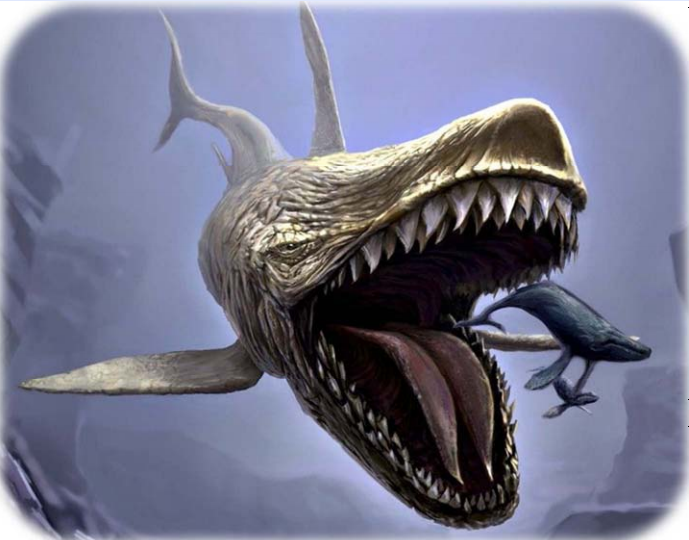
Whale, Dire Whale (CR 13 Colossal Animal) and Sperm Whale (CR 7 Huge Animal)
Look at that image. Look at that fucking image. That is a truly dire animal. Its stats back it up as well, with a massive 42 Strength score, 19 HD, and a 4d8 damage bite backed up by the aforementioned Strength score. Oh, and it has a 100 foot swim speed. Try outracing that.
The sperm whale? Eh. There’s already sperm whale stats in regular Pathfinder that have the correct size category rather than being shrunken down for no apparent reason, so I’m not actually sure why these stats are even here.
Simple Templates
The final thing we see before appendices that basically act as indexes is this, a small section on simple CR +0 templates tucked away like an unwanted child. Three of these are for converting land creatures into sea creatures to add them into the setting: Semi-Aquatic (creature still has lungs but can hold its breath for a fairly long time and is a better swimmer), Aquatic (creature is now fully amphibious), and Merped/Merfolk (creature is now fully amphibious and has a fish butt). The other template, Deep Sea Creature, takes an already amphibious or aquatic creature and shoves it into the abyssal plain, giving it an insane depth tolerance of 5,500 feet and darkvision at the cost of having pressure sensitivity for water 300 feet or shallower.
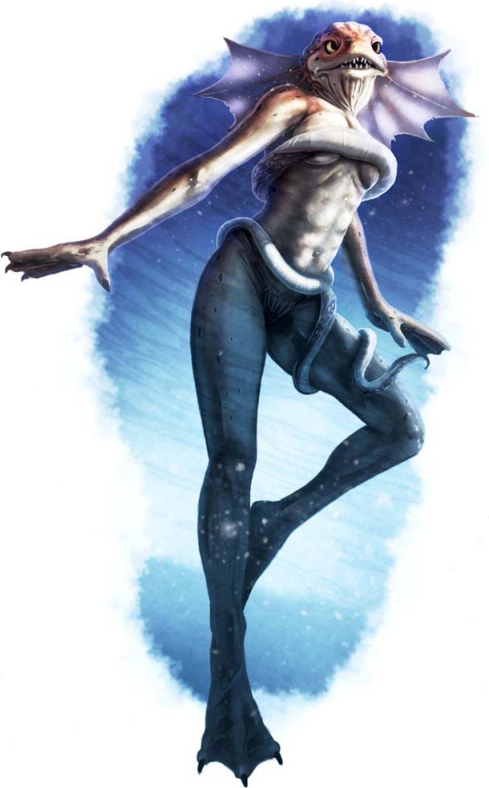
The last image the book gives before the Open Game License page. Enjoy

Closing Thoughts on the Cerulean Seas Campaign Guide
While I still stand by this being a good campaign setting for Pathfinder, it’s not quite as shining as I recalled. Funny how selective memory works like that.
On the plus side, I genuinely like the water pressure system’s simple but effective adding of potential environmental damage if you go too far out of your element, a fair bit of the playable races are interesting, the classes other than Mariner and Siren are good, the spells and equipment aren't too bad for the most part, and the bestiary takes some interesting pulls out of the annals of both present and past wildlife from our world.
Of course, where there’s a plus side, there’s also the minus side. The big one people already touched on was the one-two punch of drag and buoyancy. They are meant to be the underwater equivalent of encumbrance, but are they really? No, not really. It manages to add the sort of math you'd more expect from a poorly optimized GURPS book than a d20 game and requires a fair bit more legwork than you would need for just regular encumbrance. The religion system of "one religion for each alignment" is kind of iffy as well, at least in my opinion, and some of the bestiary entries just have really weird choices (especially if they are a more well-known animal group). Then there's the whole art situation with female humanoids... But still, some bad and a fair bit of good is better than a lot of bad and little to no good.
Next Time...
The first sourcebook for Cerulean Seas in both voting order and publishing order is Indigo Ice, so I'm fairly sure we'll be doing that next unless I feel like having a random one-shot of some other roleplaying game as an interlude or something.
Indigo Ice Introductions
Original SA post
Part 1:
With the Cerulean Seas Campaign Guide, it turned out that (while still good in my opinion) it was worse than I remembered. Cerulean Seas: Indigo Ice? I remembered literally nothing about it besides that there are ridiculously swole penguin-men before I started prepping this review. I guess we'll find out what this means for the title's quality when we're through.
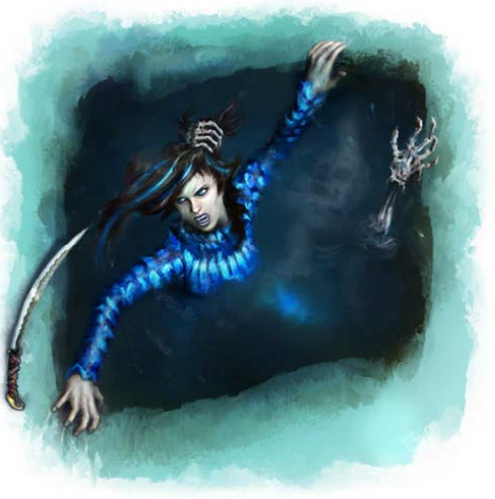
Environmental Basics
Indigo Ice is a sourcebook about Isinblare, the collective name for the two polar regions of the Cerulean Seas world. Isinblare has a lot of ice. Ice is cold. Water around ice is usually cold as well. But not all cold ice and water is the same, and this book begins with terrain charts for different icy water environments - frozen seas, glaciers, and slush swamps (foggy ice bogs around hot springs). To a character who isn't naturally inured to the cold, there are plenty of unpleasantries to experience here. Indigo Ice supplements the rules for extreme cold from standard D&D and Pathfinder with some extra facets. Wind chill reduces the effective temperature for purposes of extreme cold by 10 degrees Fahrenheit, and creatures that are native to polar regions have a separate set of degrees for when they start taking damage from extreme cold (-55 degrees instead of -5 degrees like average characters).
If that isn't enough, there are also rules for thin ice and movement penalties from deep snow, as well as two new character conditions. The first of these, entombed, refers to being encased in solid ice at least an inch thick, and is basically the entangled condition with the added penalties o both 1d6 points of cold damage per round and suffocation. The other is the frosted condition, wherein you are coated in ice and frost in a way that causes a -1 to attack rolls, -2 to Dexterity, and 1 point of cold damage a round. It also makes you more buoyant, because you can't escape the buoyancy rules.
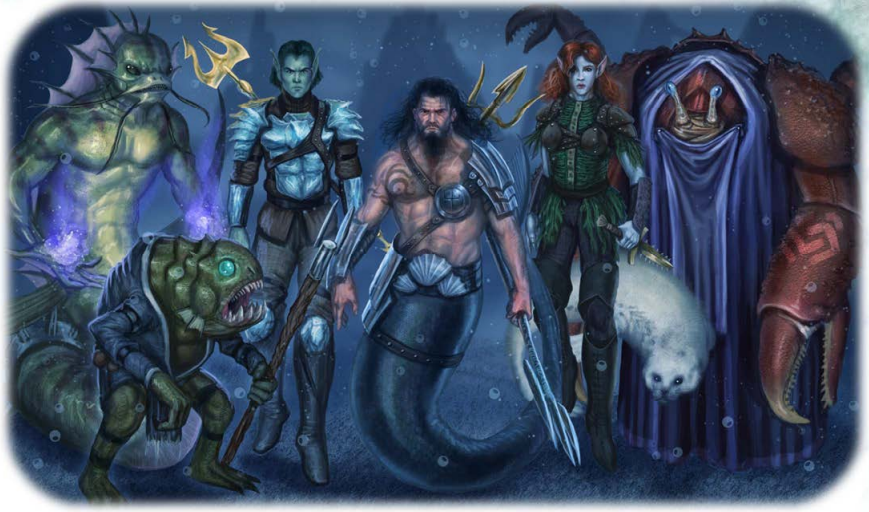
Aquatic Polar Races
As seen in the image above, our first introduction to the races associated with Isinblare are not the new ones, but instead a quick overview of how the Cerulean Seas Campaign Guide’s races are in the icy realm. Aquatic elves in Isinblare have blue hair and green skin instead of green hair and blue skin, its karkanaks are entirely aquatic and have spider crab-inspired features such as long and spindly manipulator arms and pincers that are both small for males as well as females, the nommo are the same, the pisceans are short and stout descendants of a runaway slave caste, the seafolk are hairier and more strongly built, and the selkies came from Isinblare in the first place so of course they’re the same.
There are six new races added in Indigo Ice, two of each of the three racial archetypes. One of each is also meant to be a “we’re different!” example of a race not having its archetype’s...well, archetypical traits.
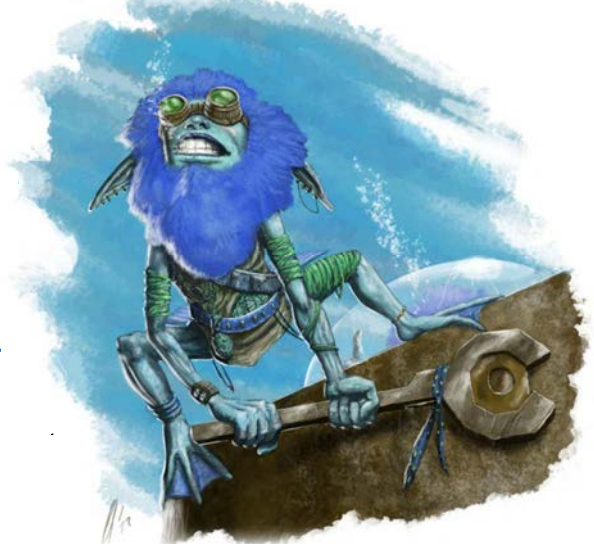
Agloolik: Aglooliks (a name taken from a fairy figure in Inuit mythology) are oddballs of the feykith. They have no innate magic, instead having a high level of technological prowess, and eschew the more overt sexual dimorphism that most humanoid feykith end up displaying. In fact, that agloolik above? She’s a female of the species. The mane of hair that culminates in a “beard” is displayed by both sexes, with the main difference between the two being that male aglooliks grow mustaches. Their nature is one of almost construct-like methodicalness. Most are Lawul Neutral, they are almost always atheists, they divide themselves up into those who create technology and those who dismantle it, and most adventuring aglooliks adventure because they want to learn more. Even their names are calculated, quite literally – a number in their language with their family name attached as a suffix. So, for instance, the fifth (“sitaman”) member of the current batch of the Axa family is named Sitamanaxa.
Gameplay-wise, aglooliks are meant to gravitate toward either Alchemist as a creator or Rogue as a demolisher, and it shows. Their Small size is offset by a swim speed of 30 feet rather than 20 feet, and their ability scores are a +2 to Dexterity and Intelligence at the cost of -2 to Constitution. Racial traits? The main one is a +2 bonus to either Knowledge (Engineering), Profession (Engineering), any one Craft skill, or Disable Device, all of which are permanent class skills no matter what class the agloolik takes. The other two racial traits are “Dodge Disasters” (a +1 dodge bonus against area of effect attacks that are acid, electricity, or steam) and the ability to consider any of their fantastical magitech weapons as martial rather than exotic.
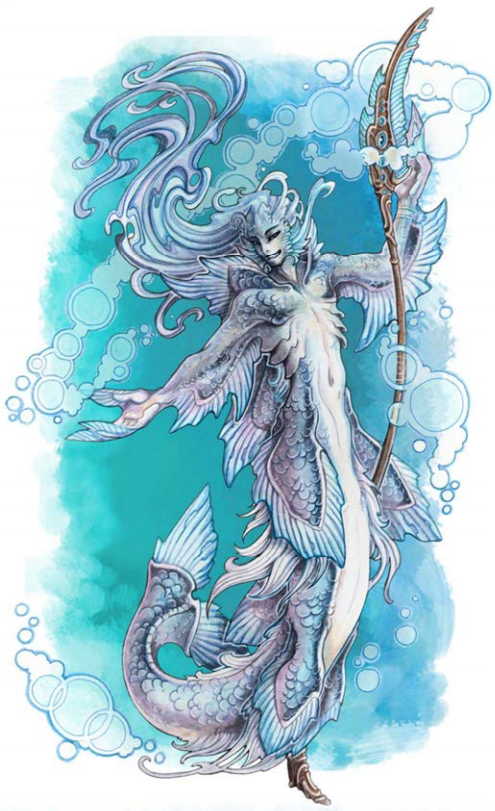
Crystolix: These strange coelacanth merfolk are considered to be extremely beautiful and share the whole very minute sexual dimorphism thing the agloolik have (the difference between the sexes is that males have bigger facial fins). They are skilled diplomats that are typically Neutral Good, but their reasons for being all nice tend to be rather self-serving. You see, crystolix are hella meritocratic. Property and wealth are such a show of status for them that they will sell off the meat of their own dead family members rather than bury them or let it go to “waste” in nature. Crystolix names are chosen to best promote their business and can be changed whenever their profession shifts, and whatever gods are worshiped are whichever happen to be most convenient.
It’s not surprising that the +2 ability score bonuses crystolix attain are to Wisdom and Charisma, nor is it really that surprising that their -2 penalty is Strength. They also have cold resistance 10 on top of the normal higher cold tolerance the races of Isinblare have, a +2 bonus to Appraise checks, Diplomacy as a permanent class skill that they must take Skill Focus (Diplomacy) for with their first level bonus feat, a +2 to saving throws against any effect that is designed to elicit a negative emotional state, and can make one reroll on any saving throw against suffering the shaken condition.
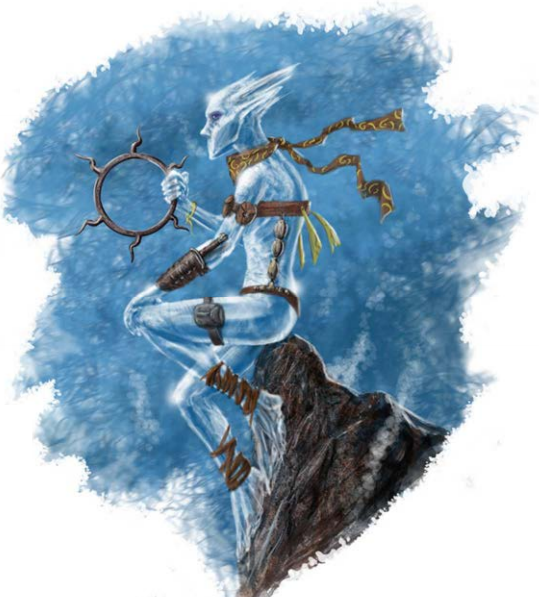
Ice Elf: God, these things are creepy. That image above isn’t even the true ice elf. That’s just its ice exoskeleton that is magically generated throughout its life. The real (and, in fact, boneless) body is inside and totally transparent from organs all the way up to skin. And as if that weren’t disturbing enough, their main lot in life is breeding horrifying magic-juiced war beasts. And I you think I’m being hyperbolic, let me just quote the book itself.
“Indigo Ice” posted:
In the war-torn realm of Isinblare, the ice elves have perfected their skills for a darker purpose than mere domestication. Through arcane tampering, selective breeding and exposing animals to strange radiations, the ice elves have developed an arsenal of terrifying beasts of war.

Ice elves are mechanically very "I feel like I've been here before". Their ability score modifiers of +2 to Dexterity and Wisdom at the cost of -2 Constitution isn't that dissimilar to standard elves, they still count as Humanoid (just with the Cold subtype) as all playable races in these do in spite of how weird they are, their attunement to animals nets them Handle Animal and Ride as permaent class skills, they have a +1 natural armor bonus to AC as long as they are in or touching water (including frozen water) and their nature as a feykith gets them a +1 bonus to the saving throws of ice spells they cast and the ability to cast ice water as a spell-like abilities three times a day if they have a Wisdom score of 11 or higher.
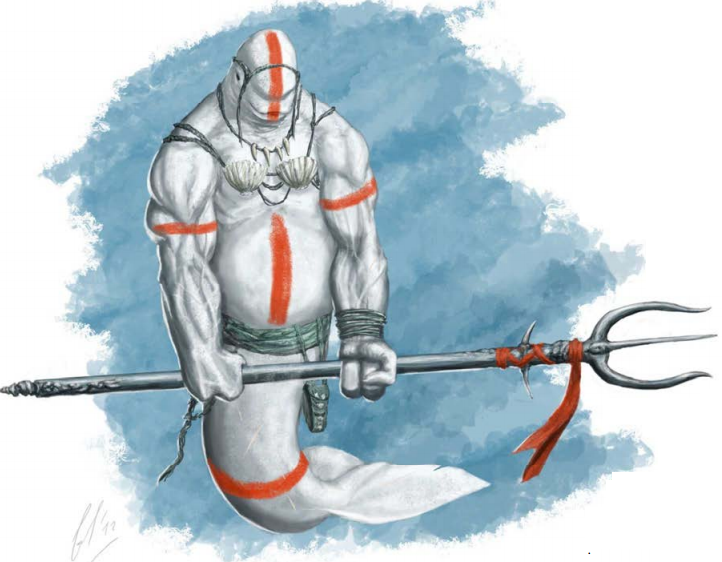
Talilajuk Ningen: While it's common to have D&D and Pathfinder creatures and races that are based on or at least crib the names from mythology, ones that come from urban legends are a bit more scarce on the ground - the talilajuk ningen happen to be both. These guys are one of the ningen, named after a Japanese urban legend about freaky white whale-men supposedly seen down in Antarctica. The specific name for their playable ningen race, the talilajuk, comes from one of the alternate names for Sedna, an Inuit goddess of marine mammals and the hunting of them in kind. Anyway, let's actually talk about them in the game rather than the origin of the name.
Talilajuk are a bit of an example of extremes from two ends. They are the largest playable merfolk (but still on the Medium side of 8 feet rather than the Large side, because we can't have player races getting weird now, can we?) but the smallest of the ningen. They are a sociable but combat-averse species that are well-known for their mercenary natures. A good offer of food and coin can get a talilajuk as hired muscle. Typically this means physical labor or guard duty, but the fact that these cetacean merfolk are brutal if they can't avoid combat or are defending family or allies makes them also favored as soldiers.
The talilajuk is a bit of an odd duck stats-wise. While they have +4 to Strength and -2 to Intelligence as is usual for a brute force playable race, their other abilities are all less directly combat focused. They have lungs rather than the gills most merfolk have, a fast swim speed of 40 feet rather than the usual 30, gain water-specific blindsense in a 30 foot radius, have Stealth as a permanent class skill, and must take Skill Focus (Stealth) as their first level bonus feat. I'd say that this would gear them heavily toward the Mariner class, but the flavor text says they are usually Barbarians and only rarely Mariners.
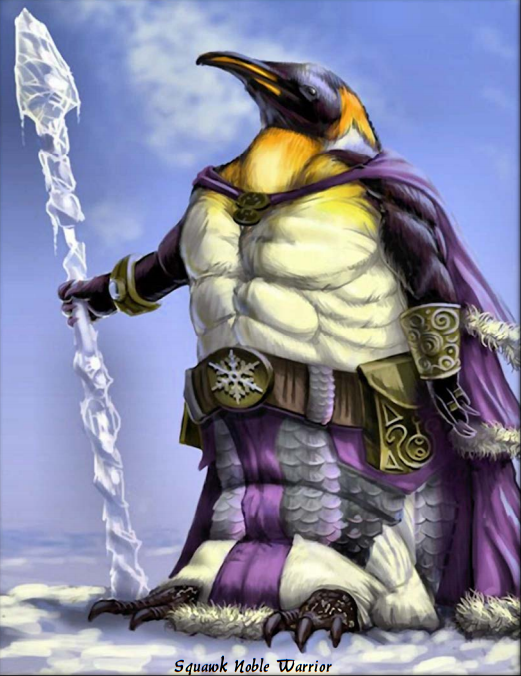
Technically the next chapter's header image, but it's my favorite image of the squawk so I'm putting it here.
Squawk: Squawks are one of the two anthromorph races in Isinblare, and clearly the far superior one. What could be better than penguins? Swole fascist penguins, of course! These guys live and breathe battle, going around picking fights with sapient pinniped races such as the hydrurgans, selkies, and thanor. Foreigners entering their land is immediately met with combat as well. Religion is not permitted, nor is insubordination or other forms of disobedience. Eugenics and social darwinism? Yep, got that too, with chicks being encouraged to cull out the weak as soon as they are out of the egg. These penguin-people ride giant battle penguins into battle as well, typically while wielding giant scythes called skiths. All of this combines to hit that sweet spot of "amazingly ridiculous and ridiculously amazing" that the mogogol from the campaign guide also struck.
Sadly, squawks don't live up to the hype mechanically. In spite of the imagery and text showing and describing them as amazingly muscular, their ability modifiers are +2 to Dexterity and Constitution and -2 to Intelligence. Being size Small just further hampers their lack of a Strength bonus. Their other abilities are treating the skith as a martial rather than exotic weapon, a swim speed of 30 feet in spite of their size, being considered to have cold weather clothing at all times, a +1 dodge bonus to AC, and a +2 bonus to saving throws against poison, spells, and spell-like abilities.
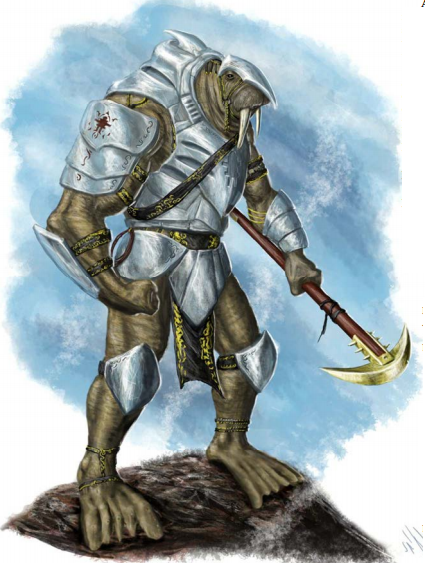
Thanor: The other anthromorph race of Isinblare is the thanor. They are the Rome to the squawks' barbarian tribes, a rigid Lawful empire with large cities and expansive governments rather than the tribal or nomadic natures that other anthromorphs have. They're also colossal dicks, as their seemingly expansive an comprehensive law system has intentional loopholes that allow for backstabbing and deception toward non-thanor races if they feel like it. Their code of law also says that female thanor are inferior to males and cannot take any martial class, which of course leads to them taking spellcasting and psionic classes and breaing the whole level of logic there. Dumb walruses.
The thing that immediately sticks out about the thanor racial traits is that they are size Large. Why do they get this but the talilajuk are forced to be Medium? I don't rightly know, but it's pretty silly. Their ability score modifiers are a +4 to Constitution, +2 to Strength, and a -2 to Dexterity and Wisdom. Ability-wise, thanor have a slow swim speed of 30 feet in spite of their Large size, a +1 natural armor bonus to AC, the same insulted hide ability as the squawks, and a bite attack that is 1d8 damage if they are male or 1d6 if they are female. Oh, and weirdly enough, female thanor can be either Large or Medium. If they are Medium, they drop the Strength bonus and Dexterity penalty and have a bite attack of 1d4 rather than 1d6.
Seafolk Half-Races: Yeah, these guys are back. As stated back in the campaign guide, seafolk hybrids lose their skill point boost in favor of one ability granted by their non-seafolk parent. The new ones for Indigo Ice are...
-
Iquala:
The iquala are half-crystolix and have the lobe fins and silver coloration of their non-seafolk parent. They get both the whole Diplomacy shebang and the resistance to negative emotions that the crystolix have.
-
Kyla
Half-talilajuk that are white and hairless. They have the lungs of their non-seafolk parent, as well as their Stealth class skill shenanigans.
- Frost Oceanid: These guys are half-ice elf, anad get the Cold subtype as a result. They also get the joy of causing people to panic when they see them, as they keep their bones but have the transparent everything else that ice elves do.
Next Time...
Classes, crafting, and campaign chat.
Indigo Ice Classes
Original SA post
Procrastination time is over now. Now is the time to post.
Aquatic Polar Classes
Indigo Ice brings us a single new base class and three new prestige classes, so they’re all going to be under this one header rather than split up like I did with the review of the classes in the Cerulean Seas Campaign Guide.
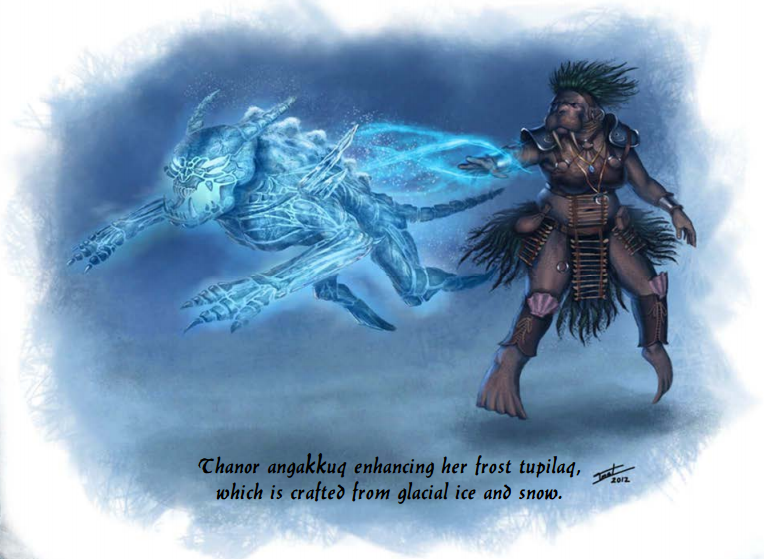
Angakkuq (Base Class)
The concept of the angakkuq is drawn from Inuit culture, wherein the term refers to a shaman who gained powers from a spirit guide and had to act as a general mediator between the mortal and spirit worlds, and follows its inspiration relatively well. The Angakkuq’s stats are of a more beefy than average spellcaster, with d8 hit dice, average Base Attack Bonus progression, and high Will save progression tempered by poor Fortitude and Reflex save progressions. The Angakkuq’s divine spells are also a bit below average, only getting up to 6th level and even then not attaining that level of spells until they reach level 16 of the class. This is enough to have access to some pretty damaging magic, of course, but is still less than the Cleric, who nets 6th level spells at level 11 and can get up to 9th level spells.
The main class feature of the Angakkuq is her Tupilaq , a spirit bound to an effigy body crafted specially for it. All tupilaq are Medium-size intelligent Constructs with a 20 foot swim speed and 10 foot land speed that level up like an animal companion would. There are three types of tupilaq as well, differentiated at the start purely by their resistances and vulnerabilities. The flesh tupilaq is crafted from animal parts and has damage reduction 3/bludgeoning and vulnerability to acid, the frost tupilaq is made of ice and snow and has DR 5/bludgeoning and vulnerability to steam, and the flora tupilaq is crafted from plants, sponges, and/or coral and has DR 5/slashing and vulnerability to electricity. In Inuit lore, there are also some less scrupulous angakkuq who create tupilaq from the flesh and bones of human children, which inspired the official Paizo tupilaq stats found in Pathfinder Bestiary 3. Rather than ignore that entirely, Indigo Ice goes "oh those are just perversions of the real tupilaq made by evil necromancers. Yeah."
On top of leveling up their HD and everything, the tupilaq is also enhanced by the Angakkuq's Enhanced Imbuement ability. At levels 3, 6, 9, 12, 15, and 18, the Angakkuq can pick an extra ability for their tupilaq to gain. Most of these, such as a +2 to one ability, an additional natural attack, size category increase, or spell resistance, are basically fair game. Each specific tupilaq, however, has three unique imbuements that only it can attain. The flesh tupilaq can attain 1 bleed damage on its melee attacks, a fear-inducing melee attack that frightens foes that fail their save for 3 rounds, or a 25% chance to turn a critical hit into a normal hit, the frost tupilaq can gain a melee attack bonus that forces a foe to make a Fortitude save or be slowed for 3 rounds, fast healing 2, or a cold breath weapon, and the flora tupilaq can get extra damage reduction, a jagged hide that makes its critical hits be x3 rather than the usual x2, or be able to cast enlarge as a spell-like ability.
The Angakkuq also gains another ability straight out from level 1 besides tupilaq-craft, and that is Outer Attunement . This is basically a combo clairvoyance/clairaudience spell with a 100 foot radius that starts out at one use per day and gains another use per day at 3rd, 7th, and 10th level. It is further boosted with Improved Outward Attunement , which gives an extra +2 bonus to the spell check for the ability at levels 13, 16, and 20 of the class, for a total of +6. The Angakkuq can also expend a use of Outer Attunement to instead boost one skill check by her Charisma modifier.
Perhaps the strangest ability to the Angakkuq has, though, is Spirit's Whisper . This class feature has a different bonus each level it is relevant: at level 2 of the class it lets the Angakkuq add her Charisma bonus to Perception and Sense Motive checks, at level 5 it is Charisma bonus to Initiative roll, at level 8 it's a Charisma bonus to Reflex saves, at level 11 it allows the Angakkuq to get a yes or no answer to a question from the spirits once per day, and at level 14 it allows her to reroll any failed save once per day. Finally, the capstone ability for Angakkuq is Part of the Living World. This boosts the range of Outer Attunement to 1 mile and allows her to increase the bonus to saving throws and skill checks from "Shared Perception" after the throw or check is made rather than before. What is Shared Perception? I don't know, it's literally never mentioned anywhere else in the class features. Maybe it is referring to the effects of Spirit's Whisper, maybe not, who knows.
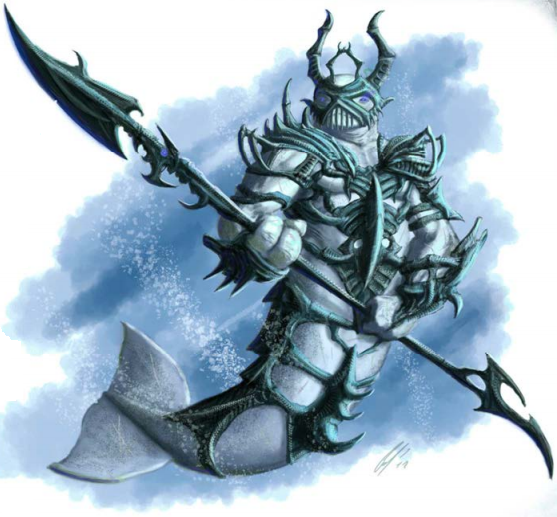
Congulair (10 Level Prestige Class)
Our first prestige class for this book is also definitely the weirdest. Okay, so, a group of abolitionist squid from space crashed into Isinblare on a meteor, and the Congulairs are those who symbiotically bond with these abolitionist space squid to fight against tyranny. The prestige class is obviously meant for combat, with d10 hit dice, full Base Attack Bonus progression, average progression for Fortitude saving throws, and poor progression for the other two saving throws. The one thing that is missing is a lack of gaining any armor or weapon proficiencies. That, of course, is explained by the features of the class.
The starting ability for the Congulair is Blessing of the Symbiote . This is more or less a groundwork piece that just notes that the Congulair gets the Cold subtype if they didn't already have it and that the symbiote dies when the host dies. What's actually important starts at level 2 with Gelugarma . See all that Borg-looking stuff in the class image? That's gelugarma, a hardened gelatin created by the symbiote that provides a +3 armor bonus. This bonus increases by an additional +2 at levels 5 and 8.
Gelugarma also gets an offense counterpart, of course. At level 2 this is Icesickle , which is...well, an ice sickle. Specifically, it is hardened symbiote gelatin created as a swift action that acts as a masterwork sickle made of ever-ice and overcomes damage reduction that has magic as its overcoming force. This gets upgraded with Icelance at level 4, which allows the gel to become a replicant of a shortsword or short spear as a standard action instead. Icelance upgrades again at level 7 to allow the creation of a spear, great spear, or halberd, and at level 10 it further upgrades to allow the creation of a gel long spear, lance, or ranseur. Any gel weapon melts into nothingness a single round after it leaves the Congulair's hand, making it pointless to attempt to steal them.
Both the gelugarma and gel weapons eventually get upgraded with "rimefire", a phantasmal blue aura. Rimefire Armor at level 9 makes the Congulair's armor deal 1d6 + caster level (to a maximum of 15, still assuming the Congulair has caster levels at all) when a foe hits them with a melee weapon or natural attack. And at level 10, Rimefire Weapon makes the Congulair's icelance have the Frost, Icy Burst, and Frostburn enchantments. As it is new to this book rather than a Pathfinder standard, we won't get to learn what a Frostburn magical weapon is until the equipment chapter.
Last, but not least, to know about the Congulair's abilities is Frostboon . This is a special power granted by the symbiote at a specific rate – at level 3 the Congulair has one frostboon they can use once per day, at level level 6 it becomes two frostboons that can both be used twice per day, and at level 9 it's three frostboons that can all be used three times per day. The specific frostboons are...
-
Cold Touch:
Elemental touch (cold)
as a spell-like ability, caster level is equal to total character level.
-
Frostsmite:
It's like a Paladin smite, but with the added bonus of 2 points of cold damage per character level on the smite as well.
-
Hibernation:
The Congulair goes into suspended animation until either they are damaged or a specific trigger happens. What a strange power for a combat class.
-
Icebind:
Ice sickle or ice lance strikes on a foe force them to make a Fortitude save or be frosted and slowed for 1d4 rounds.
-
Icy Murk:
The Congulair has to be underwater to use this. One swift action spurts out a 20 foot radius cloud of gel that provides total concealment and 1d6 cold damage to anyone inside for a minute before dissipating. All Congulairs get to ignore the concealment effect.
- Slippery Ice: The namesake spell gets cast as a spell-like ability, caster level is total character level as per Cold Touch. Congulairs are immune to this power, though, so they often group together to make huge skating rinks of doom against their foes.
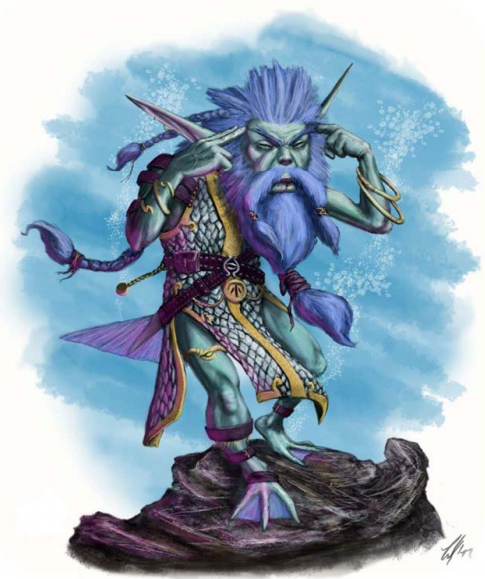
Cryokineticist (10 Level Prestige Class)
The psychic icy guy. Where the Congulair is a pure brute, the Cryokineticist provides a mixture of armed combat and psionic talent. A d8 hit die and good BAB progression will keep this prestige class combat capable, but at the same time it is tempered by poor Will saves (a decidedly strange feature for someone with mind powers) and average Fortitude and Reflex saves.
As for powers? Well, they're limited. Limited to the class features, specifically, as the Cryokineticist just has class features flavored as mind powers rather than straight-up attaining psionics in the same way as, say, a Battle Mind would. This starts out with two abilities at level 1. Rimespear is a flexible 15 foot long harpoon of ice (yes, flexible ice) that can be summoned as a move equivalent action, dealing 1d8 damage to foes on a ranged touch attack and, of course, melting into nothingness if it leaves the Cryokineticist's hands. The other, Manipulate Freeze , can be used three times per day on a close source of non-magical ice in order to do one of three tricks – create a massive crackle and pop that temporarily deafens any foe within 120 feet that fails a Will save against it, turn it into a nice ice pack that heals 2 HP per power point expended, or create a 20 foot cube of murky water that both impedes vision and forces a Fortitude save to avoid taking a -4 penalty to Strength and Dexterity until the cloud dissipates. That ice pack healing power? One of only two features this class gets that actually states it needs power points, by the way.
Moving on, level 2 introduces two abilities that both progress beyond that level. Convenient, that. Cold Adaptation grants a +4 bonus to saving throws against cold spells and effects plus cold resistance 10, which advances to a +8 bonus and cold resistance 20 at level 7 of the prestige class. Cold Hands is an offensive power by contrast, allowing the Cryokineticist to take a move action to coat one hand (always one, never more) with ice to deal 2d6 points of damage at level 2 of the class and 4d6 at level 8. More fancy ice attacks come in the form of Icebolt (a number of d6s of cold damage equal to the Cryokineticist's class level at a range of 60 feet) at level 3, and Icy Weapon (Cold Hands but for melee weapons or projectiles) at level 4 and 8.
Level 5 grants Glaze , which is usable once per day and lasts a number of minutes equal to the Cryokineticist's level in this prestige class specifically. It sort of trumps Cold Hands by being able to do the same damage as a melee touch attack (2d6 at level 5 and 4d6 at level 8), with added abilities on top. Those abilities are a +4 bonus to Charisma while glazed because ice is apparently sexy or something, damage reduction 5/melee, and dealing the Cold Hands damage to foes that strike the Cryokineticist in melee combat. Getting up to level 10 lets the Cryokineticist use this ability three times per day rather than one. This would be objectively better than Cold Hands in all ways if it wasn't for the fact that Cold Hands is unlimited use.
Speaking of unlimited use and Cold Hands, though, there is no usage limitation listed for the first level 6 ability, Leech Heat . What does it do? Well, it deals the same damage as Cold Hands (2d6 when you get it, 4d6 at level 9), but has a range of 30 feet and heals 2 (4 at level 9) HP every time you damage a foe! And again, there's no usage limitation listed, or even a windup time for that matter, so we can only presume this is a passive aura. That's pretty crazy! Especially crazy when you see that a level 6 Cryokineticist also gets Penetrating Cold , which makes the Cryokineticist so cold that they bypass cold damage equal to their class level.
Of course, not everything can be that crazy. There is yet a third level 6 Cryokineticist class feature: Frostwalk . This one allows the Cryokineticist to move in any direction freely on a trail of ice, but costs a power point a round. The prestige class's level 9 ability, Icy Death , also has an actual limiter. Expending a full round action and psionic focus allows the Cryokineticist to forcibly lower the internal temperature of a creature within 30 feet to lethal levels, dealing 4d8 cold damage every round they can keep up focus.
To end this crazy class off, level 10 nets the Cryokineticist two capstone abilities. Flash Freeze is a once per day "fuck everything" attack that deals 9d6+21 cold damage in a 30 foot radius and entombs any creature in that radius if it is used underwater. Heart of Ice , by contrast, is passive – cold immunity, immunity to the entombed condition, and the ability to swim through solid ice at half the character's normal movement without any adverse issues with doing so.
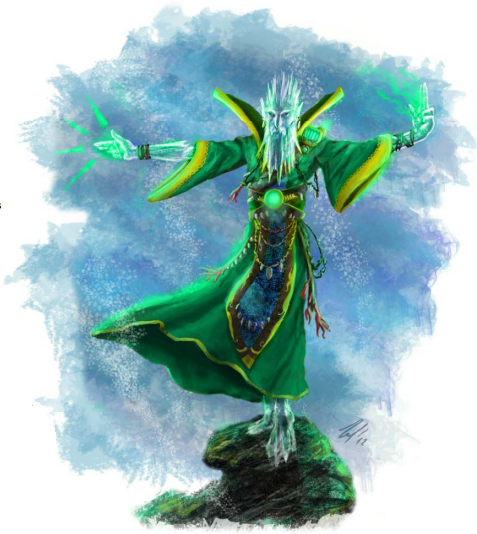
Cryomancer
The spellcaster to the psion and melee fighter of the Cryokineticist and Congulair. A d6 hit die, average BAB progression, average Will save progression, and bad Reflex and Fortitude save progression mark the Cryomancer as pretty bog standard spellcaster as far as those traits go. It is also a prestige class that allows the retention of caster level increase, which never hurts.
And the class features? Well, they're okay, but not anything nearly as insane as the Cryokineticist. Cold Affinity grants cold resistance 5 at level 1, increased cold resistance to 10 and +1 caster bonus to all ice-related spells (but at the cost of not being able to cast any steam or fire spells from then on) at level 5, and a change to cold immunity, +2 caster bonus rather than +1, and a -2 caster level penalty to acid or electricity spells at Cryomancer level 9. Icy Knowledge grants knowledge of an ice spell from any class at every even numbered Cryomancer level. Intensify Cold at level 3 increases the maximum amount of damage an ice spell can do by two dice. Are you excited yet? I know I clearly am.

Level 6 brings us to the start of things that are at least conceptually interesting. Create Ever-Ice converts a cubic foot of ice per Cryomancer level into the never melting ever-ice for 24 hours...at the cost of a 12 hour ritual and 25 gold worth of gemstones per cubic foot. Handy. Level 7 Cryomancers get to gain the Cold subtype and special attacks and abilities of an ice elemental once per day for a number of minutes equal to their class level with Body of Ice , as well as take a standard action to deal 2d6 cold damage to adjacent foes that fail a Reflex save thanks to the Rimefire ability. Rimefire can be used a number of minutes per day equal to the character's class level, so presumably everyone should just go bang for their buck and use both level 6 Cryomancer abilities in tandem. Oh, and Icy Ascension is the level 10 capstone and turns the Cryomancer's creature type to Outsider. Wouldn't Elemental [Cold] make more thematic sense? Whatever.
Next Time...
The rest of the book. Yeah, not a lot of stuff to talk about in heavy post detail once you get past the races and classes.
Indigo Ice Frostcraft, Setting, Bestiary
Original SA post
Frostcraft
Welcome to the "catch-all" chapter of Indigo Ice. New weapons, feats, spells, and magic items are all in here, ready for us to look at.
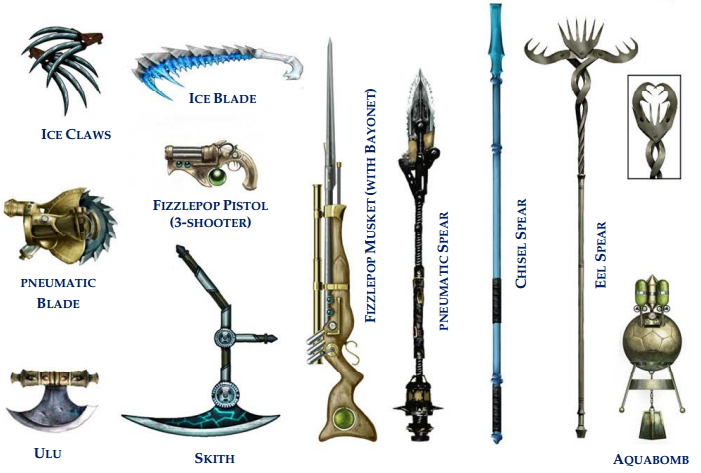
Weapons
Indigo Ice gives us a total of 14 new weapons: the aquabomb, aquabus, aquannon, bayonet, chisel spear, eel spear, fizzlepop pistol, fizzlepop musket, ice blade, ice claws, pneumatic blade, pneumatic spear, skith, and ulu. Most of these are self-explanatory, such as the chisel spear being a spear with a chisel-shaped end (which helps against Earth subtype creatures in combat), ice claws being claws made to climb ice, and the aquabus being an arquebus that works underwater. The ones that are probably worth the most actual discussion are the pneumatics, eel spear, fizzlepops, and the skith, so let's actually talk about them rather than talk about talking about them.
-
Eel Spear:
A spear designed to catch eels rather than one designed to mimic an eel. Its "jaws" clamp down on any target two size categories or more smaller than the wielder of the spear and holds them in place, which is an automatic grapple that can deal more damage each round it is maintained. The unfortunate target must either break the weapon, make a DC 17 Strength check to escape, or take 2d4 slashing damage as they peel out of the weapon without regard for the serrations it has.
-
Fizzlepop Pistol and Musket:
While these could be written off as just another aquatic adaptation of a land technology, there's a little more to these two firearms than replacing gunpowder with a volatile algae called "fizzle juice". For one thing, they don't fire bullets, they shoot rather large and imposing barbed nails straight into the foe's flesh to simultaneously deal slashing and piercing damage. They are also ridiculously detailed for fantasy underwater flintlocks. There are a whole two pages dedicated to describing the craft and maintenance of fizzlepop weapons, descriptions of fizzle juice algae species down to their specific binomial nomenclature, and a detailed instruction guide to creating the chemical reaction that turns the algae into underwater projectile fuel.
-
Pneumatic Weapons:
Using pressurized air, the aglooliks have effectively created both an industrial buzzsaw and a jackhammer in the form of the pneumatic blade and pneumatic hammer. They aren't exactly amazing, though. While their critical hit threat range is a strong 18 to 20, their actual damage isn't that different from a regular shortsword or spear of the same size, and they have a limited charge - 8+1d4 rounds for the pneumatic blade, 12+1d6 for the pneumatic spear. Once they run out of charge, the wielder has to go to the surface and pump air into the weapon for a minute before it functions at full capacity again.
- Skith: This is the racial weapon of our favorite swole-penguin friends. A skith is basically a scythe with a ridiculously short handle, allowing the squawks to use their silly musculature to their advantage and actually wield the things in combat. Two skiths used together by a squawk can also be used as a handy pair of ice skates, propelling the squawk at four times their base speed! Is there anything the squawks can't make better?
Feats
Well, I guess this answers that previous question. Most of the 25 new feats in Indigo Ice are either racial feats or feats to boost the Angakkuq's tupilaq, and the squawks get the most boring to recount ones with a bunch of set of combat maneuvers tied to the skith and one that grants a natural bite attack with a serrated beak. The ice elves aren't much better, with three feats that add minor cold damage to either unarmed strikes with Fists of Ice melee weapons with Freezing Weapons , or grapples with Icy Grasp . Hell, the rest aren't exactly amazing to discuss either. Thanor have Midwinter Hide (+1 natural armor and cold resistance 5) and Tearing Tusks (1 point of bleed damage and 19-20 critical threat range on the thanor's natural attack), the crystolix get Aweless (the panic and frightened conditions are reduced to shaken if the fear effect is spell-like or supernatural) and Selling Ice in Isinblare (Wisdom bonus added to Appraise and Diplomacy checks), aglooliks have Kul's Intuition (reroll a failed Disable Device check) and Redundant Processes (roll twice and take the higher result when making a Craft check), and the ningen can take Cryptid Anonymity (cast invisibility 3 times a day) and Expanded Senses (the ningen's water sense ability gets an extra 10 feet of range). Mind you, all of these feats are certainly likely to be useful, but it's hard to get excited about them.
On top of these racial and tupilaq feats, there are three feats that are made for a slightly more general audience. The feat Icy Berserker is applicable to any character who can go into a rage (Barbarian or otherwise), and grants them the Cold subtype as long as they are in the rage. Similarly, Rime Rouser grants the Cold subtype to any creature summoned by a spellcaster with the feat handy. And then there's Piercing Cold ...oh, Piercing Cold. This metamagic feat allows a spell with the Cold descriptor to be ridiculously cold. Like, so damn cold that cold things get cold. This allows the spell to ignore any cold resistance, or still deal half damage to a creature that otherwise has cold immunity. I'm fairly sure there was some sort of dumb exploit in Dungeons and Dragons 3.5 with a similar feat, but I can't remember the specifics.
Spells
Do you like ice? If not, well...good for you, actually. There are only a handful of new spells in Indigo Ice, and surprisingly few of them have to deal with ice. It's like an inverse of the logic behind the feats.
-
Greater Aquatic Contagion (Necromancy; level 5 Angakkuq/Cleric/Witch or level 6 Wizard/Sorcerer spell):
This is a buffed up version of the
aquatic contagion
spell from the Cerulean Seas Campaign Guide. It bestows disease just the same, but cannot be cured naturally - someone has to cast a healing spell or use a healing magic item. Hope you've got a Cleric handy.
-
Beastly Bearing (Transmutation; level 2 Alchemist/Kahuna/Magus/Sorcerer/Wizard spell):
Cast this spell to turn part of yourself into an animal. You can get a dolphin tail for a bonus on Acrobatics checks, lobster pincers for extra damage and a bonus to grapple checks, octopus hide and arms for a bonus to Disable Device, Sleight of Hand, and Stealth, seal legs to get a land speed if you don't already have it, a shark tail for greater swim speed, squid suction cups for a bonus to Climb and grapple checks, or starfish cilia all over your body to gain climb speed. Fun for the whole family, save for the starfish transformation which will probably end up psychologically scarring someone!
-
Beastly Bearing, Greater (Transmutation; level 3 Alchemist/Kahuna/Magus or level 4/Sorcerer/Wizard spell):
The transformations get more powerful, with a secondary ability for each one on top of the one you'd get with standard
beastly bearing
. The dolphin also grants double swim speed, lobster grants +1 to natural armor and Fortitude saves, octopus gains boosted skill bonuses to the same skills, seal makes you react to cold as if you were wearing a cold-weather outfit no matter what you are wearing, shark increases swim speed to +30, squid gains a +4 to Acrobatics checks, and starfish gains a +4 bonus to grapple checks and keeps you from being disarmed.
-
Encapsulate (Evocation [Ice]; level 2 Magus/Sorcerer/Wizard spell):
Our first actual ice-themed spell. Casting
encapsulate
freezes a 12 foot ice cube with 1 foot thick walls. The ice is nonmagical and doesn't fade away with a spell duration or anything, making it possible to actively craft with the ice made by this spell.
-
Frost (Transmutation [Ice]; level 1 Angakkuq/Kahuna/Magus/Sorcerer/Wizard spell):
The target gets the frosted condition. Pretty straightforward.
-
Icy Tomb
(Evocation [Ice]; level 4 Magus/Sorcerer/Wizard spell):[/b] The target gains the entombed condition. Again, pretty straightforward.
-
Mage Thaw (Transmutation; level 3 Alchemist/Kahuna/Magus/Sorcerer/Wizard spell):
A 20 foot radius area of ice is melted into water. If that ice happens to be something alive, it instead takes 1d6 damage per caster level. Good for quickly freeing someone who is entombed or dunking someone into the water if they are standing on the ice.
-
Rancid Tide (Necromancy; level 6 Angakkuq/Cleric/Kahuna/Witch or level 7 Sorcerer/Wizard spell):
A
murk
spell with the added effect of moving at 10 feet per round and causing anyone inside to make a Fortitude save or instantly contract blinding sickness, cackle fever, demon fever, devil chills, filth fever, ick, sea rot, mindfire, slimy doom, tapeworms, or white spot.
-
Steed, Communal (Conjuration; level 2 Magus/Sorcerer/Summoner/Witch/Wizard spell):
Communal steed
summons up to six hippocampus for yourself and your party members. Strange that the Cleric doesn't get in on the mount-summoning party, but whatever, it's nice to see a team effort spell.
- Untether Spirit (Untyped; level 1 Angakkuq spell): This is a save or die spell specifically for a tupilaq. Not sure I'd ever take up a spell slot on that unless I knew I'd be fighting a lot of enemy Angakkuqs and their tupilaq crew.
Magic Items
The last part of this rather extended chapter is a look at magic items, starting with the Frostburn weapon quality. This quality makes a weapon deal cold damage rather than whatever damage type it normally deals, but also has the added sinister effect of making it impossible for the target to naturally heal the damage taken from the frostburn weapon unless they get to moderate or warmer temperatures. Again, hope the party has a Cleric (or someone who can cast temperature-altering magic, at least). There are also a grand total of three new fully statted magic items. The Centaceph Pistol is a +1 fizzlepop pistol that has 100 charges of the mageboil spell rather than the usual needle ammunition, the Heart of Ice is a red gemstone frozen in ever-ice that can cast several cold spells ( ice-water jet at will, frost once per hour, encapsulate, frazil ice , and icy tomb three times per day, and icy sphere and glacial current once per day) and automatically bestows the Piercing Cold metamagic feat if you cast them while directly touching the Heart of Ice to the target, and the Skith of Skating is a +1 keen frost skith that allows a squawk to skate at six times their base speed rather than the four of a normal skith.
Indigo Ice Setting
As we near the finish line for this title, we have finally reached the obligatory setting fluff chapter. As mentioned way back in the intro post for this book, Isinblare is the name for the polar reaches of the Cerulean Seas. There are, of course, two poles – Feldorheim is the north pole, and Fiskheim is the south pole. So how the hell did two places on the opposite sides of the planet get a collective name? Well, the answer to that is magic, because of course it would be magic. There are teleportation mirrors littered across the collective expanse of Isinblare, remnants of one of the human empires from the time before the Great Flood. These “Shining Folk” originally had most of their holdings in Feldorheim, where they kept the aglooliks as a slave race. An eventual rebellion lead by an agloolik named Kul lead to the creation of the mirrors that lead to Fiskheim as a last resort. Of course, Fiskheim was (and still is) a region sacred to the squawks, who took the invasion about as well as totalitarian warmonger swole-penguins could be expected to. Thus the Shining Folk bit the dust long before the Great Flood even happened, their magic mirrors and the technological prowess the aglooliks gained from them being the only remnants of their legacy.
The fall of the Shining Folk and the Great Flood effectively created a great migration between the two halves of Isinblare through the magic mirrors. The crystolix and ice elves of Fiskheim headed north, while the thanor and selkies of Feldorheim spread south. The squawk mostly stayed in their sacred homeland after multiple failed attempts at conquering Feldorheim made the squawk emperor of the time decree that it was illegal for squawks to own land in the shameful north. There were also those who spread both ways from the middle, such as the nomadic ningen of the temperate currents and the nommo of the Cerulean Seas proper. The nommo are rightfully feared for having gone on a big power trip of hoarding the magic mirrors and enslaving the elves and seafolk of Isinblare when they first arrived, and even centuries later their aloof attitude hasn't really helped them gain any more favor.
Religion
Rather than following the “one god for each alignment” pantheon of the Cerulean Seas, Isinblare has six unique deities that intermingle with missionaries from that far-off tropical realm.
-
Aegir (Neutral Good)
The god of time and tides, Aegir is worshipped mostly by seafolk who go through the motions. Holidays of Aegir are more important than actual temples, doing good is more important than rebelling or adhering to the system, war and peace are equally important parts of life, and birth and death are both things to be celebrated as the flow of life. His favored weapon is the spear, and his Cleric domains are Earth, Healing, Protection, Repose, Sun, Water, and Weather.
-
Aumanil (Lawful Neutral):
Aumanil is referred to as "the sea god that walks on land", which makes it fitting that his most ardent worshipers are the thanor. The thanor, of course, aren't his only worshippers, as they spread the word of Aumanil to the ningen as well. This god's tenets are simple: a society must be built on a solid foundation, and while you should work to progress society, you shouldn't rock the boat too hard when it comes to laws and nobility. Disrespecting royalty is the gravest sin a worshiper of Aumanil can commit. Aumanil's domains are Artifice, Knowledge, Law, Nobility, Rune, and War, and his favored weapon is the javelin.
-
Dijo (Lawful Evil):
Dijo is evil, but of a practical sort. He doesn't have any mustache-twirling schemes or delusions of grandeur. Instead, he simply wants obedience, acting as the god of contracts. Breaking an oath is considered to bring the curses of Dijo upon the poor soul who dared to do so, and Dijo's priests often moonlight as assassins of those who disobey contracts and pacts they have made. His favored weapon is the glaive, and his domains are Darkness, Death, Law, Protection, Strength, and Water.
-
Helka Ilfirin (Chaotic Good):
This sea elf deity takes the motto "don't worry, be happy" to a ridiculous extent, going so far as to curse sea and ice elves who have too much anxiety. She also has a foul temper and has no love for the worshipers of Aumanil and Dijo, a hatred which extends to her own worshipers. Anarchists who are carefree as they murder people don't really sound all that Chaotic Good to me, but whatever. Helka Ilfirin has the elven fork as her favored weapon, and brings her Clerics the domains of Air, Chaos, Destruction, Luck, Magic, Water, and Weather.
-
Sedna (Chaotic Neutral):
The description of Sedna here is pretty much taken straight from the Inuit religion – she was once a giant goddess of the land, but her endless hunger ended up causing her to attack her dad Anguta, who threw her in the ocean and cuts off her fingers, which become pinnipeds and cetaceans. Unlike Inuit religion, however, Sedna's worshipers in Isinblare are basically the most feral selkies and ningen, who act as animal-like as possible and are generally uncivilized. The favored weapon of Sedna is the harpoon, and her domains are Animal, Charm, Chaos, Liberation, Magic, and Trickery.
- Talakasha (Neutral Evil): Talakasha is the wicked witch archetype blown up into an entire deity. She is evil incarnate and is said to be the source of the undead, evil fey, and wendigos. People who worship her are usually murderers or necromancers, who hold ceremonies to her in the depths of night. A sickle is the favored weapon of this evil goddess, and her domains are Darkness, Death, Evil, Madness, Magic, and War.
Polar Sea Bestiary
And here it is, the final chapter. What better way to end off a book than with the best part of any RPG supplement? There's twenty new creatures to head through, so no time to waste with long intros. I never liked long intros anyway. Silly things, barring entry to actual content.
Akhlut, Fiskheim (CR 7 Huge Animal)
The akhlut is a creature from Inuit mythology, being a monstrous predator that fuses the traits of wolf and orca together. Akhlut stats were already given in Pathfinder Bestiary III, but those were for an appropriately grandiose and legendary creature, being a CR 13 Magical Beast capable of fully shapeshifting into wolf or orca form and with the Cold subtype attached. The official Paizo akhlut from the Bestiary III are referred to here as Feldorheim akhlut. Down south, they have the Fiskheim akhlut, a normal animal (well, as “normal” as an orca-wolf hybrid can get) that is a favored mount of the ice elves. The Fiskheim akhlut can see in even the most blinding blizzards, is amphibious, and has a particularly vicious bite that has an 18-20 critical hit threat range. Otherwise, though? It's sort of just what you'd end up with if you statted up a really big polar bear.
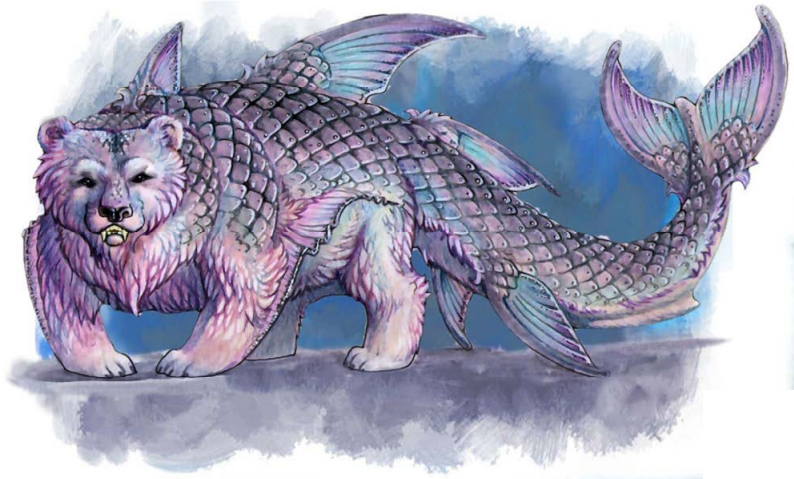
Bear, Nanoqaluk (CR 5 Large Animal)
Speaking of polar bears, this creature is literally a fish and a polar bear fused together. The nanoqaluk is a genetic engineering experiment of the ice elves that was originally meant to save the polar bear from extinction, but has ended up as a beast of war in the centuries afterward. It also happens to feel really pointless when you place it right after the akhlut. The nanoqaluk is smaller and can breathe both water and air, but otherwise it feels strange to say that the ice elves have a favored sea bear mount and then give them another favored sea bear mount as literally the next entry.
Brother of Frost (Class Level-Dependent Medium Outsider [Air, Water])
These guys basically look like blue-scaled lizardfolk and act like lizardfolk, but the similarity is purely cosmetic. They are actually human cultists from before the Great Flood who fused themselves with frost salamanders. Strangely, even though they were fused with frost salamanders and go so far as to be able to sustain themselves eating only ice (but like cold meat too much to do so fully), they do not have the Cold subtype, instead having a mere cold resistance 5. As characters, they are keyed toward being mixed martial-caster characters, with a +2 to Charisma and Constitution (but -2 to Wisdom), a +1 boost to caster levels with Water domain spells, and the ability to cast frostbite once per day as a spell-like ability.
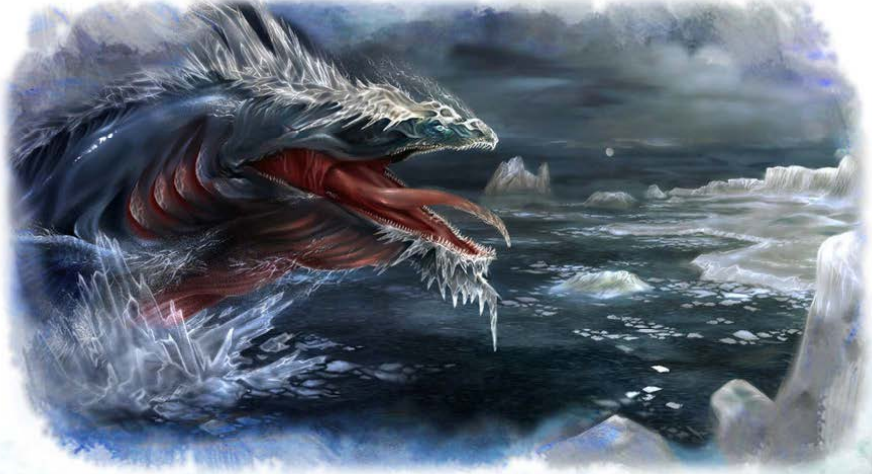
Cryoviathan (CR 18 Colossal Magical Beast [Cold])
These immense icicle-studded sea serpents of the poles are the stuff of legends, appearing only briefly between decades of slumber and said to be capable of consuming entire villages. It can back up that fearsome reputation, too – with a simple exhaling breath it can create a mile-radius blizzard once per day, striking its icy hide with a melee attack results in 6d6 cold damage in retaliation and the possibility of the weapon just straight up breaking, nearly any ship can be easily capsized as it surfaces, and when particularly angered it will rear up and slam its entire immense weight down on a foe.
Dragon, Orchestra (CR 5 Small to CR 18 Gargantuan Dragon [Cold, Water])
Because true dragons never go out of style, Indigo Ice has a brand new type of song dragon in the orchestra dragon. These guys resemble massive scaly and spiky orcas and think of themselves as the arbiters of the natural order. They roam the seas from pole to pole with their orca posse, looking for people who are upsetting the balance of nature so they can then proceed to beat them up. They are capable of extending combat bonuses to attack or armor class to their orca pod, make their orca pod immune to cold damage, share spells with their orca pod, and generally coordinate them at will. Of course, orchestra dragons aren't entirely dependent on their orca pals, being capable of exhuding a slowing breath weapon and utilizing powerful bite, claw, and tail attacks. A great wyrm orchestra dragon can even pull a “rocks fall, everyone dies” and summon a massive (600 feet in width and length, 300 feet in height) iceberg once per day.
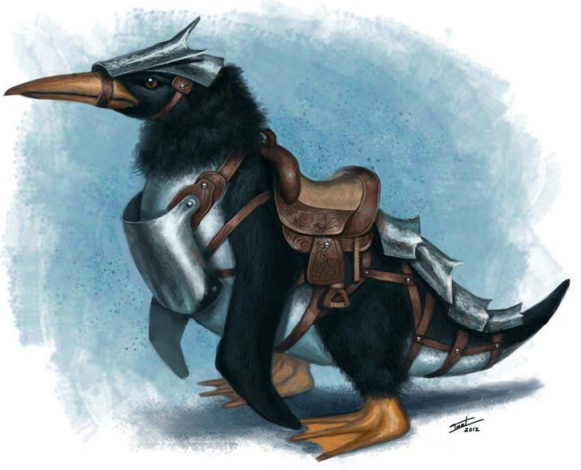
Kairuku (CR 1 Medium Animal)
Believe it or not, these man-sized penguins are not merely a fantasy dire animal. Kairuku grebneffi lived in New Zealand during the Oligocene period around 25 million years ago, and was actually one of a long lineage of giant penguins that existed in the region in the deep past. In the world of Isinblare, they are ridden into battle by the squawks, who apparently see nothing at all strange about penguins domesticating bigger penguins to ride into battle as some sort of omni-penguin war force. Unfortunately, no matter how well trained they are, a kairuku loves to steal shiny objects and will use its ranks in Sleight of Hand to do just that even to its master's allies.
Kraken, Polar (CR 15 Huge Magical Beast [Cold])
A twisted amalgamation of deep sea creatures, the polar kraken has the body of a massive squid combined with the lure of an anglerfish and the horrendous maw of a lamprey, all combined into a translucent package capable of sliding through ice as if it wasn't even there. Unfortunately, all it is is just a big pop scare monster to have ambush your players. Now, I have nothing against the idea of a monster being just a monster, but the problem with it in this case is that the polar kraken has an Intelligence score of 19. A creature with an intellect nearly double that of the average human is stated implicitly in the fluff to pretty much do nothing but normal apex predator stuff, being “degenerate” compared to the warm-water scheming empire-building kraken. If they're so degenerate, why not actually cut their Intelligence score? Why give them such a high Intelligence if they aren't even allowed to use it? It baffles me.
Ice Lich (CR +2 Template)
If a normal lich somehow isn't enough for you, the icy wastes of Isinblare are home to this fearsome frosty variant of the classic undead arcanist. On top of all the normal traits you'd get from the lich template, the ice lich has a compound aura that has both a fear effect and a chilling component that turns water around the ice lich into difficult to see through slush and deals 1d10 cold damage per round. In addition, rather than having the paralyzing touch of a standard lich, the ice lich has what is referred to as “rime touch”. Getting affected by the rime touch means you are entombed in ice and sustained by a magical force, unmoving but very much alive. The fluff even states that an ice lich will usually keep rime touched foes as trophies, thawing them out from time to time just to interrogate them before sealing them up again, which eventually drives these poor “trophies” insane.

Ningen – Atshen (CR 3 Large Humanoid) and Qilanappa (CR 6 Large Humanoid)
Two more forms of ningen, being based on orcas and narwhals respectively rather than beluga whales like the talilajuk. The atshen are aggressive and popular as mercenaries due to their ability to shapeshift from size Large to size Small, with little else being told about them in the fluff. That's a shame, too. These ningen take their name from a cannibal giant in Inuit mythology that becomes larger and larger the more flesh he consumes, and is protected by a guardian spirit that makes him difficult to combat even for a shaman. When you think about that, “angry mer-orca” isn't quite as impressive.
The qilanappa have no such burden of naming history, but aren't elaborated on much either. They are stated to be effectively the game wardens of the ocean, being especially protective of the narwhals they resemble. A qilanappa is capable of teleporting anywhere within a 5 mile radius once per round, but only if there is only up to a single person actively watching them. Maybe the reason they carry a spear in tandem with their natural spear-like tusk is because they want to gouge everyone's eyes out to teleport freely.
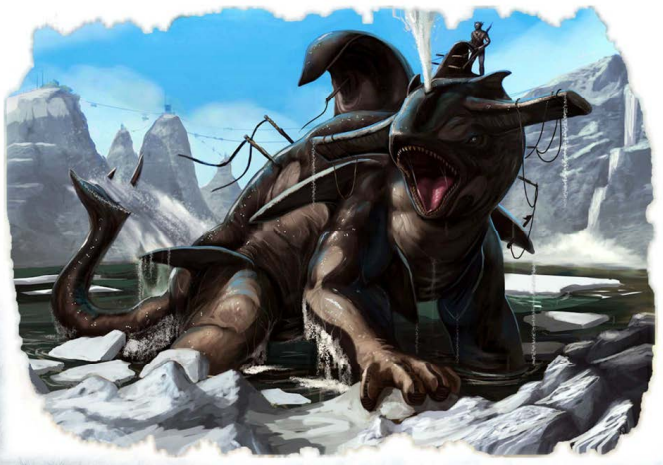
Orcoth (CR 10 Huge Magical Beast)
While the nanoqaluk was engineered out of pity for a critically endangered species and eventually utilized as a combat mount, the orcoth was created by the ice elves to be a living siege weapon from day one. Its massive bulk grants it a hefty natural armor bonus (+20, specifically), which is combined with a cornucopia of natural weapons – a powerful fluked tail, massive jaws, thick claws, and even a weaponized blowhole. Yes, it seriously has a weaponized blowhole, as it can spew a jet of water that acts as a breath weapon that deals 2d6 bludgeoning damage. Of course, every armor has its weak spot, and the orcoth's is that it is incredibly indecisive. Kill its ice elf handlers, and it flails around violently a little before attacking anything in sight, stand around doing nothing, or run away at random.
Qalupalik (CR 5 Medium Fey)
Another creature from Inuit lore, the qalupalik, or qalapilluk, is a sea hag that acts as what folklorists refer to as “nursery bogies” – a monster specifically created to scare children out of a specific behavior. In the case of qalupalik, the warning is to not go too close to the edge of the ice alone, lest she reach out of the water and take the child. Indigo Ice takes a much more sympathetic view on this creature, turning her from a boogeyman figure to a somewhat tragic entity. The game's qalupalik are fey that cannot reproduce on their own, so must take and transmute humanoid children in order to keep their species going. An Isinblare qalupalik may even lay her own life down if it saves a child in distress. Strangely enough, while she has a suffocating grapple attack, the qalupalik here has no actual transformation ability. This is something that the qalupalik in the Pathfinder Bestiary IV actually does have, so I guess you could graft that power over if you wanted to use this version rather than the more traditional evil creature Paizo put out.
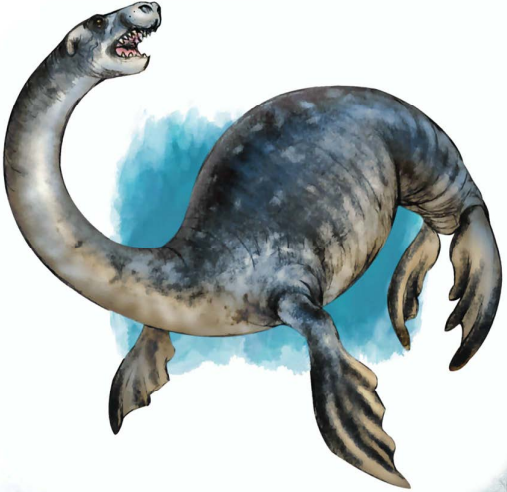
Seals – Fantail (CR 1 Medium Animal), Pelagiarctos (CR 7 Large Animal), and Waterhorse (CR 5 Huge Animal)
A triple threat of a fantasy animal, a prehistoric creature, and a creature of folklore. The fantail seal is created specifically as a guard animal, its one unique trait being an ear-piercing screech that drowns out all sound within a 60 foot radius. This ties directly into Pelagiarctos, a Miocene walrus that was built more like a leopard seal than the walruses we have still alive today, as Pelagiarctos in Isinblare use the fantail seal as an early indicator of potential prey being in the area. For whatever reason, the authors have envisioned this animal as being a horrendous roidbeast – if you damage the Pelagiarctos in combat, it will go into a Barbarian rage until either it or you are dead.
Then there's the waterhorse. The origin of this creature comes to us all the way from the Victorian era. Zoologist Anthonie Cornelis Oudemans wrote in 1892 that he believed the source of sea serpent legends was some manner of immense seal with both a long neck and tail, which he confidently dubbed Megophias megophias . This idea was later resurrected by Bernard Heuvelmans, the "Father of Cryptozoology", in 1968 when he suggested that long-necked sea and lake monsters such as the Loch Ness Monster were most likely huge long-necked fur seals that he gave the hypothetical scientific name Megalotaria longicollis . The waterhorse as statted here is an unimpressive creature with no ability scores above 20, 8 natural HD, and none of the supernatural abilities that mark the "true" lake monsters and sea serpents found in the first three Pathfinder Bestiaries. Its only unique ability is to "pluck" a foe Medium-size or smaller and either chew it each round it successfully grapples or drop it straight down 20 feet. Thanor Paladins will pay a lot of money for a successfully domesticated waterhorse to use as a mount, too.
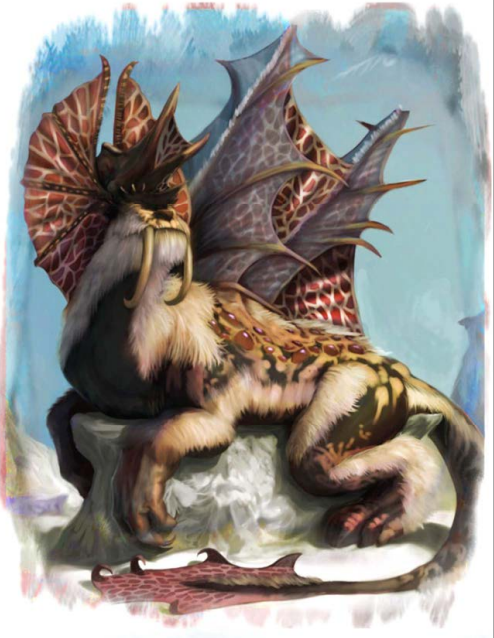
Sunhunter (CR 7 Large Magical Beast)
Behold, the most ridiculous monster in the frozen north! The sunhunter is some manner of big cat-like predator of the glacial expanse, stalking prey by boring holes in the ice with concentrated solar beams and hiding in wait. These solar beams can also be used to create a blinding flash in a 50 foot radius (which lasts for an impressive 2d6 rounds if the target doesn't succeed on their DC 18 Fortitude save) or straight up convert the solar beams into a breath weapon-style attack that deals a whopping 6d6 untyped damage. There is a catch, however, in that the sunhunter can only use its solar beam a number of times per day equal to its Constitution modifier, with two hours of staying in direct sunlight restoring a single use if it is still the same day. Thanors consider the sunhunter to be a sacred animal and will defend them from those who seek to harm them, so pray that a thanor isn't a party member if you end up having to fight one of these freaky fin-cats.
Tizheruk (CR 14 Gargantuan Magical Beast [Cold])
The tizheruk is a sea serpent from Inuit folklore, said to swiftly and silently grab fishermen without being seen in spite of its immense size. Indigo Ice depicts the creature rather differently, rendering it as an immense ice lizard that is an intelligent trickster spirit. They love to screw around with the residents of Isinblare, offering aid to those who go along with the pranks and eating those who react with hostility. This effectively takes the “harassment fey” monster archetype and applies it to a massive, clever Komodo dragon who can unleash a 10d6 sonic damage breath weapon and cast Trickery domain Cleric spells. I can seldom imagine something more horrifying.
Trueform, Hydrurgan (CR 3 Large Magical Beast)
The hydrurgans are awakened leopard seals that are known for being stoic, self-sufficient, and silent compared to the communal selkies. This hasn't exactly served them well, though, as the militant squawks have purged them to near extinction. What hydrurgans are left are either reclusive hermits or aggressive guerrillas that strike back against the squawk empire.
Whale, Icebreaker (CR 13 Gargantuan Animal)
Imagine a sperm whale that has its whole head extended into a thorny mess of horns – that's basically what the icebreaker whale is. And I don't just mean that physical description-wise, as it's also basically what the stats are. Their horns are used for both gore attacks and to plow through ice at half their normal swim speed. Various prey animals aren't the only thing icebreaker whales gore, as the text states they are aggressive enough to attack ships as well. Most of the warrior races of Isinblare have made attempts to domesticate them for use as a weapon of war as a result.
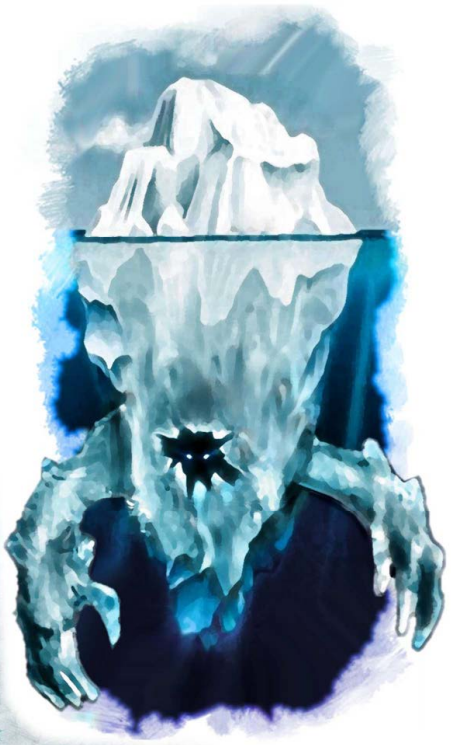
Winter Hulk (CR 6 Large Construct [Cold])
Our last monster for this title is a golem...sort of. It effectively looks and acts like a golem, magic immunity and everything, but is actually piloted by a Small humanoid fish called an ice hermit. The ice hermit has average human intelligence but engages in no acts beyond being hungry and territorial.
Final Thoughts
Indigo Ice is the niche title of a niche title. That alone does not damn a title to failure, though. While some parts may have been boring to attempt to recount, in actual game practice things like the feats would most likely be pretty helpful, as would the new weapons. What propels Indigo Ice upward a bit is that is succeeds in having bland but mechanically useful things tempered by actually flavorful and mechanically useful things as well. The Congulair is a pretty decent martial class that has a trippy as hell flavor to it, the races are great for the setting, and most of the creatures (issues such as the polar kraken notwithstanding) are at the very least interesting flavor-wise if not necessarily mechanically amazing. In the end, Indigo Ice is good at what it is: a niche title about aquatic polar escapades. Combined with one of the more broad polar sourcebooks such as Wizards of the Coast's Frostburn or MonkeyGod Enterprises' Frost and Fur? It could transform into something truly great.
Next Time...
I'll probably be doing some random stuff before the next Cerulean Seas book. Nothing that constitutes starting a whole new series before Cerulean Seas books are finished, as much as I want to review things like Conspiracy X, so one-off books and bestiaries can be expected. Definitely at least one d20 Modern title I've been eying a fair bit. Maybe you'll even see some GURPS reviews since those have been discussed and I do have a large GURPS collection. We'll see.
Azure Abyss: Introduction and Races
Original SA post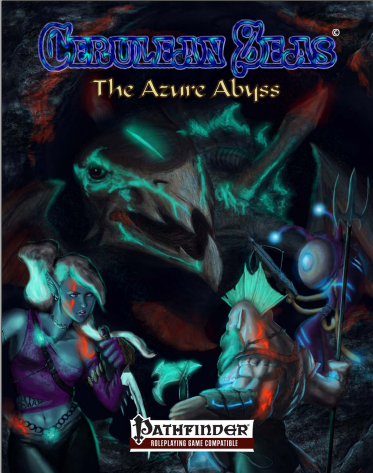
It's time to get back to Cerulean Seas rather than procrastinating about finishing that series and going off on other ones, and what better one to start discussing on Halloween than the sourcebook of the abyssal layer?
Chapter 1: Environmental Basics
Welcome to the world of the Under
On top of the usual environmental overview paragraphs, there are also a few new toxic hazards to add to your game. Sheets of Charisma-damaging and fatigue-inducing slime known as crimson wart hide in otherwise innocent mats of edible ooze, while geological seeps can yield poisonous amounts of barium, brine, copper, mercury, and sulfur. There is also a toxin from a fictional blue metal known as azulbryn.
Chapter 2: Deep Sea Races
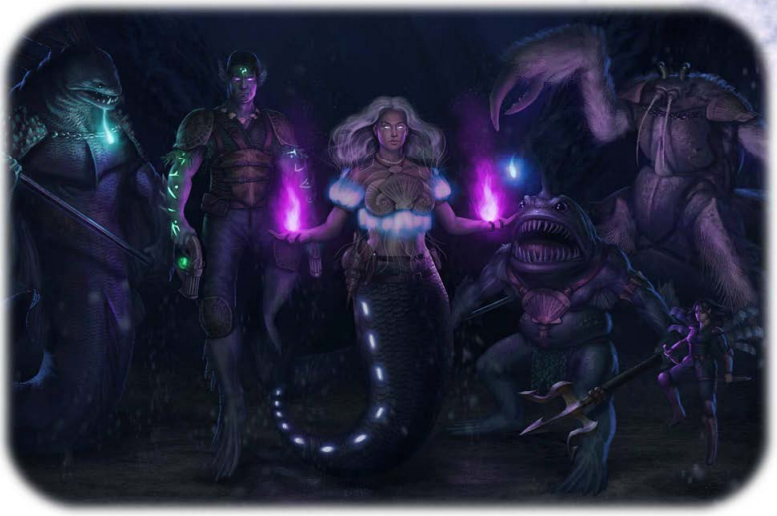
Pictured: abyssal variants of the Nommo, Seafolk, Piscean, Karkanak, and Nixie...oh, and an out of place Deep Drow between the Nommo and Seafolk
Aquatic Races Revisited
As with Indigo Ice, Azure Abyss's racial chapter starts with a look back at the core races from the Cerulean Seas Campaign Guide and how any of them fit in this alternate environment. The crab-like karkanaks have it best off in the Underdeep, having two different new subspecies. One, the abyssal karkanak , is themed after the real world crab creatively dubbed the deep sea red crab ( Chaceon quinquedens ). These karkanaks are differentiated by their bright red carapaces and lack of eyestalks, live in roving barbarian bands that pillage settlements on the abyssal plain, and the only difference between them and standard karkanaks stats-wise is that they have a depth tolerance of 20,000 feet and pressure sensitivity of 1,000 feet. Even stranger are the woolly karkanaks , based on the real world yeti crab ( Kiwa hirsuta ), which have deathly pale carapaces and fur-like filaments lining their limbs. Woolly karkanaks lose the Innate Craft racial ability in favor of a new racial ability known as Extremophile . This handy racial quality grants steam resistance 5, cold resistance 5, and an immunity to geological-based poisons and pressure damage.
The most extreme of the changes comes for the pisceans . Rather than the cod-like former slaves of the tropical coasts, the abyssal variant known as the ceratiodi are unsurprisingly based on the anglerfish. The hefty-bodied females gain a bioluminescent angler lure that sheds as much light as a torch, depth tolerance of 20,000 feet, and pressure sensitivity of 5,000. And the males? Well, they no longer use the piscean stats, instead using the stats of a size Tiny fish with the Trueform (Awakened) template because they are worthless little parasites/sperm banks just like real male anglerfish. It is also probably worthy of note that these are meant to be a player race alternative to the 4 HD Monstrous Humanoid of the same name from Paizo's Pathfinder Bestiary 3.
Lastly, there are the three less abyssally-inclinded abyssal races. Abyssal seafolk look like paler versions of regular seafolk, have a depth tolerance of 15,000 feet and pressure sensitivity of 500 feet, and have a 20% chance of having their mer half be that of a fish that has bioluminescent spots that grant the same lighting as a torch. Similarly, the abyssal nommo have an angler lure on their chin that sheds as much light as a torch (again), a depth tolerance of 15,000 feet, and a pressure sensitivity of 1,200 feet. The least changed of all are the nixies . They don't even go fully into the abyss, staying further up near the twilight zone of the open ocean, and simply have their depth tolerance increased to 10,000 feet without even having to worry about any pressure sensitivity being added. There's also a mention of deep drow , but purely in the sense of "hey these were in the bestiary section of the core campaign guide, go look there if you want to recall what they're like".
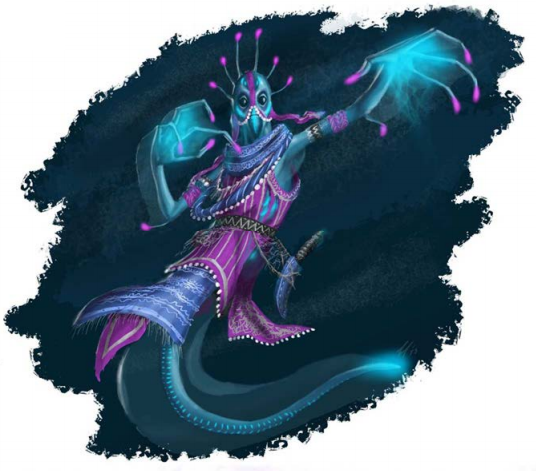
Asterak
Okay, now it's time for the first of the completely new races, and we start off on a good foot. I really like the idea of the asterak: they're merfolk that are appropriately freaky for the abyss, with translucent skin and various bioluminescent appendages used to communicate with each other. Even their mating habits are unusual, with their crystalline eggs being "fertilized" through electrocution, which explains why they are one of the only merfolk that don't have crossbreeds. They usually keep to themselves and mostly focus on survival, living nomadic existences on the abyssal plain with no real end goal in mind. Asteraks see all lifeforms as equally basic animals and treat other sapient races as wild creatures to be respected but avoided, their opinion of verbal language is "use it if you have to or if it sounds musically interesting", and asteraks that go out of their way to become adventurers and associate with other races are seen as creepy perverts that are most likely mentally unsound. Of course, this is a species that is stated to regularly steal from or practice vivisection on wizards because they find arcane magic so interesting and useful to survival, so thinking adventurers are weird is the least of their societal quirks.
Asterak characters +2 Intelligence and Constitution but -2 Strength, darkvision at a rnage of 60 feet, electricity resistance 5, and the ability to cast shocking grasp once per day. They also have a special trait, Advanced Bioluminescence , that lets them change how much lighting they produce from no light at all up to the strength of a hooded lantern. Due to their acclimation to the depths, they suffer from a pressure sensitivity of 1,000 feet.
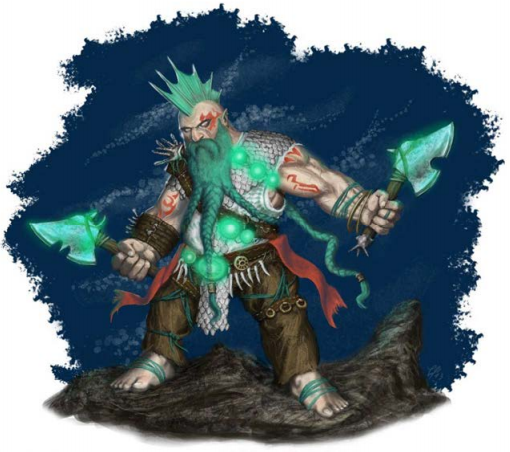
Austorian
These guys are the last of the dwarves, spared from the Great Flood by sheer coincidence. They were originally dwarves from the Austoria Mountains who mutated themselves with aboleth technology in order to mine azulbryn from a massive subterranean lake. By the time they had dug greedily and deep, they learned from the seagoing races that the Great Flood had happened and the other dwarves were gone. Culture and appearance wise, they are just your stereotypical fantasy dwarves with a smattering of ocean living added on. They have the same ability score modifiers, speed, and most general racial traits as regular dwarves as well. The only difference is that the lose the Stability and Hatred traits in favor of the Extremophile trait and the ability to breathe air and water equally.
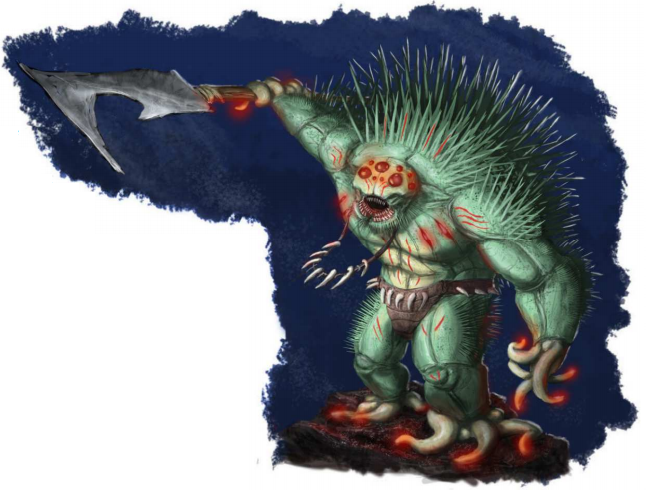
Echinn
The echinns are the extremophile's extremophile. The abyssal voids they live in are referred to as "echinnlands" because no other sapient creature can survive there. It also happens that I like this race for the same reason that I like the asterak: they are truly strange to outsiders. Male and female echinns look the same, they cannibalize their dead out of respect and to not let things go to waste, and they communicate through touch. They are also mostly atheistic and materialistic due to difficulties in mental visualization, which often prevents them from understanding concepts such as deities and magic. One thing echinns are very good at visualizing, though, is vengeance. A tribe can hold centuries-long grudges against an entire race because a few members of that race enslaved them in the distant past.
Echinns are not as mechanically interesting as they are flavorful, however. +2 to Strength and Constitution but -2 to Intelligence and Wisdom, a +2 natural armor bonus to AC, a +4 bonus to saves against ingested poison, the Extremophile trait, and venomous spines that deal Dexterity damage all scream "tank". And look at that, their most common classes are Barbarian and Fighter! What a shocker.
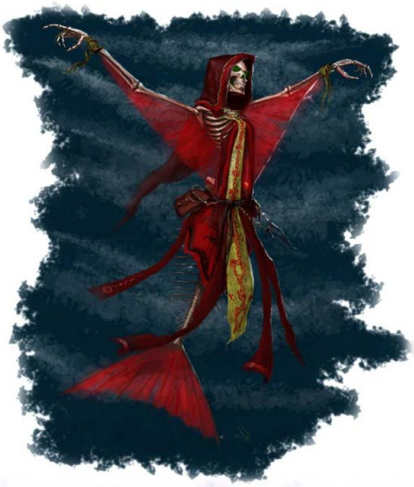
Obitu
For lack of a better term, obitu are "reverse-undead". That is, they were once undead, but infected with a virus that made them alive again. This virus comes from a gigantic sapient psionic brain coral called the source-mind, and obitu treat source-minds as their mothers and monarchs. More obitu are made when they travel out, beat the shit out of the first undead they find, take it captive, and then force feed the undead creature to a source-mind. The entire reason they even become adventurers is so that they can make more obitu for the source-minds.
I think I am in love with these guys.
As if being the reverse-undead heralds of giant psychic coral weren't great enough, they also have a really eclectic racial setup. They focus on both defense and maneuverability, with +2 to Strength and Dexterity contrasted by a -2 to Charisma, +4 bonus to saving throws against disease and poison, +2 bonus to Acrobatics, Escape Artist, and Sleight of Hand checks, resistance to negative energy damage equal to half their class level plus 5, and an immunity to sleep effects because they are a literal embodiment of that whole "they do not sleep, they merely wait" catchphrase. The only sad thing is that they aren't of the Aberration type or something rather than Humanoid, because they're so damn freaky.
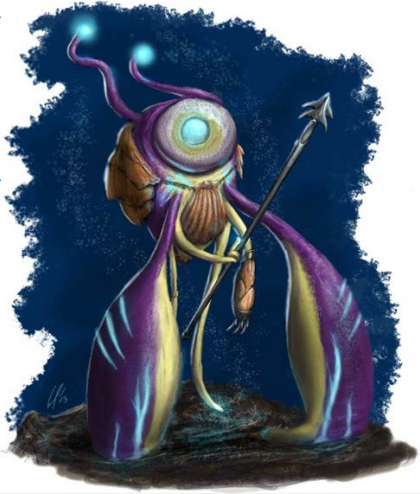
Viden Oculus
The oculi are creatures of the Aberration type that, surprise surprise, are mostly made up of one big eye. The viden is the first life stage of the oculus, and the only playable one. They are paranoid, power-hungry racists, which is actually a step up from the power-mad imperialists that the later life stages become. This also presents a bit of a contradiction in the text. While viden are stated to wish to accumulate power to advance to their next life stage, they are also given the caveat of being able to just stay in the viden stage forever so that the Game Master just doesn't yank away your viden character.
Being a size Small Aberration, they are both the only non-Humanoid and non-Medium size playable race in Azure Abyss. +2 Dexterity and Wisdom but -2 Strength is pretty much expected for a small swift enemy, and bioluimescence and pressure sensitivity of 1,000 feet aren't exactly unexpected either. What's definitely a bit unexpected, however, is the Acidic Tears quality. The viden oculus is capable of oozing acidic secretions, which only do a single point of acid damage but is still certainly unique.
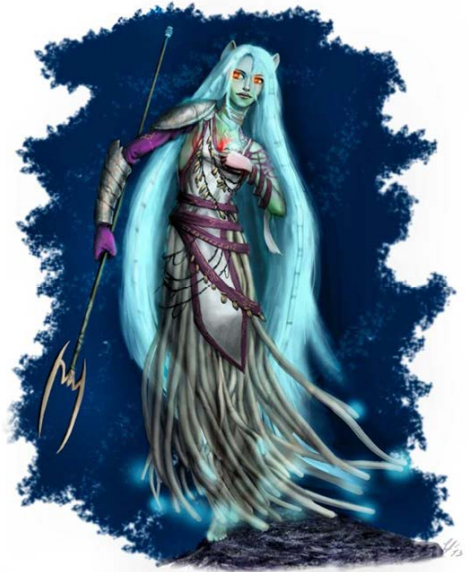
Rusalka
So Kawaii posted:
Abyssal rusalki are Medium-sized, lithe, and pale female feykith. They have large orange eyes, translucent blue-white skin, and cat-like ears. Their hair is long, transparent, and nearly invisible when not lit by two luminescent antennae that flow from the top of the rusalka’s head and down either side of her body. A skirt of dozens of jellyfish-like tendrils sprout from a rusalka’s waist, each tipped in blue luminescence. A rusalka’s blood is likewise radiant, and her heart can be seen pulsing with red light in her chest. Despite their alien composition, most humanoids find the abyssal rusalka to be hauntingly attractive.

While most abyssal races know about this terrifying aspect of the rusalki's nature, they tend to be seen as being of little threat because they prey on shallow-water races and mostly prefer to fight other rusalka clans over any of their neighbors. Peaceful democracies of like-minded rusalki become bloodthirsty when they clash against clans of opposed alignments.
Rusalki characters get +2 to Dexterity and Charisma but -2 to Strength, as well as a +1 to saving throws for Enchantment spells. Their two most interesting abilities are Blazing Blood , which allows the rusalka to eject her luminescent blood in a 1- foot cloud that provides total concealment but is very blatantly glowing, and a variant of blood drain named Stinging Skirt due to the fact that the tentacle "skirt" of the rusalka is what does the HP drain.
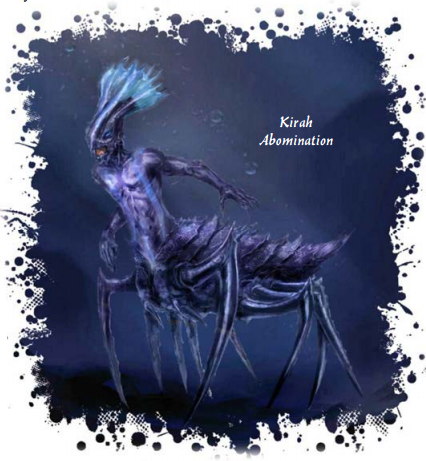
Hybrids
Not many hybrids this time around. Just two, in fact. One is the kirah , a "deep drow abomination". These are the oceanic equivalents of driders, and in the case of the kirah they are a fusion of deep drow and a type of demon known as the minion of Saloth that we'll meet later on in this book. This boosts the deep drow's sie to Large and alters their ability scores with +2 Strength and Charisma but -2 WIsdom, as well as providing a +2 natural armor bonus to AC. Kirah are unsurprisingly usually demonic in nature.
The other new hybrid is the deodona , a hybrid of seafolk and echinn. These are effectively pufferfish merfolk: they have poisonous spines on their tails and backs and they can inflate to a rounded state that halves their movement speed but lets them attack and grapple as if they were size Large. How you get a pufferfish merfolk out of a regular merfolk and an anthropomorphic sea urchin is beyond me, but there it is.
Next Time: Yet another warrior base class that out-Fighters the Fighter, weird deep sea prestige classes, undersea loot, and deep magic.
Azure Abyss: Classes, Weapons, Feats, and Items
Original SA postAll the folks coming back to work on projects certainly made me realize I'd
totally forgotten about
been holding back on writing the next part of Azure Abyss.

Chapter 3: Deep Sea Classes
If you might recall, Indigo Ice introduced one new base class and three new prestige classes for Cerulean Seas. Well, Alluria Publishing is nothing if methodical, because the same number of classes is utilized here.
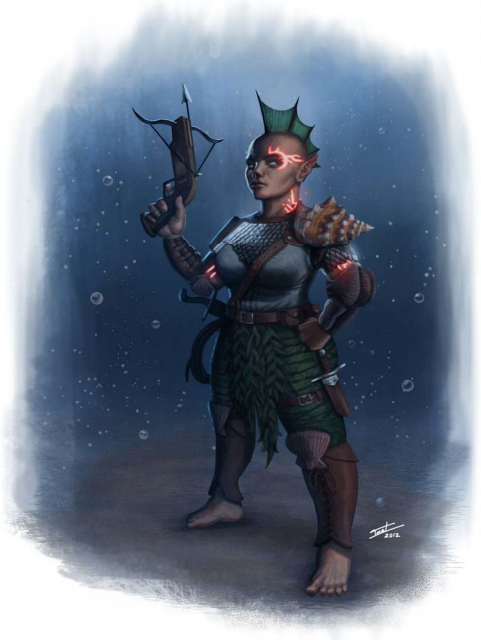
Angler (Base Class)
The Angler is effectively a combo of Fighter and non-casting Ranger, designed to be a rugged frontier warrior who takes no guff and kills deep sea monsters for profit. In spite of the comparisons I made to what role they are meant to be play, however, the Angler actually takes its biggest mechanical inspiration from the Rogue. It shares the Rogue's d8 hit die, and almost exactly copies the Rogue's Base Attack Bonus and saving throw progression, simply reversing Reflex and Fortitude to have the latter be good and the former poor in its progression. The Angler's actual class features, however, bring it into its own element.
The very first one you'll pick up is
Battlefield Prep
, which allows the Angler to literally shape the outcome of a battle, creating a 5 foot square of special terrain that grants a bonus to the Angler and allies or a penalty to foes. The Angler expends a number of successive standard actions, of which the total can't exceed half the Angler's character level plus their Wisdom modifier. Each standard action can be used to increase the bonus/penalty of the square's effect by 1 or to increase its size by another 5 foot square.
And what exactly does this preparation do? That varies between different preparations, of which the Angler starts with a single one and gains another at level 3 and then every three levels after that. The specific types of prep space the Angler can choose are..
-
Defensive Benefit:
Occupying the space grants you a bonus to Armor Class equal to the preparation number.
-
Defensive Hindrance:
Rather than boost someone's defense, you deal your prep number's worth of penalty to an enemy's Armor Class when they're on the space.
-
Movement Benefit:
Anyone starting their turn on the prep space gains +5 move speed for each prep number.
-
Movement Hindrance:
Yet again an inversion, with the target suffering a -5 penalty to move speed for each prep number when the start their movement on the space.
-
Offensive Benefit:
Standing in the prepped spot provides a bonus to attack rolls and damage equal to the prep number. You have to choose between melee attacks only or ranged attacks only, however. The spot can't grant bonuses to both.
- Offensive Hindrance: Yet another inversion of the last, granting a penalty to melee or ranged attack and damage rolls.
These preparations can be beefed up even more by taking three special preparations: Combined Preparation (you can put two of the previous preps on the same prep area), Lingering Preparation (anyone who spends at least a full round in the prep area still benefits/suffers from its effect after leaving the area for a number of rounds equal to the Angler's Wisdom modifier), and One Shot Preparation (the prepared area works for only one round for the first person to enter the area, but the benefit or penalty is further increased by the Angler's Wisdom modifier).
While this does mean that you're not doing anything else for every round you buff up your preparation space, the fact is that the total time a prep space (other than one made with One Shot Preparation) lasts for a number of days equal to the Angler's total character level. This means that, not unlike the stereotype of Batman, the Angler can defeat just about anyone with enough preparation time. It's definitely one of those things where how much leeway the GM gives you makes or breaks how powerful the ability is.
A far more straightforward ability the Angler also gets at level 1 is Harvest . Whenever you kill a creature that is of the Animal, Magical Beast, or Dragon creature type, you get a number of bonus gold equal to 10 x the monster's Challenge Rating. This bonus gold increases to 25 x the monster's CR at level 6, 40 x its CR at level 11, and 55 x its CR at level 16. Hopefully you're kind enough to split your profits with other party members.
There are also yet another two class features gained right off the bat by the Angler. One, Trapsmith , is is a straightforward set of bonuses: 1/2 the Angler's character level added to Craft (Trapmaking) checks, Disable Device checks, and Perception checks that are made to locate traps,as well as the ability to make traps at a third their normal price. The other is another class feature that you'll be seeing just as often as Battlefield Prep. At level 1 and every three levels afterward, the Angler gets to choose one of the listed Angler's Traps . These are unique "step in the square to activate" traps that the Angler alone can create. While some replicate spells or supernatural powers, all are considered to be Extraordinary rank abilities. Some of these traps definitely don't feel special, but see for yourself rather than take my word for it.
-
Alarm Trap:
Stepping on the trap causes an alarm to sound, replicating the
alarm
spell.
-
Alchemical Attack Trap:
The trap releases a spewing mess of either acid or steam, dealing 1d6 + half the Angler's character level in damage. A Reflex save means the damage is ignored.
-
Alchemical Explosion Trap:
As above, but the damage is dealt to all adjacent squares as well as the trap square.
-
Marking Trap:
The individual that set off the trap gets coated in some manner of colored dye or scent marking, which lowers all checks to track them by 4. It's stated to fade over "several days", so I guess however many the GM feels appropriate.
-
Poison Trap:
Unsurprisingly, the trap delivers a poison. It can be of any poison type other than ingested.
-
Snare Trap:
The trap entangles the foe, with the usual options of Escape Artist or Strength check to get out.
- Swarm Trap: A jellyfish, hagfish, or leech swarm bursts out of a box when the trap is triggered. This is the best trap simply because it's amazing to think of taking the effort to stuff jellyfish into a box just to hurt someone with them later.
Beyond first level, you'll only find two other class abilities beyond more bonuses to those starting sets. At level 2 and every three levels afterward, the Angler gets a bonus feat . Unlike the Fighter, though, they have access to quite a variety of feats, from stealth feats such as Fast Crawl and Nimble moves to tanking feats like Diehard and Rugged Northerner. Finally, you have the capstone feature of the Angler class, Master of the Field . This doubles the bonuses of any Battlefield Prep ability. This can be combined with a feat called Quicken Battlefield Prep that does the same thing, allowing you to get 4 points per standard action.
While I usually prefer to discuss my opinions on classes and such in my final thoughts, I'll not that the Angler falls into that odd category of being an interesting class, but not quite matching up with what you expect. The flavor text prepares you for some grizzled frontiersman that looks like they wandered right out of an adventure game, but most of the class's actual abilities are related to subterfuge and preparatory measures. Harvest is the only class feature that directly ties into the opening fluff statement of "charting the unexplored and slaying the beasts that nip at the civilized world's edges".
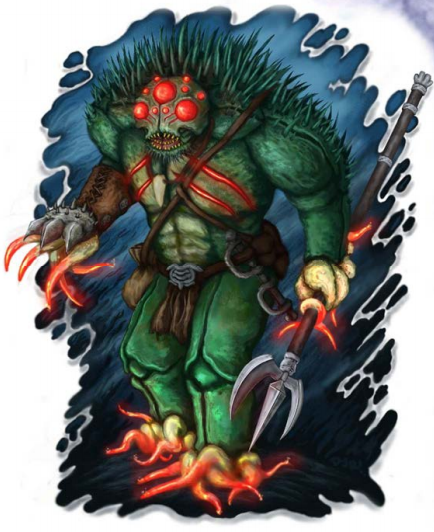
Halionaut (10 Level Prestige Class)
Halionauts make a living going through random portals and seeing what they find. If you recall the Horizon Walker class from standard D&D and Pathfinder, it and the Halionaut are a lot alike. And by a lot alike, I mean the Halionaut is literally the Horizon Walker with land terrain names swapped out with ocean terrain names. The only thing the Halionaut has that the Horizon Walker doesn't is an ability called Eerie Foresight , which lets them see a portal's "danger rating", an arbitrary 1 to 10 scale that the GM determines.
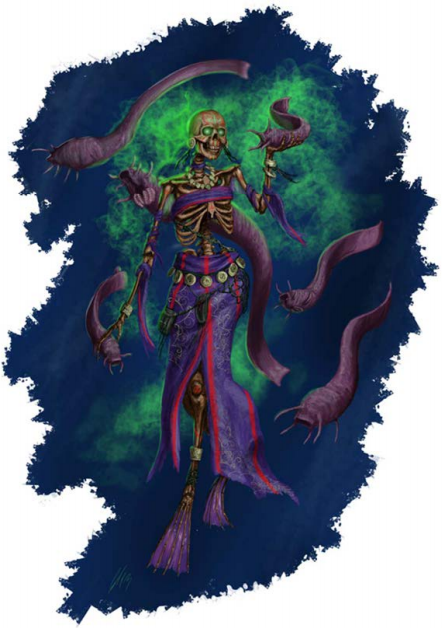
Myxinmave (10 Level Prestige Class)
And then, as if to say "sorry the Halionaut is so boring", the very next page grants us the glory that is the Myxinmave. This is a spellcasting prestige class that reflects someone who absolutely adores hagfish, so much that they take great lengths to fraternize with and emulate these deep sea scavengers. Beyond that amazingly crazy premise, however, is the class any good? Well, it definitely starts out with a nice framework. Above-average Base Attack Bonus progression, average Fortitude and Reflex saves contrasted by a below average Will save, and d6 hit dice are the makings of relatively standard combat casting class. It also counts as a caster class for spell levels, which is always important.
A level 1 Myxinmave gets two class features right off the bat. Hagfish Servant grants a giant hagfish with the Intelligence score and various other bonuses granted to a familiar. This hagfish will split into two identical hagfish at level 5 of the class, and again into four identical hagfish at level 9, just in case one wasn't enough to love. The other feature, Hagslime , grants a +1 bonus to Armor Class, Escape Artist checks, and CMD against enemy grapple attempts, as well as the ability to spew a large slime cloud once per day. This cloud is a non-magical version of the quagmire spell from the Cerulean Seas Campaign Guide that has a 10 foot radius. At level 4, 7, and 10 of the class, the various bonuses conveyed by Hagslime increase by a further +1and the Myxinmave gets another use of the slime cloud spewing ability per day.
At level 2, the Myxinmave has the ability to freely transmute their face into a hagfish mouth with the ability Consume Flesh . The bite attack deals only a single point of damage usual, but can be used to make a successful grapple attack that deals 2d6 points of damage as the Myxinmave rasps flesh from the victim. This doesn't work on creatures without flesh, but that probably won't make much difference unless your GM just constantly throws skeletons and golems at you.
Immunity to Putridness comes at level 3, granting immunity to natural diseases and mummy rot, ingestible and inhaled poisons, and undead stench. Not quite that exciting? Don't worry too much, as level 4 has Knot Armor . This class feature lets the Myxinmave wear a bunch of hagfish (known as a knot) as armor, granting a unique type of damage reduction. The knot can absorb a number of points of damage equal to 10 + 5 per level in this prestige class the Myxinmave has, dying if they take 10 damage from a single attack or if they take all the total damage they can. Fear not, however, as they resurrect and reappear every morning! The only downside is that you can't wear regular armor and knot armor at the same time.
Level 5 and we have Fins of the Hagfish . This improves the Myxinmave's swim speed by 10 feet and grants a tail slap attack that deals 1d6 damage if the character is Small, 1d8 if they are Medium, and 1d10 if they are Large. The very next level, the Boneless class feature continues the train towards becoming one with the hagfish, granting a further +4 bonus to Escape Artist checks and CMD against grapple attempts, as well as the ability to squeeze through areas as if the character was one size category smaller.
At level 7, we take a minor detour from emulating hagfish with the Spew Hagfish feature. With this ability, the Myxinmave gets a hagfish breath weapon they can use once per day, dealing 1d6 damage per Myxinmave level in a 30 foot cone. The hagfish that are belched out are also kind enough to stay around, acting as a hagfish swarm under the character's command after the damage is dealt. There's also Poison at level 8, which is...well, poison. A poison from the Consume Flesh jaws that deals 1 Strength damage per round, specifically.
Last, but certainly not least, is the capstone ability Hivemind . The hivemind is made up of up to 50 individuals, including the Myxinmave and their giant hagfish servants, and gain various bonuses. Each creature in the Hivemind gains +1 Intelligence and Charisma per 20 creatures beyond 50 that are in the swarm, a +1 insight bonus to attack rolls and Armor Class, and awareness of what is being experienced by each member of the hivemind.
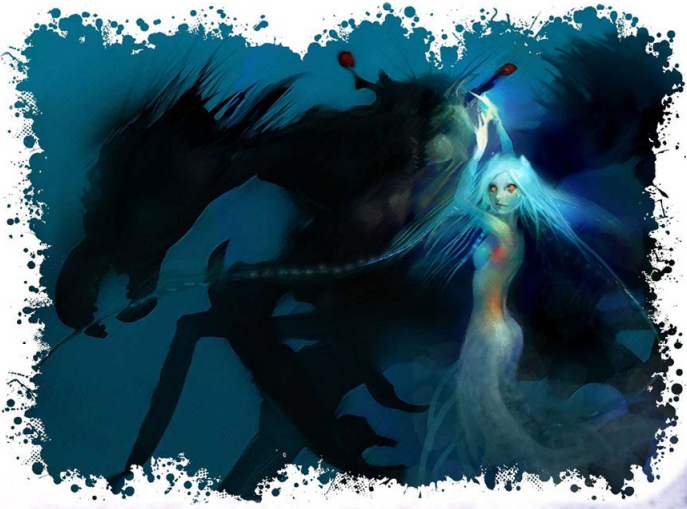
Seductor (10 Level Prestige Class)
Oh boy, an entire class based around seduction and manipulation! Just what I always wanted.
The Seductor has d8 hit die, but otherwise has the poor Base Attack Bonus progression, Fortitude saves, and Reflex saves offset by a good Will save you kind of expect from manipulator classes. They also gain a bonus +1d6 sneak attack every odd numbered level of the prestige class, even if they didn't originally have any levels in Rogue. Handy.
The Seductor gets three abilities out of the starting gate. Poison Use is the standard "you can't accidentally poison yourself when poisoning a weapon" stuff, Seduction adds the Seductor's levels in this prestige class to Bluff, Diplomacy, Disguise, Intimidate, Perform, and Sense Motive checks, and Seductor's Touch is the start of a multi-level ability. With Seductor's Touch, the Seductor makes a grapple check. If successful, they can impart the charm person spell. This extends to being able to impart the suggestion spell at level 4 of the class, 1d4 Strength or Wisdom damage at level 7, and 10 minutes of paralysis at level 10.
Level 2 has Save Bonus Against Poison , which is a +1 save bonus against poison (duh) that increases by a further +1 at every two levels afterward. Secret Alignment at level 3 grants permanent undetectable alignment as a supernatural ability. And at level 5, there's a once per day ability called Shield of Helplessness . Basically, all creatures in a 15 foot radius are forced to make a Will save or automatically believe the Seductor is a damsel in distress.
Oh, and at level 9, the Seductor gets Hidden Mind , which is permanent mind blank as a supernatural rather than spell-like ability. The description states that if dispelled, this ability cannot be resumed for 1d4 rounds. That would certainly be potentially useful if it wasn't for the fact that dispel magic only works on spells and spell-like abilities, not supernatural abilities.
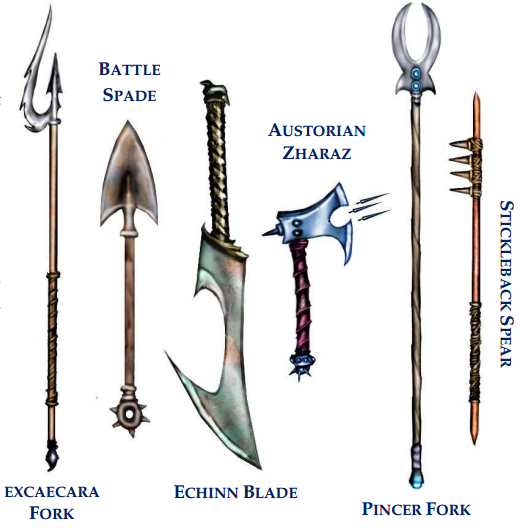
Chapter 4: Deep Craft
Weapons
Six new weapons are provided for characters from the Azure Abyss: one martial, two simple, and three exotic, all melee. The excaecara fork , also known as the bident, is the lone martial weapon and basically resembles a trident with only the middle and left tines. It deals 1d6 piercing damage for a Medium-size creature and was created by the oculi specifically to blind rogue oculi. For simple weapons, there is the battle spade , a combat shovel which deals 1d6 slashing damage for Medium wielders and helps dig through earth at increased speed, and the stickleback spear , a small probing stick that only deals 1d4 piercing damage for a Medium wielder and is designed more as a deterrent against attackers than a weapon of war.
Out of the three exotic weapons, the most deceptively simple is the zharaz . Created by the dwarves of Austoria, this weapon looks like a bisected hatchet, and deals 1d4 slashing damage in Medium hands. It has a dirty little secret in between the two halves of its blade, however, in that there is a small compartment meant to hold a dart made of azulbryn. On a successful hit from the main weapon, the dart (if present) lodges in the opponent and automatically starts dealing azulbryn poisoning.
More straightforward is the echinn blade . It's a big, nasty hooked blade designed to pry open crustaceans, dealing 1d10 damage for a Medium wielder and granting a +1 bonus to attack rolls against foes that have a natural armor bonus to Armor Class. The pincer blade is also pretty easy to understand, being meant for dealing with tentacled creatures. It can deal 1d6 slashing damage with a Medium wielder, but can choose to do nonlethal rather than lethal damage if it uses the dulled outer blade of the fork rather than the sharp inner one.
Feats
With twenty-one feats, you'd think there would be more variety here, but that's not really the case this time. All but two of them are racial feats, and those two that are left over both deal with the Angler's Battlefield Prep class feature! Sadly, the racial feats are all pretty bland too, with examples including Boon of Bones (an obitu gains the resistance to slashing and piercing weapons that undead skeletons have), Sharper Spines (an echinn's spines deal more damage than usual), and Virulent Poison Cloud (a deep drow's poison cloud has a +2 higher save DC than normal). The only really stand-out feats are Azulbryn Eater , which allows Austorian dwarves to gain a +1 bonus to all saving throws and skill checks for an hour after eating azulbryn as opposed to being poisoned by the radioactive blue metal, and Nibble Armor , which allows an echinn to sunder armor with its mandibles when in a grapple.
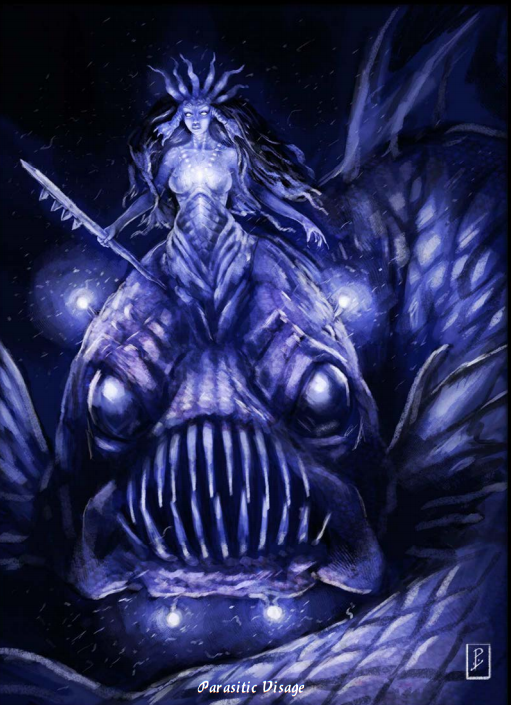
Spells
Ten new spells here, so once more I can look at all of them briefly rather than pick and choose like I would for a much larger count.
-
Abyssal Murk (Conjuration; Sorcerer/Wizard 6):
Recreating the effects of a black smoker, this spell obscures as per
quagmire
but also deals 3d6 points of steam damage each round a creature spends in the cloud.
-
Acid Zone (Transmutation; Kahuna 5, Sorcerer/Wizard 5):
In an area of one 5 x 5 cube per caster level, seawater becomes highly acidic and deals 1d6 acid damage per round to everything in the area.
-
Biolight (Transmutation; Alchemist 21, Magus 2, Siren 2, Sorcerer/Wizard 2, Summoner 2, Witch 2):
You make yourself bioluminescent. Considering how many of the player races in Azure Abyss already have natural bioluminescence, it's surprising that nearly every spellcasting class has access to this spell...or at least it would be, were it not for another spell later on.
-
Bloodworms (Conjuration; Kahuna 4, Sorcerer/Wizard 4, Summoner 4, Witch 4):
You summone a bunch of bloodworms, a type of oceanic polychaete worm that has a rather nasty poisonous bite. The bites deal 1 point of Constitution damage and decrease the target's swim speed by 5 feet.
-
Enemy Within (Enchantment [Evil]; Siren 2, Sorcerer/Wizard 2):
This spell causes the target to believe that their own body is enchanted against their will, and they deal damage to themselves as fast as they can.
-
Extinguish Biolight (Necromancy; Antipaladin 2, Cleric/Oracle 3, Darkness domain 2, Siren 2, Sorcerer/Wizard 2, Witch 2):
You permanently make something that is bioluminescent no longer bioluminescent. It is dispelled by
biolight
.
-
Lumenspear (Transmutation; Cleric 2, Kahuna 2):
You use your own bioluminescence to make a melee weapon out of light. It can be any weapon you are proficient with, and acts as a magical weapon for purposes of overcoming damage reduction, so go crazy.
-
Parasitic Visage (Sorcerer/Wizard 9, Summoner 6, Witch 9):
You fuse your lower half with the head of a creature at least two size categories larger than you are. In addition to making yourself effectively a weird hat for the creature, you get to mind control it. You gain its size, buoyancy, depth tolerance, natural attacks, immunities, resistances, physical ability scores, extraordinary abilities, and basically everything except for its supernatural or spell-like/psionic abilities and its mental ability scores.
-
Smoker Hop (Conjuration); Magus 7, Sorcerer/Wizard 7):
You temporarily stop taking steam damage, and teleport from one geothermal heat source to another within 3 miles.
- Summon Hagfish (Conjuration; Kahuna 2, Siren 2, Sorcerer/Wizard 2, Summoner 2, Witch 2): You summon either two giant hagfish or one hagfish swarm. Since it's the spell you need to be able to enter the Myxinmave prestige class, it's convenient that there are a fair number of casting classes that can learn it.
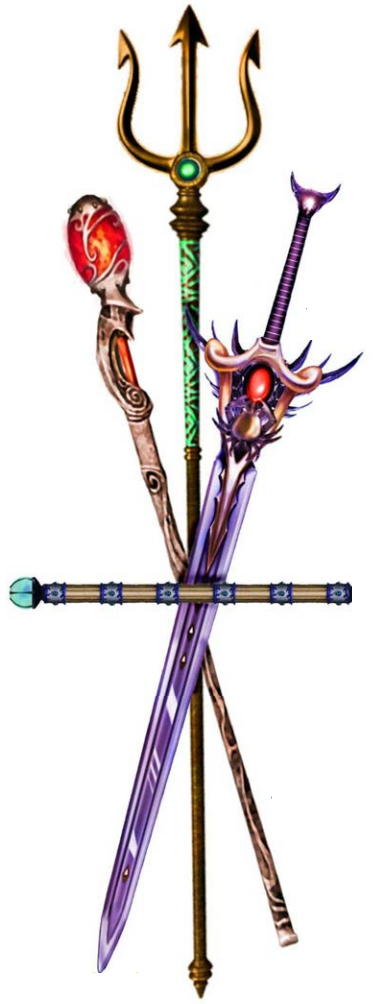
Underdeep Magic Items
Closing out chapter 4 are eight magic items themed around the deep sea, starting out with the Bracers of Bioluminescence. These gem-lined bracers have a constant casting of biolight and let you cast extinguish biolight , light , and lumenspear three times a day. These and the item directly after, the Goggles of Deepsight (which grant darkvision out of 60 feet) seem more tailored for those traveling to the deep than those that already live there. By contrast, the Oculus Wand is created and utilized by the oculi, and can be used to cast any level 0 or 1 spell with the word "detect" in its name. Because they're giant eyes, you see.
If jewelery is more your thing, the Ring of the Underdeep can grant steam and cold resistance 5, pressure immunity, and geopoison immunity. Then again, there's always weapons, which make up the four remaining magic items. The Rod of the Anchor is a quarterstaff that also acts as an immovable rod and can cast reverse buoyancy once per day that the caster gets to ignore, the Staff of the Vents is a boiling burst quarterstaff that can be used to cast boiling hands , boiling bubble , mageboil , volcanic vent , hot springs , abyssal murk , or smoke hop , the Sword of the Crab is a +2 keen bastard sword that grants its wielder continuous freedom of movement and water breathing as well as the ability to turn into a Medium crab once per day, and the Trident of the Depths is a +3 trident that deals an extra 1d6 damage when below 1,000 feet of water but turns into a -3 cursed weapon if it is brought above that depth.
Next Time...
Azure Abyss gets finished off with plot, location, languages, gods, and monsters.
Azure Abyss: Setting and Bestiary
Original SA postI was hoping to have this done and move onto a new book by 2015, but oh well. Let's finish off...

Chapter 5: The Azure Abyss Setting
While technically in the same world as the rest of Cerulean Seas by default, Azure Abyss is meant to have a strikingly different tone. The idea is that in the abyssal plain, there's a lot of evil and the players are supposed to be beacons of light in a sea of literal and figurative darkness. The greatest power in the abyss is the
Axis of Evil
Dark Trinity, a union of obitu slavers, deep drow politicians, and oculus warlords. In spite of being the epitome of Evil, their home base (named, of course, the Sinister Sink) is probably the safest place in the abyss thanks to their power, and they tend to be tolerant of other races as long as they are useful. This means that everyone ends up working together for the most part. The asterak traders come to ply their wares in the Sinister Sink, the rusalki work side by side with the Trinity as diplomats, and the austorian dwarves toil in their mines as they always have and share some of their profits in turn for the safety the Trinity provides. And...that's about it, really. Beyond the Sinister Sink, it's a big, dangerous place with lots of horrible monsters, undead, poison, traps, and general unpleasantness. Think
 but underwater.
but underwater.
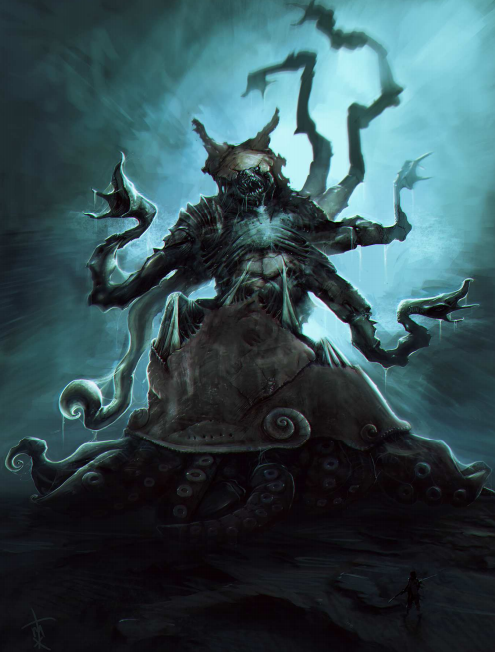
Religion in the Underdeep
Outside of the sway of much of the Council of Nine, cults and pantheons of the old gods hold greater sway down in the depths. Of the nine gods approved by the Council, however, two are fairly well-known and widely worshiped even this far down: Saloth, the goddess of the deep drow, and the dark lord Dagon. There are also six new gods unique to the Underdeep.
-
Gorgulth, The Tentacles From Below (Chaotic Neutral):
The big guy above, Gorgulth is a surprisingly kind god for a Lovecraftian entity. His domains are Chaos, Charm, Darkness, Madness, Magic, and Protection, and in spite of his whispers of insanity he genuinely cares about his worshipers and offers them protection. His most fervent worshipers are awakened starfish called the estrel (which will be seen next chapter), but the deep drow have begun to see the practical benefits of Gorgulth for the Dark Trinity as worship of Saloth has begun to wane amongst their ranks as less and less drow adhere to the Evil standard.
-
Kaydolas, What Lurks Beneath (Neutral Evil):
The goddess of thieves, deceivers, and fearmongers, Kaydolas is popular with deep sea predators and characters of the Rogue class. Her worshipers are called to strike fear into their prey by attacking swiftly from the darkness or torturing them before they die. Her domains are Darkness, Destruction, Evil, Luck, and Trickery.
-
Pholos, The Luring Light (True Neutral):
A giant anglerfish goddess, worshiped by the anglerfish-people known as the ceratioidi pisceans. She is unique amongst the gods of the deep in that she is not ancient at all. In fact, she is a fairly recent god, having been willed into existence entirely by the ceratioidi pisceans because they are so racist they didn't want to worship a deity that didn't look like them. Her domains are Animal, Protector, Strength, Sun, Trickery, and Water, making her one of the few non-Evil setting unique deities I've ever seen that has the Trickery domain.
-
Scalaxis, The True Goddess of Dragons (True Neutral):
The primordial dragon goddess of honor and tradition. She teaches the knowledge of runes and ancient history, and places importance in those who know their place in the natural order. Her worship was once spread far and wide with the great dragons, but the Council of Nine hunted down most of her priests as heretics and placed Sebek in her stead in the shallow water realms. Her domains are Glory, Knowledge, Magic, Nobility, Rune, and Strength.
-
Torumdar, the Soul Anchor (Lawful Neutral):
In addition to having a pretty great nickname, Torumdar is a primal deity who has been around since back when the dwarves were land-dwellers. The austorian dwarves worship him as the forge-father, master architect and provider of minerals, and every mine has a rock-hewn temple dedicated to him in order to protect the workers and ensure a bounty of material. His domains are Artifice, Earth, Law, Rune, and Steam.
- Zissel, Watcher in the Darkness (Lawful Evil): The god of the oculi, Zissel is the ultimate Big Brother figure, watching at all times to make sure that his followers keep to the faith. In spite of his paranoia and tyranny, however, he does have some redeeming qualities in that he sees truthfulness and valor as laudable traits. Oh, and his holy animal is the barreleye fish , which is pretty great. Darkness, Knowledge, Law, Travel, War, and Water are his domains.
Chapter 6: Deep Sea Bestiary
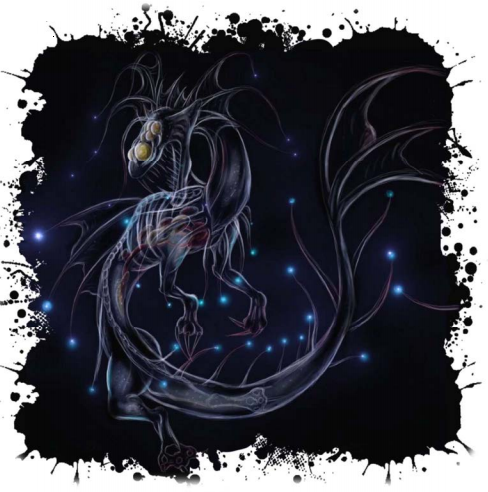
Byakko (CR 8 Large Animal)
This gelatinous ambush predator is named after the White Tiger of the West from Chinese mythology and astronomical symbolism. Why? Presumably because of their association with stars and tigers, as they are said to hunt and act similar to the tigers of the days before the Great Flood, have game mechanics that are basically "tiger with a swim speed" for the most part, and have the ability to dazzle foes for 1d4 rounds with a flash of internal light for that star connection.
Demon, Echenis (CR 13 Huge Outsider)
Big, nasty, and gluttonous, echenis demons resemble gelatinous tentacled fish. These monstrosities of the hellish realms are far more dangerous than what their bloated bodies and lazy attitudes would suggest. With at-will dispel magic , a tentacle attack that forces a Fortitude save to avoid taking 1d5 Wisdom damage and being under the effects of a confusion spell for 6d4 hours, a tail slap that inflicts poison that deals 2d4 Strength damage, and a special swallow attack that forces the swallowed victim to make a DC 26 Fortitude save or be transformed into dark purple crystal, echenis demons are primed to utterly wreck anyone without a high Constitution score, be they caster or martial character. They even add insult to injury by making cavern lairs into "art galleries" of their crystallized foes.
Demon, Minion of Saloth (CR 9 Large Outsider)
A more traditional demon, for what measure of traditional a giant lobster-man with tentacle hands can have, the minions of Saloth are rabid followers of their namesake goddess that specialize in brute force combat. While definitely far less terrifying than the echenis, the minion of Saloth does share that demon's penchant for dealing with both casters and fighters alike. Their jagged plate-like teeth tear at muscle tissue to deal 1d3 Strength damage on top of 1d8 standard bite damage, while their freakish tentacle-hands have a strangling grip that prevents speech or casting of verbal spells. They also have a +7 deflection bonus to Armor Class and spell resistance 27 on the defensive side. Their most hated enemies are deep drow that have turned away from the worship of Saloth, who they mercilessly torture rather than grant the grace of a quick death.
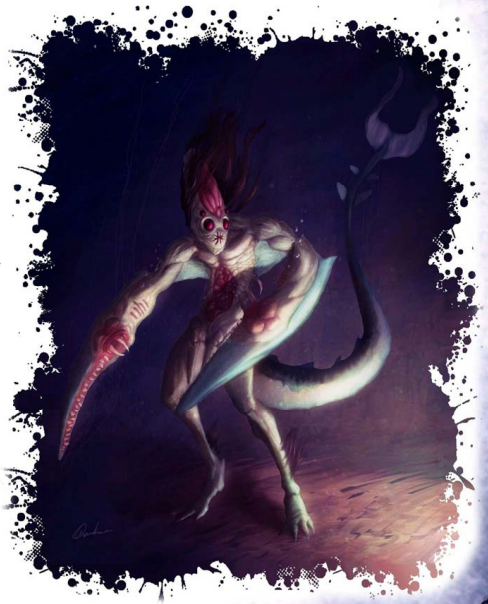
Devil, Crustaceamid (CR 11 Large Outsider)
The crustaceamids are the footsoldiers of the devils, crawling en masse through the see as ravenous armies. Like both of the demons, these crab devils are capable of dealing ability score damage: 1d4 Constitution damage against pinned foes due to sharp beaks that line their arms. They can also press a foe up against their gelatinous chests and stick them there with an adhesive gel, which also happens to double as an attack that deals 1d6 acid damage.
Dragon, Din (CR 9 Large to CR 20 Gargantuan Dragon)
A True Neutral song dragon, the din dragons resemble a hybrid of reptile and lobster, and loves nothing more than to be left alone. They ponder things slowly, move slowly, and generally take life at a casual pace. If they actually do get into combat, however, they are not to be trifled with. Their sonic breath weapon also shatters any material as hard as stone or weaker, potentially collapsing ceilings or walls upon foes, and they can siphon HP from bioluminescent foes. Oh, and they can animate their own shed exoskeletons to act as living constructs. That's certainly unique, to say the least.
Drake, Scavenger (CR 3 Small Dragon)
When you're described as being "the seagulls of the deep", you know you're obnoxious. And indeed, the scavenger drake's goal is to be very obnoxious. These rather sickly-looking multi-limbed drakes harass larger creatures in order to steal their food or interesting-looking trinkets, and can speak just enough Dagonite (the Common of the deep) to know how to swear and insult people. Their tails have a minor paralytic toxin that paralyzes foes for 1d4 rounds, and they can also vomit balls of stomach acid that deal 1d6 damage.
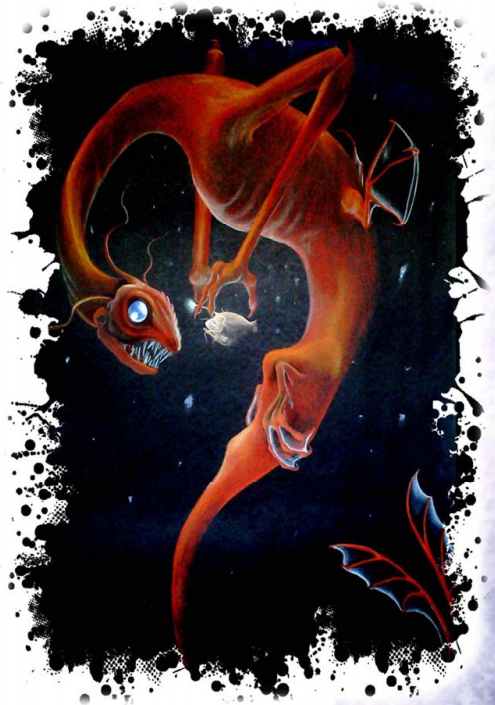
Goggayya (CR 2 Medium Monstrous Humanoid)
The goggayya are your standard "Rogue in creature form" Chaotic Evil monsters. They sneak, they snatch, they torture, and they do it all because they find misery to be amusing. Unsurprisingly, they worship Kaydolas, who they claim is a giant goggayya.
Grandfather Worm (CR 5 Medium Aberration)
Gelatinous translucent worms with large eyes and tentacle-beards, the grandfather worms are effectively mercenary scholars, sharing knowledge for whoever can do the best favors for them. While they are True Neutral and hesitant to use their level 9 Sorcerer spells or burning tentacles against others, they were once a race of powerful conquerors when they and a handful of other invertebrate races were the only intelligent life to have yet evolved.
Hagfish, Giant (CR 1 Medium Animal) and Swarm (CR 2 Tiny Animal Swarm)
Hagfish are pretty great. They're dorky-looking eel-like fish with silly tentacle mouths and lots of slime. They gather in large numbers when whale carcasses hit the sea floor. Support your local hagfish today.
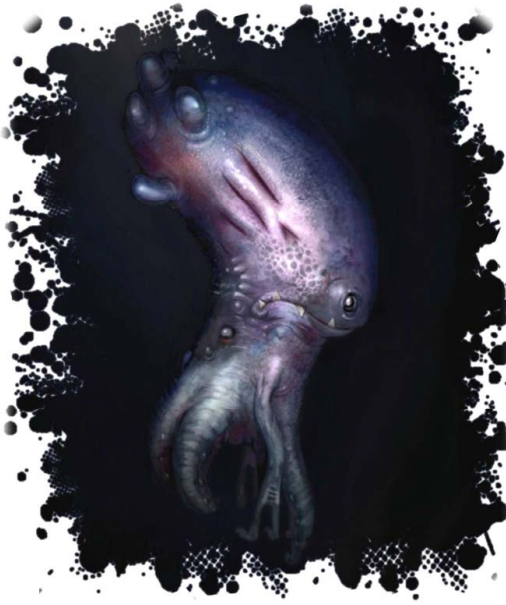
Imp, Squid (CR 1/3 Tiny Aberration)
Nobody's quite sure what the deal is with the squid imps. Even the grandfather worms and the zef, the two oldest races with continued records, aren't sure where they came from or what their purpose is. They're definitely not evil, but they can easily get underfoot, given that their main goal in life is to mime other intelligent creatures. They'll even go into combat alongside heroic characters, which tends to end badly for the squid imps given they are squishy little jelly things which have weak poison with a mere DC 10 Fortitude save and a 1 damage tentacle slap as their only means of offense and have a grand total of 4 HP to survive on.
Jellyfish, Death Shell (CR 14 Huge Vermin)
Weird jellyfish that dwell in spiny shells. In addition to being highly venomous, their bioluminescent organs create strange effects. These "sick lights" can either deal 1d6 Strength damage, 1d6 Dexterity damage, replicate the confusion spell, or deal 3d8 damage and nauseate the target if they live past the damage.
Jupervas (CR 23 Colossal Magical Beast)
The jupervas is a massive whale-like fish that is effectively a death sentence for most settlements when it appears. Like many primordial monsters, jupervas sleep for decades or even centuries before briefly awakening to feed, engulfing all edible matter with massive inhalations. It is also capable of unleashing a "bloop" (a reference to the mysterious undersea noise that turned out to be a quake within an iceberg, AKA an icequake) that deals 20d6 points of sonic damage in the immediate radius of the bloop that loses one die of damage every 10 feet away from the jupervas it goes. It also happens to be immune to all the stuff that the tarrasque is traditionally immune to. What ever could this mean?
Obitu Source-Mind (CR 9 Medium Plant)
These are the giant intelligent brain corals that create the obitu. Yes, corals aren't plants, but neither are fungi and they tend to be put in the Plant creature type, so whatever. Oddly enough, their intelligence was always a thing, but the ability to create obitu was the result of the obitu virus infecting these brain corals after they fell into the abyss. Source-minds are always Neutral Evil, so in spite of the will of the obitu that have come from them, they themselves are always slavery-loving curmudgeons that use their ability to cast cloud mind and control body at will, as well as a 4-saves-or-die aura that creates new obitu from bones that are psychically ripped out of their foes' bodies, to keep an entourage of slaves for whatever nefarious schemes they are thinking up.
Occylathan (CR 12 Huge Aberration)
Alas, one of the many members of the “is it an Aberration that has squid features? If so, it's Evil” club. They utilize hypnotizing bioluminescent stalks to attract prey right to their waiting beaks. While this seems like a rather wasteful use of a 14 Intelligence score, it's implied that they only pretend to be unambitious ambush predators and their true power is used to puppeteer entire cities in the deepest parts of the abyss.
Phantasmal Frogfish (CR 7 Large Magical Beast)
Frogfish are already pretty weird creatures in real life. These fantasy versions take that weirdness up a notch by having them be cow-sized magical predators with actual hands rather than superficially hand-like fins, capable of casting various illusions such as false sounds and phantasms of various fish species to trick prey. They're also braggarts and spies, often sharing confidential information they come across simply because it makes them look more clever.
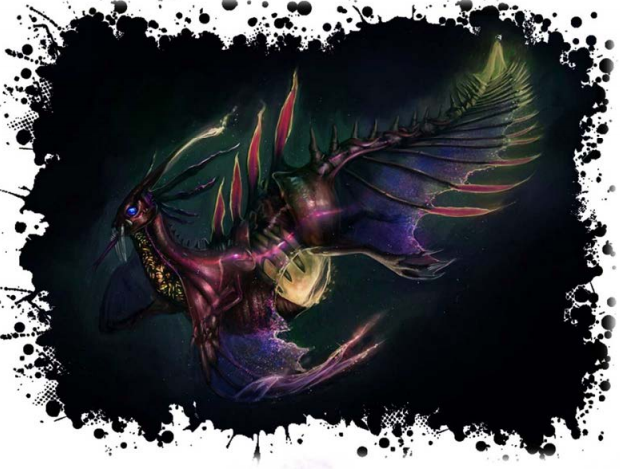
Phoenix, Abyssal (CR 15 Gargantuan Magical Beast)
Truly the most majestic phoenix to have ever existed. These paragons of all that is light and good in a world of darkness are actually the same creatures as the birds of traditional lore- when the Great Flood threatened the world, they prayed to the gods to let them continue their quest to fight the forces of evil and committed collective ritual suicide as the world drowned. Luckily, the gods actually did listen to their plea, and the phoenixes were reborn in these aquatic forms. And the abyssal phoenixes certainly do have some vibrant tools: they are able to make a breath weapon that replicates prismatic spray every 1d4 rounds, a constant 50 foot aura that replicates color spray , and have an intense grapple attack that deals 4d6 electricity damage and forces a Fortitude save to avoid being blinded for 24 hours.
Plumed Serpent (CR 9 Huge Magical Beast)
While the name implies a creature akin to the couatl, or at the very least some Aztec theming, the plumed serpent is just a small sea serpent that has a plume of bioluminescent quills. It can deal a 6d6 electricity damage blast to all targets within 50 feet that are within 10 feet of each other (effectively an arcing attack rather than a radius attack) once per day, and its stomach deals steam damage rather than acid damage to swallowed foes due to a superheated gullet.
Sinkfish (CR 6 Large Magical Beast)
These creatures have the body of an eel, crab legs along their length, and a head like an anglerfish. While they are yet another ambush predator of the depths, they do have two rather unique forms of attack. One is the ability to create buoyancy-decreasing bubbles – hence the name sinkfish, actually – while the other is a special bioluminescent light show that can cause seizures in its foes. Yes, seizures. Any foe within 10 feet of the sinkfish has to make a Will save each round (DC 17 for most people, but DC 21 for spellcasters or psions) or take 1d4 Intelligence damage and be sickened. I'm not a neurological expert or anything, but wouldn't paralysis be more appropriate for replicating seizures?
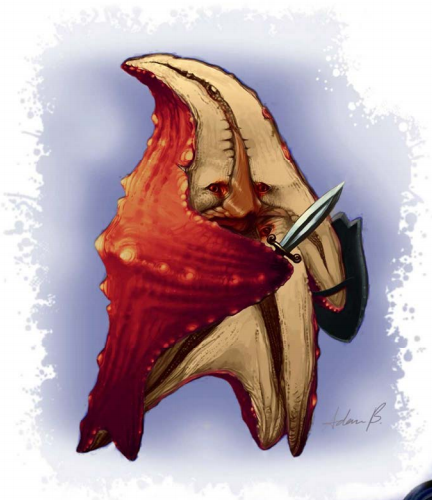
Trueform, Estrel (CR 1 Small Magical Beast)
Awakened starfish that are particularly religious and tend to lead tribes of echinn. They're not actually that interesting, beyond their ability to split into two separate estrels that share class levels. Since they're starfish and all, of course.
Oculus, Vigilus (CR 8 Large Aberration) and Vilicus (CR 5 Medium Aberration)
The two larger forms of oculus. These are specifically “cultivated” specimens, reared from birth for their roles, and a note below their stat blocks states that a viden player character who becomes a vilicus/vigilus through taking metamorphosis feats will not be quite as strong even though they are technically the same. In addition to being larger, stronger, and generally more powerful than the viden life stage, each of the two other oculus life stages have an altered version of the viden's acidic tears and a new eye-based ability. The vilicus can spew its acidic tears into an adjacent square and have the ability to reroll Perception checks a number of times per day equal to its Wisdom modifier, while the vigilus has a 10 foot cone eye blast for its acid tears and gains an instant +2 bonus to Armor Class, all three saving throws, or attack and damage rolls (its choice) each round due to constant minor divination.
Viperfish, Dire (CR 4 Large Animal)
A giant version of the viperfish , of course. Its main unique trait is that its stomach holds contents like a Gargantuan creature normally would, meaning that it can swallow enemies up to size Huge whole. I'm not sure how often that would ever come up unless the players have some manner of sea creature mount or something, but it's admittedly fitting for the creature it replicates and gives it a trait that makes it unique compared to having just another giant ambush fish.
Final Thoughts
Azure Abyss manages to (perhaps unintentionally) continue the Cerulean Seas sourcebook trend from Indigo Ice of harsh environments being ruled by harsh characters, while the heroes are most likely paragons of virtue that are the odd ones out. For Indigo Ice, this was reflected by hostile barbarian cultures and prejudiced but Neutral regimes dominating the arctic landscapes, while in Azure Abyss there are Evil civilizations that band together and tolerate Neutral or even Good outsiders and allies out of pragmatism in an unforgiving underwater wasteland. It's not exactly ground-breaking or anything, but it's always interesting to see a setting have a piece of itself where it steps out of its primary conceits, in this case Cerulean Seas figuratively and literally going for a darker take on itself.
Mechanics-wise, I'd say that Azure Abyss manages to edge out Indigo Ice for fresh Pathfinder material. A glut of racial feats over general feats, everything about the Halionaut, the Seductor being a way to have unlimited mind control shenanigans if you choose to prioritize Strength alongside Charisma, and a mostly uninspired bestiary heavily dominated by creatures that fit the mold of “mind-controlling ambush predator” are its greatest flaws. By contrast, the new playable races (other than the aquatic dwarves) properly evoke that feeling of strangeness and cold pragmatism of the abyss, the Angler is a good class with interesting ideas even if it doesn't entirely match up with its intended role, and the Myxinmave has a lot more heart to it than most prestige classes I've seen. Even better is that a lot of the material could be transported to shallower waters without too much effort. If you are using with Pathfinder and have an aquatic-themed campaign, I can't see any reason why you wouldn't benefit from having Azure Abyss in your collection.
Next Time
The Cerulean Seas train is going to be derailed. With the release of yet another sourcebook for the setting, I realized that powering through them without giving myself breathing room for anything else was a dumb idea. Most – but not all, mind you – of what I have planned on covering sooner rather than later will be d20-based in some capacity, if not Pathfinder, because I'm that loser who knows d20 systems best and unironically likes them.

Coming up first will be a fun law school lesson. It's a tale of the great license-based d20 boom of the 2000s, the interaction of two big name video game companies and one not so big name roleplaying game company, the intangibility of licensing, and just how much you can get away with barely altering the already written materials of a product bared around a license you've lost the rights to use.
Spoilers: the answer is a lot.